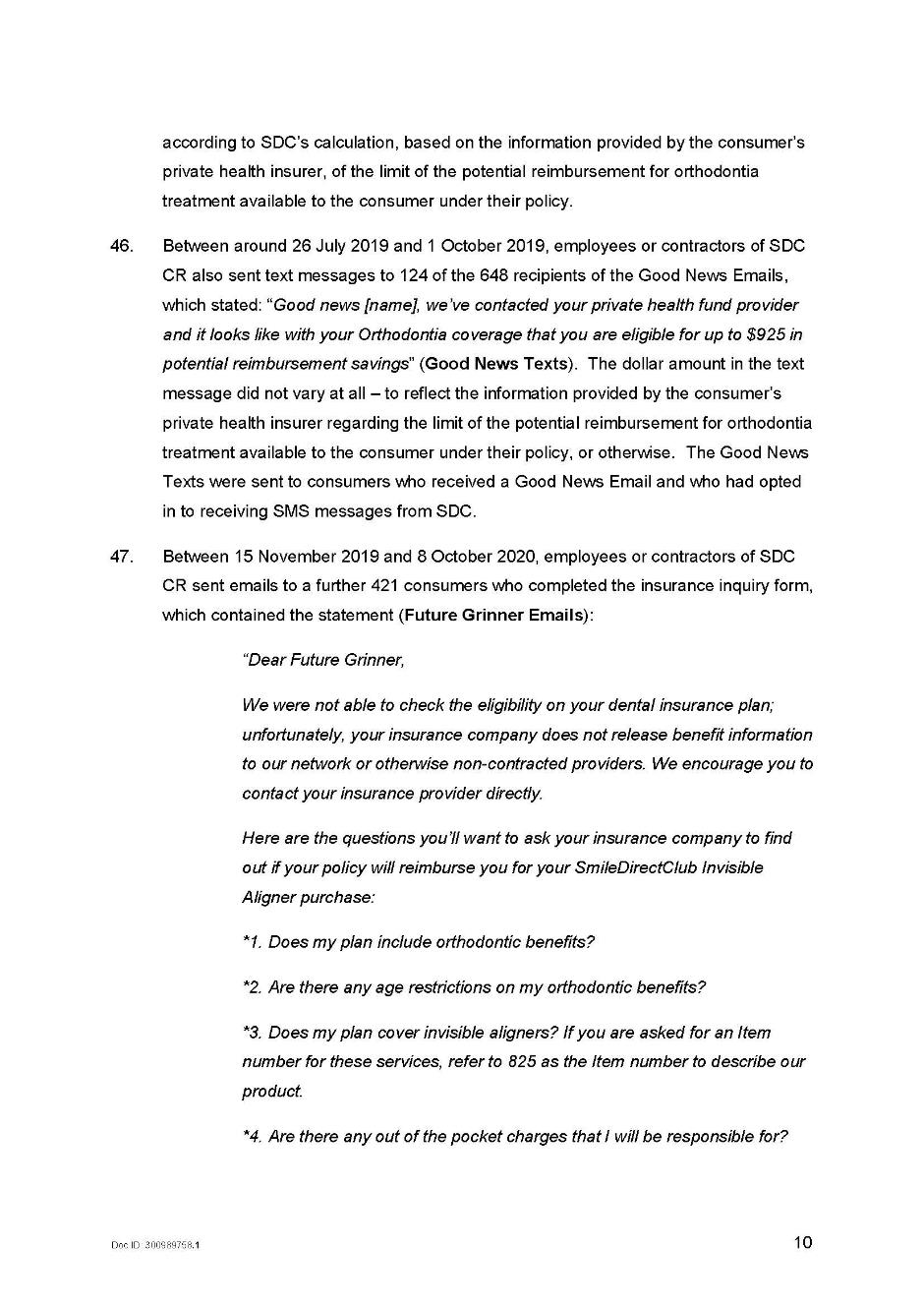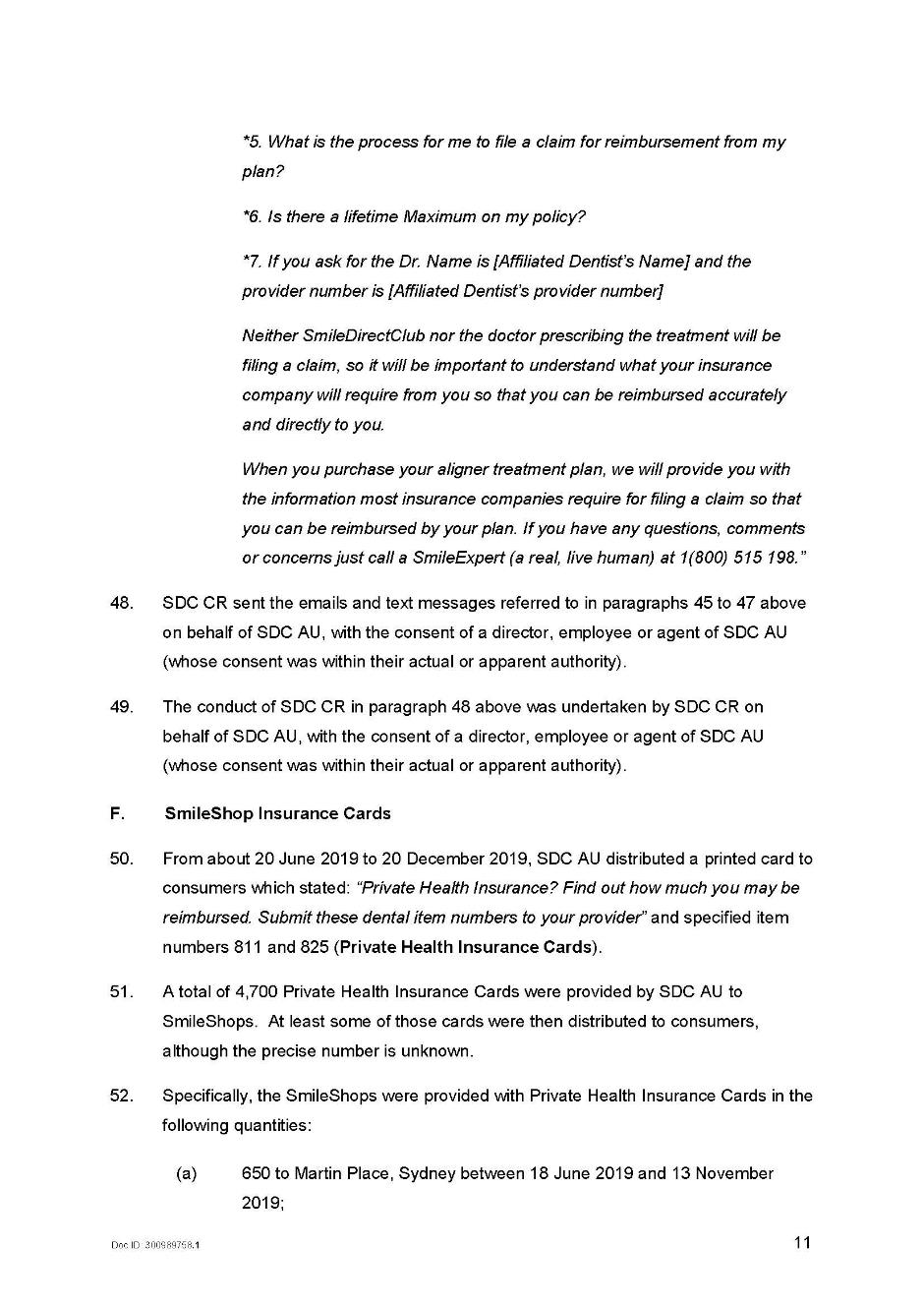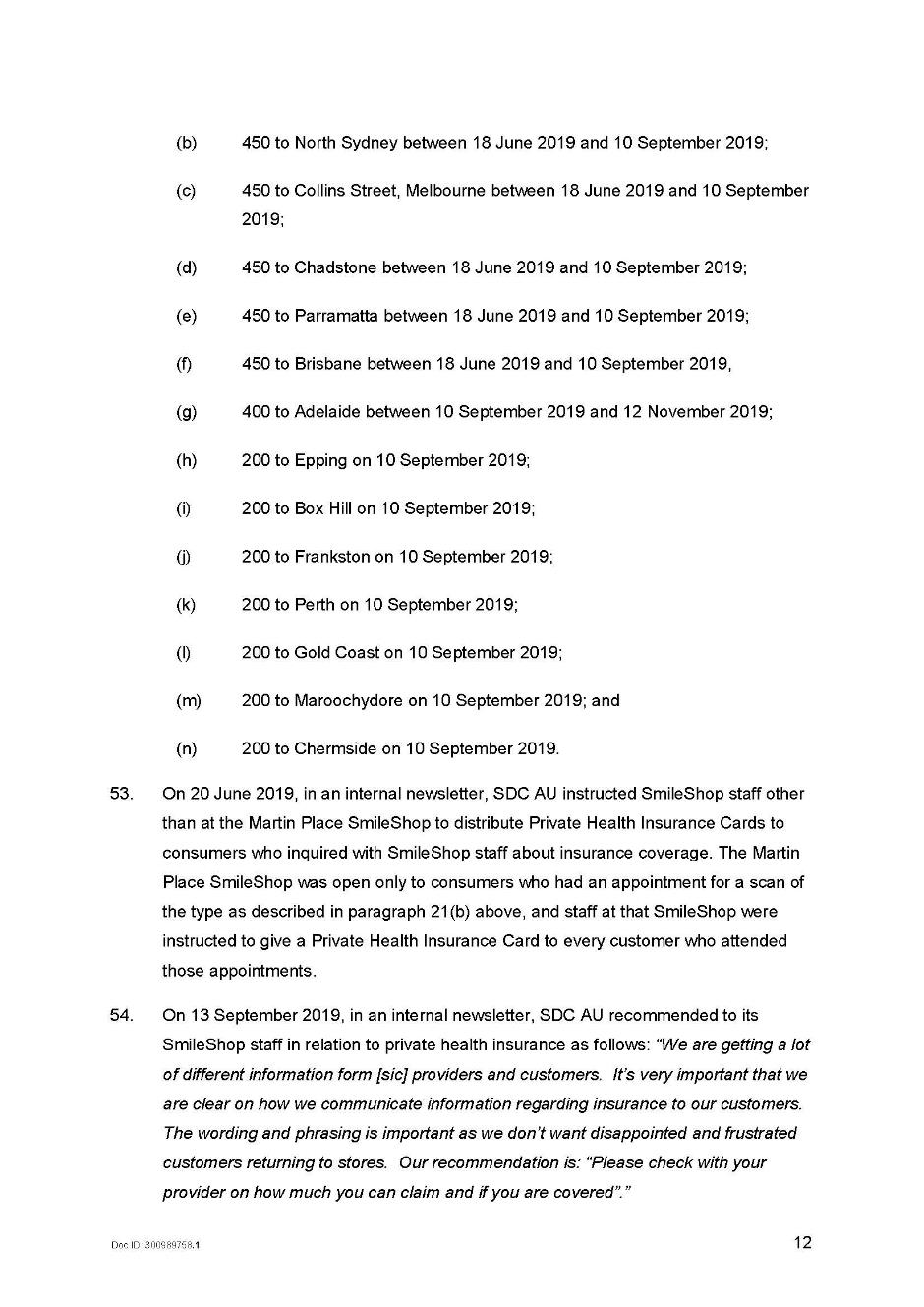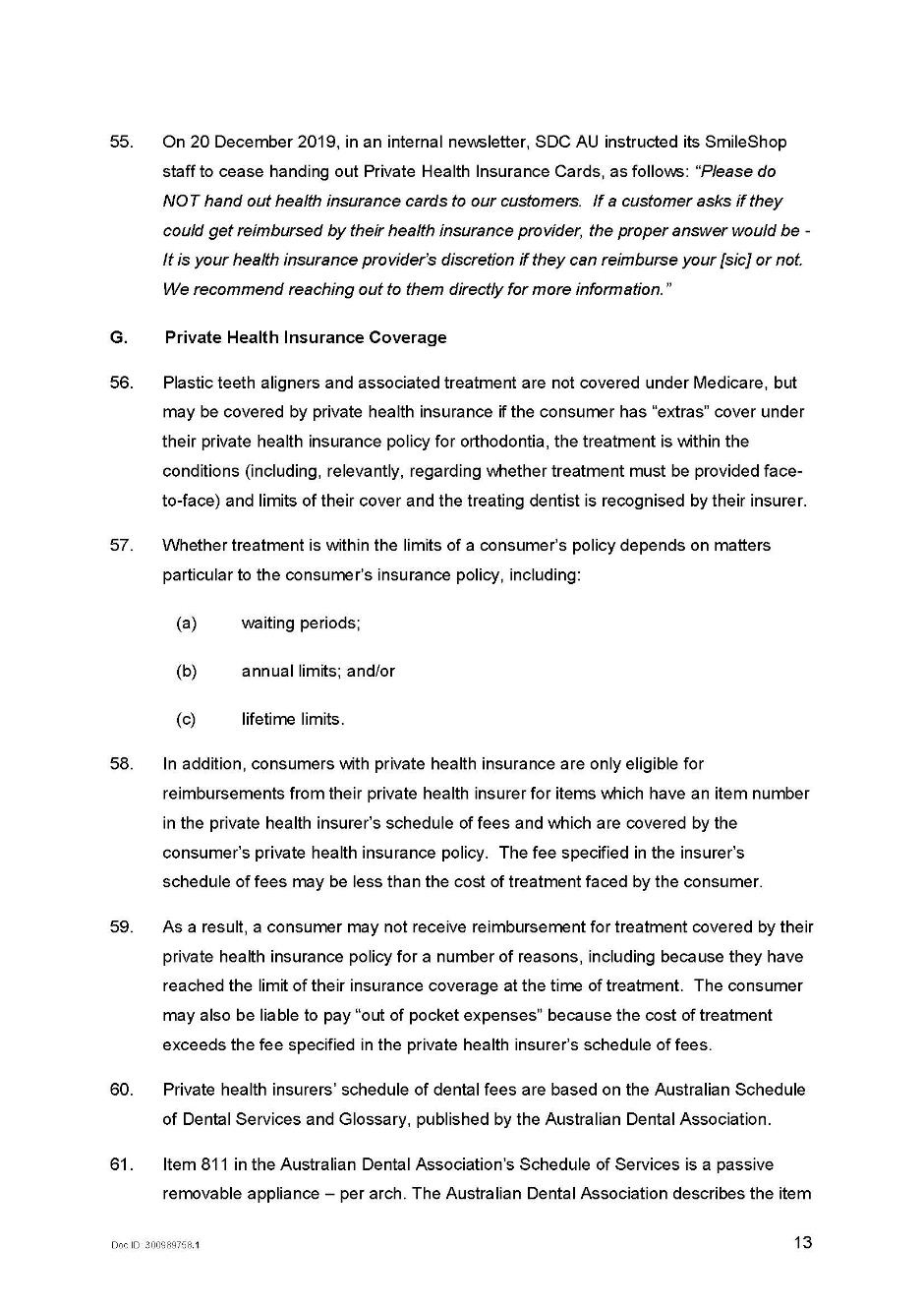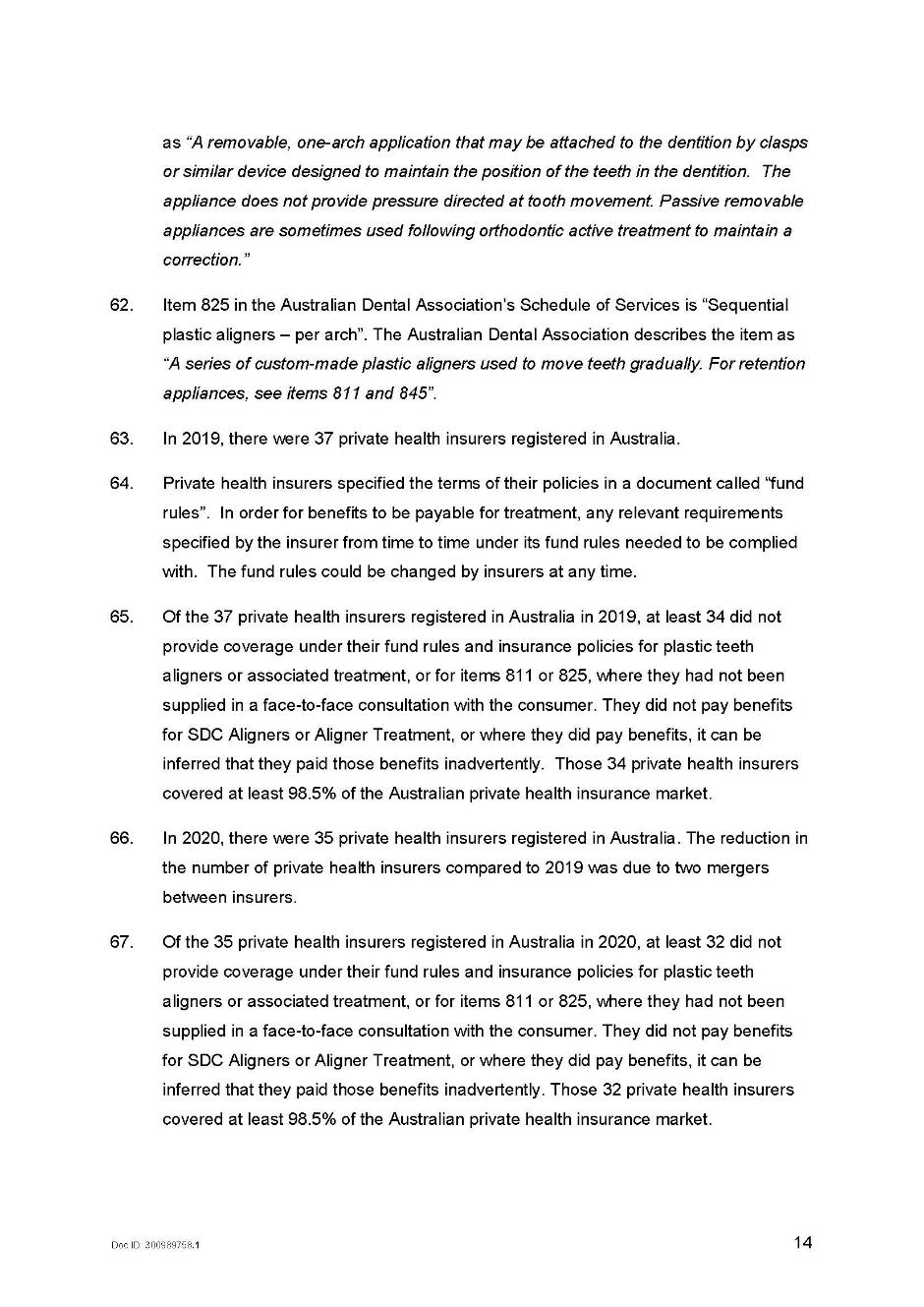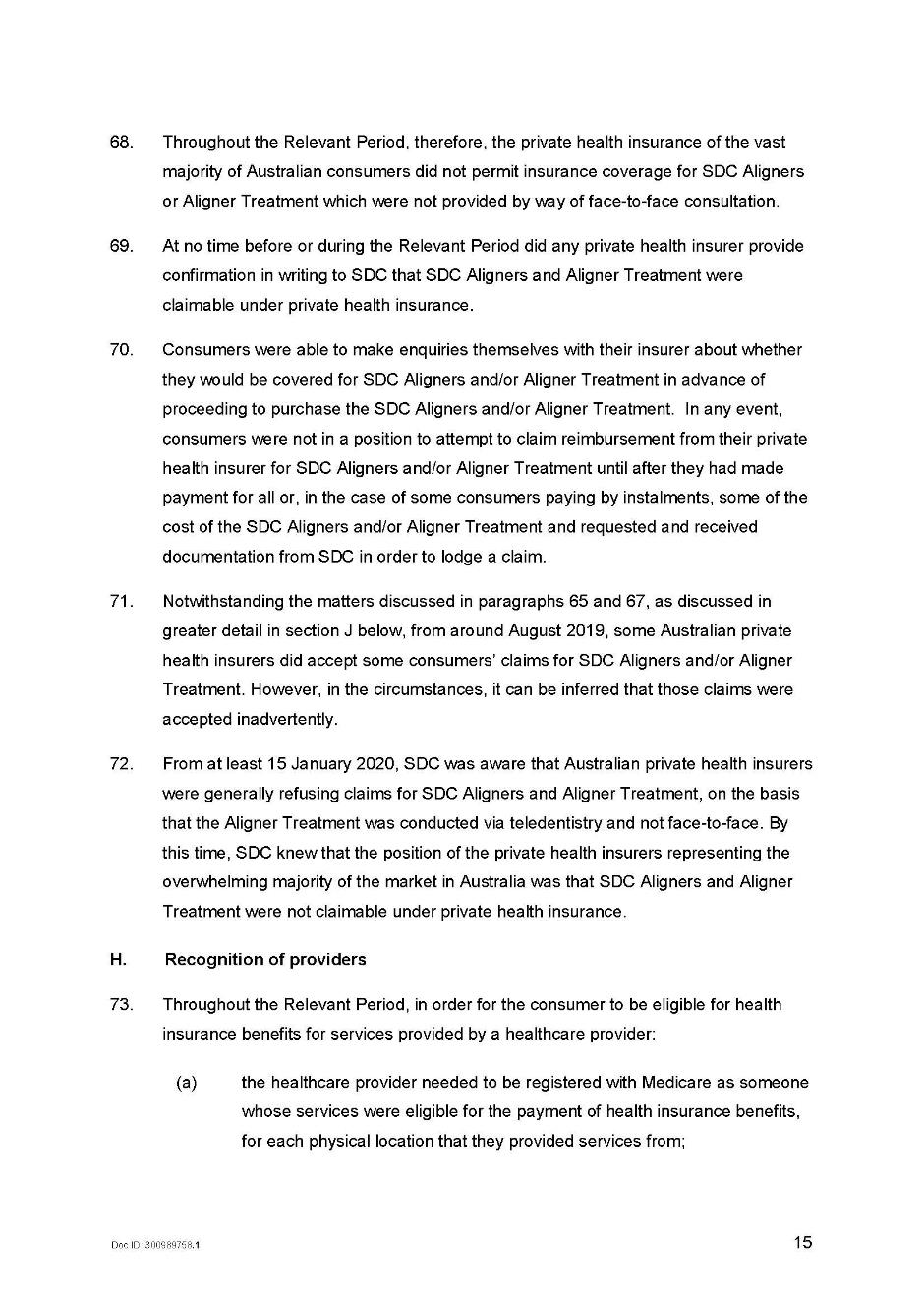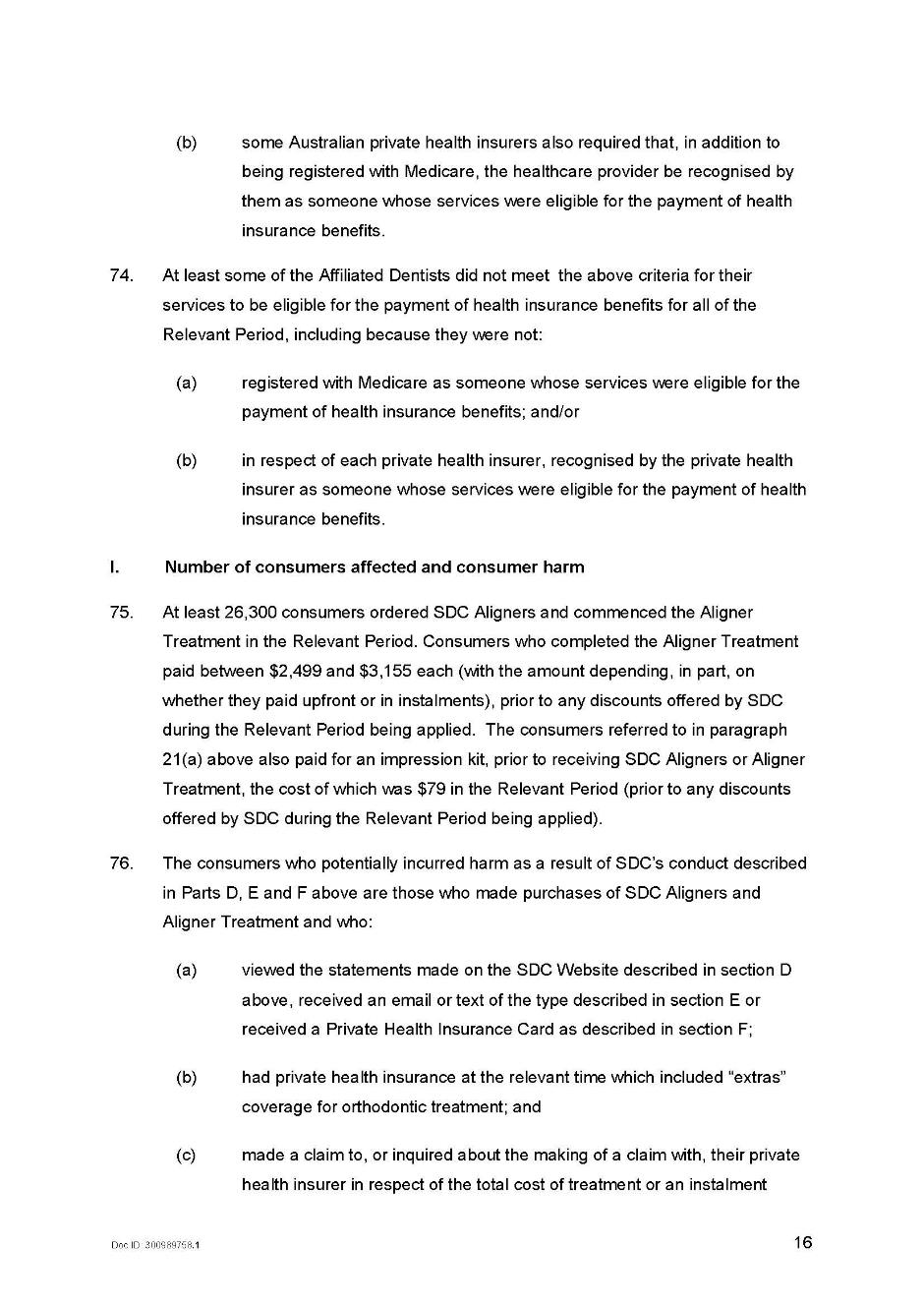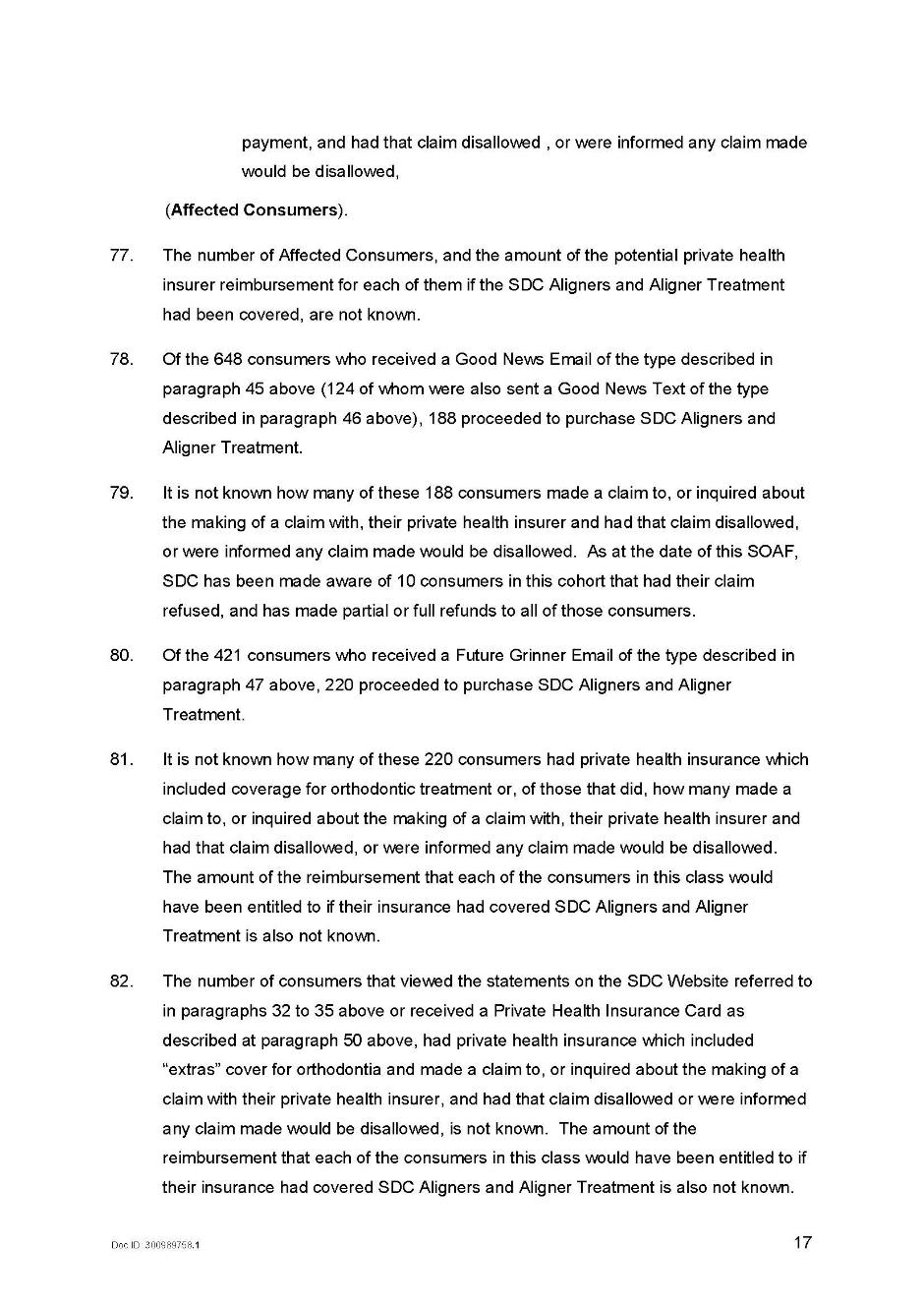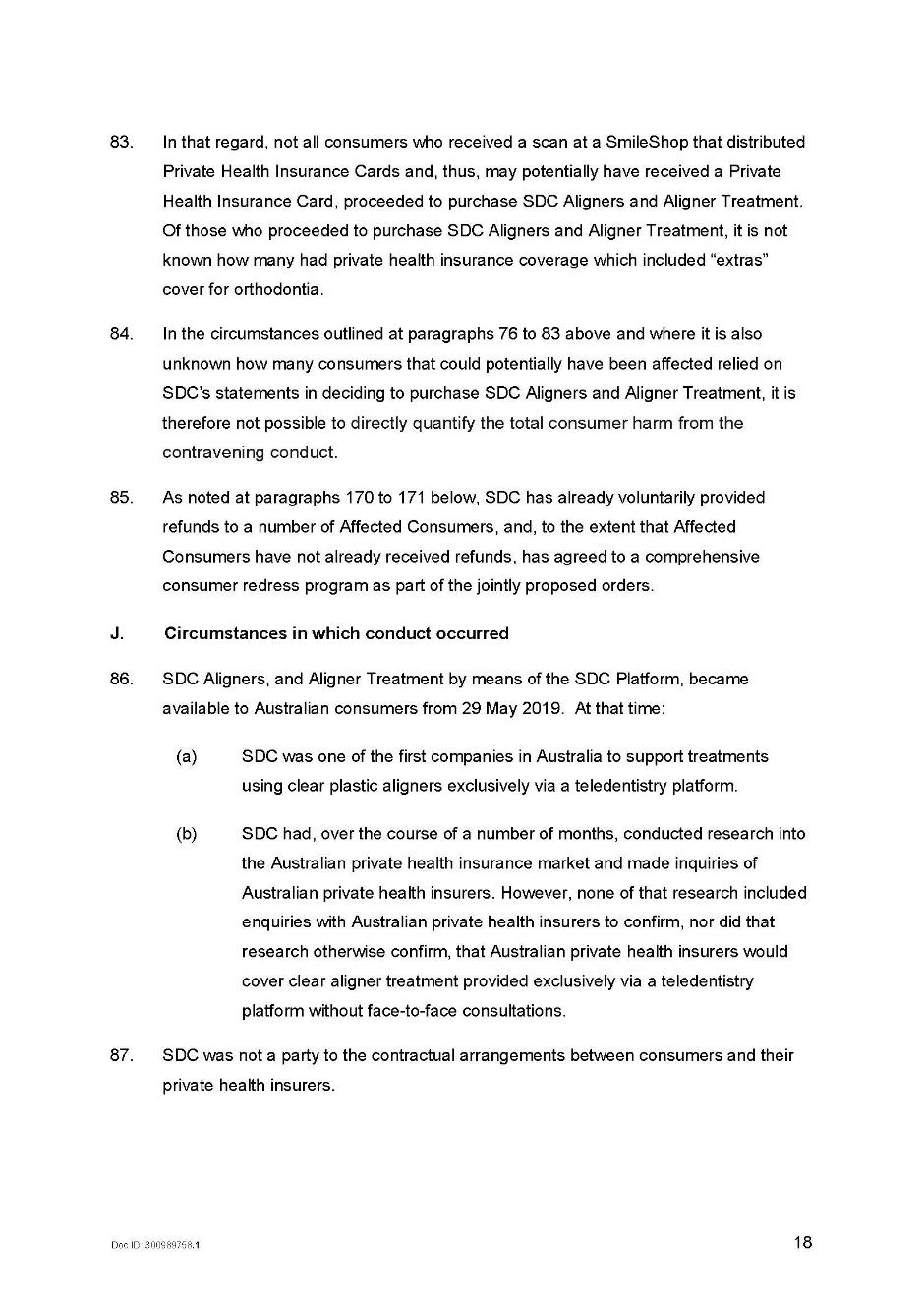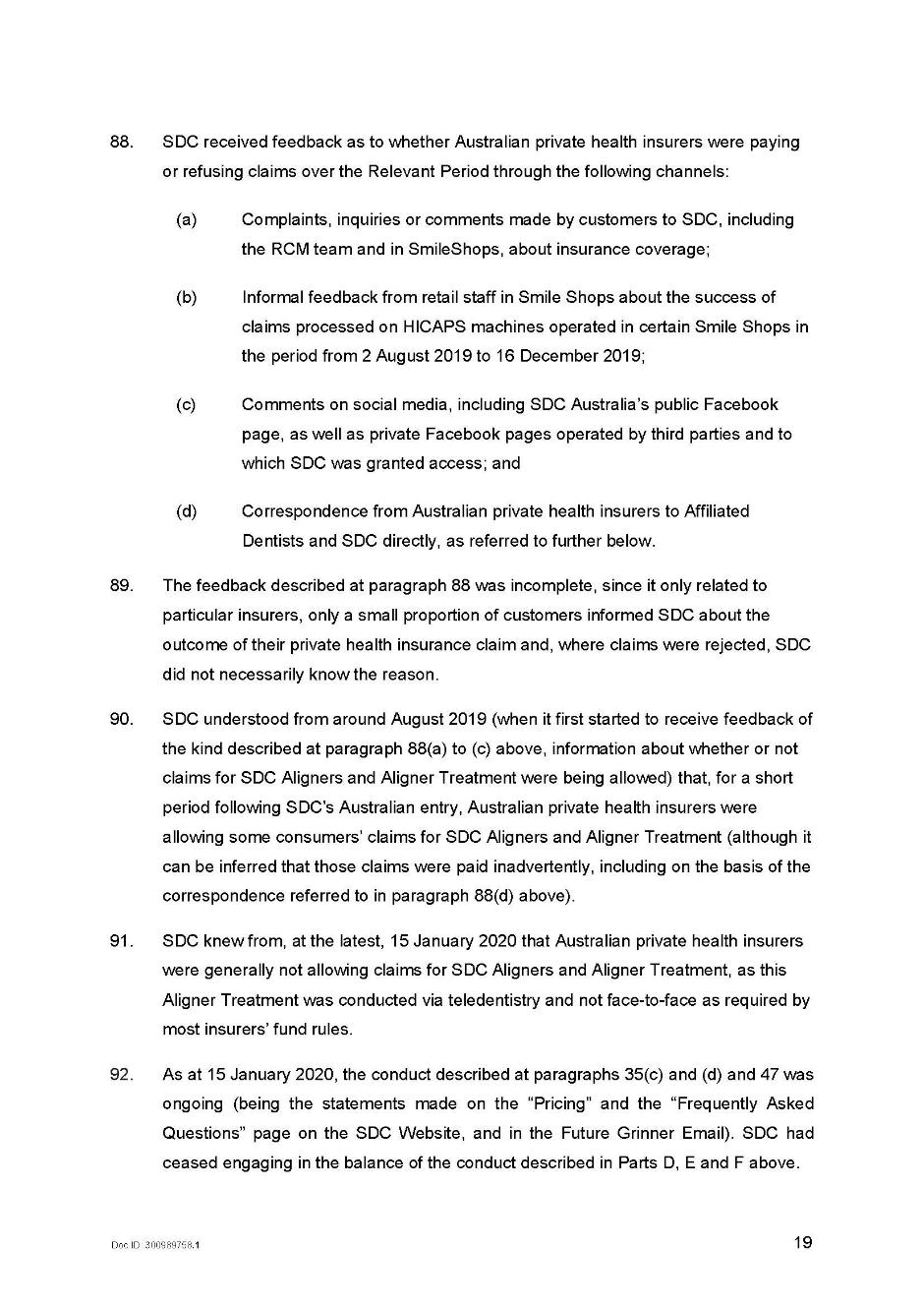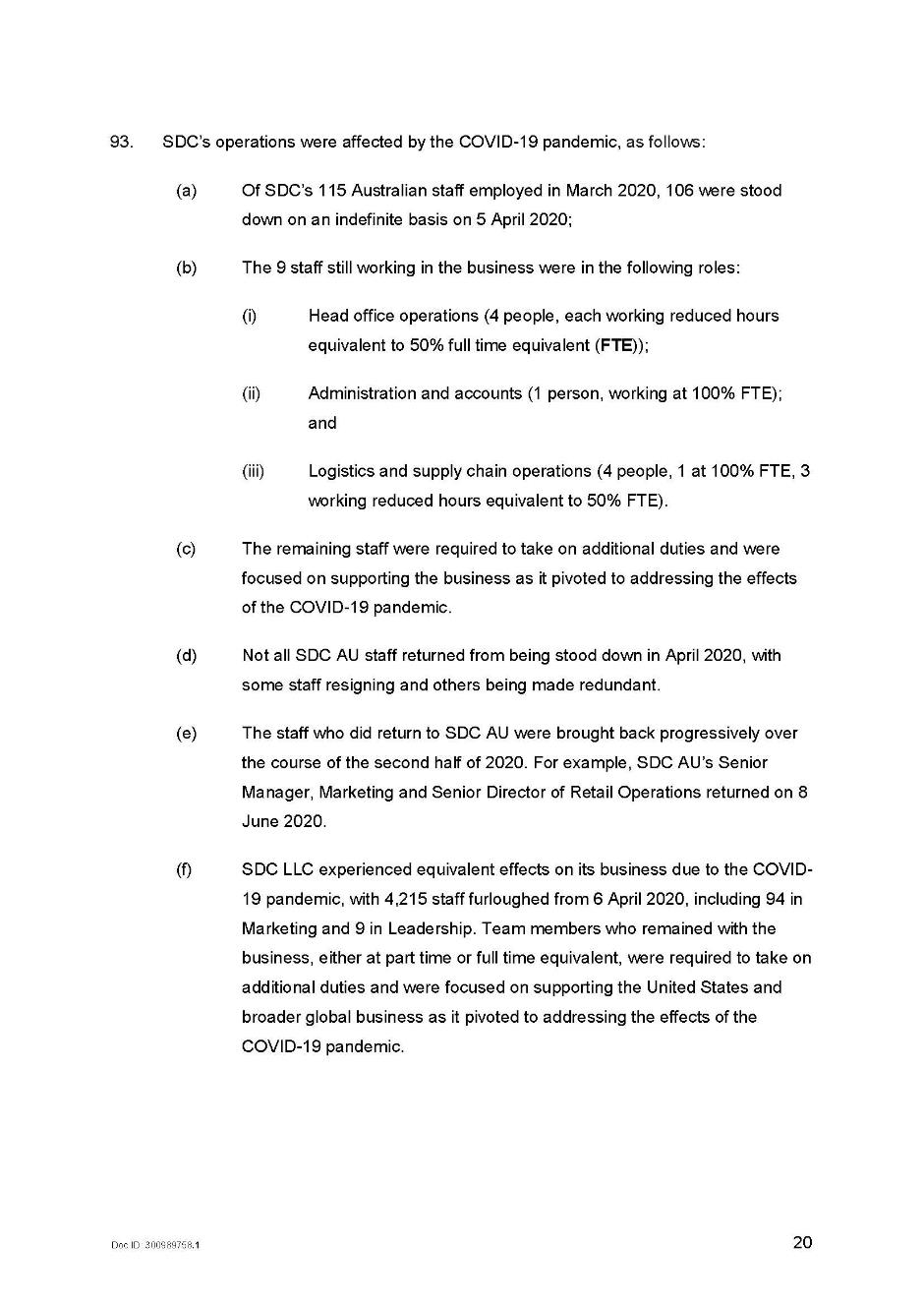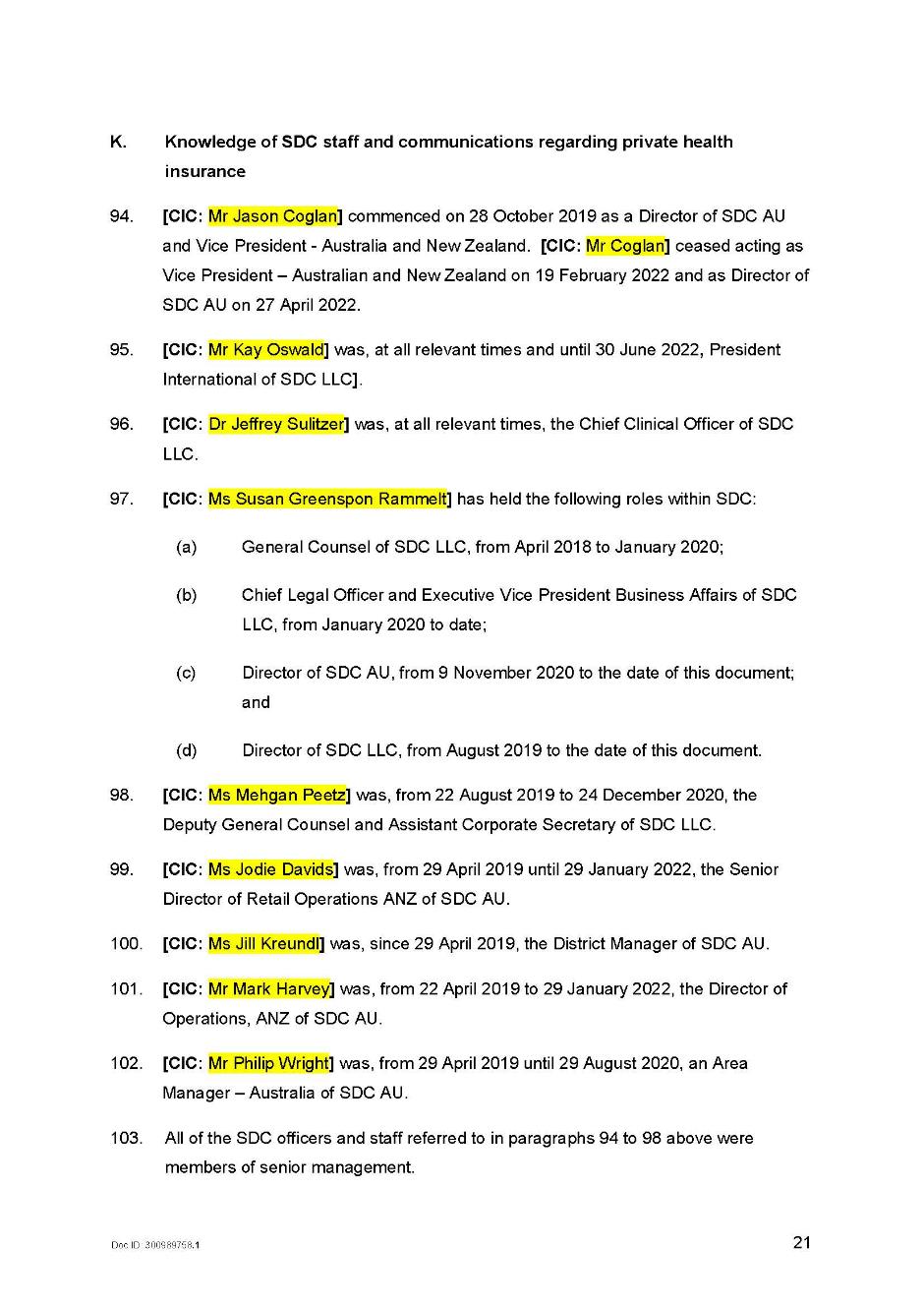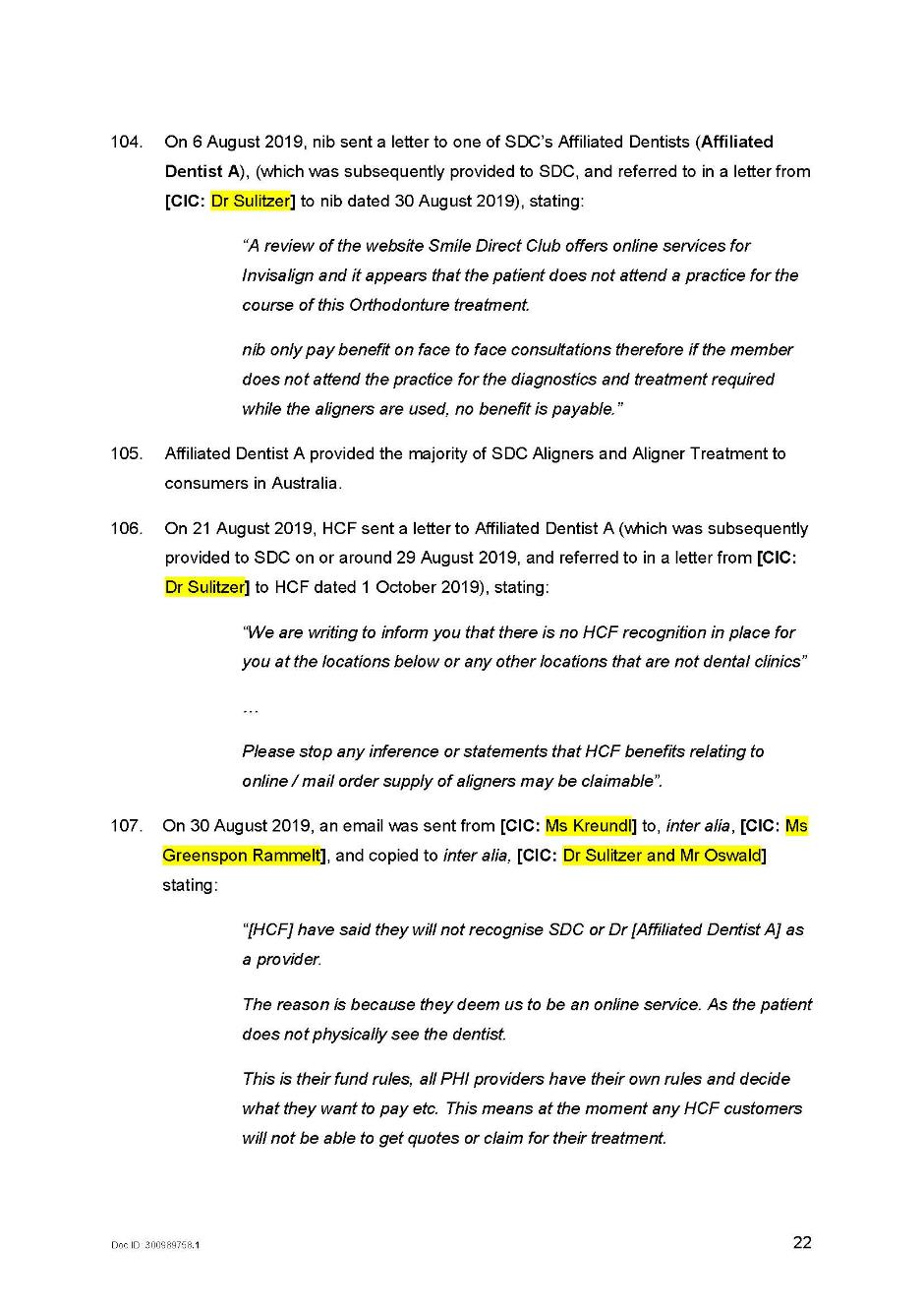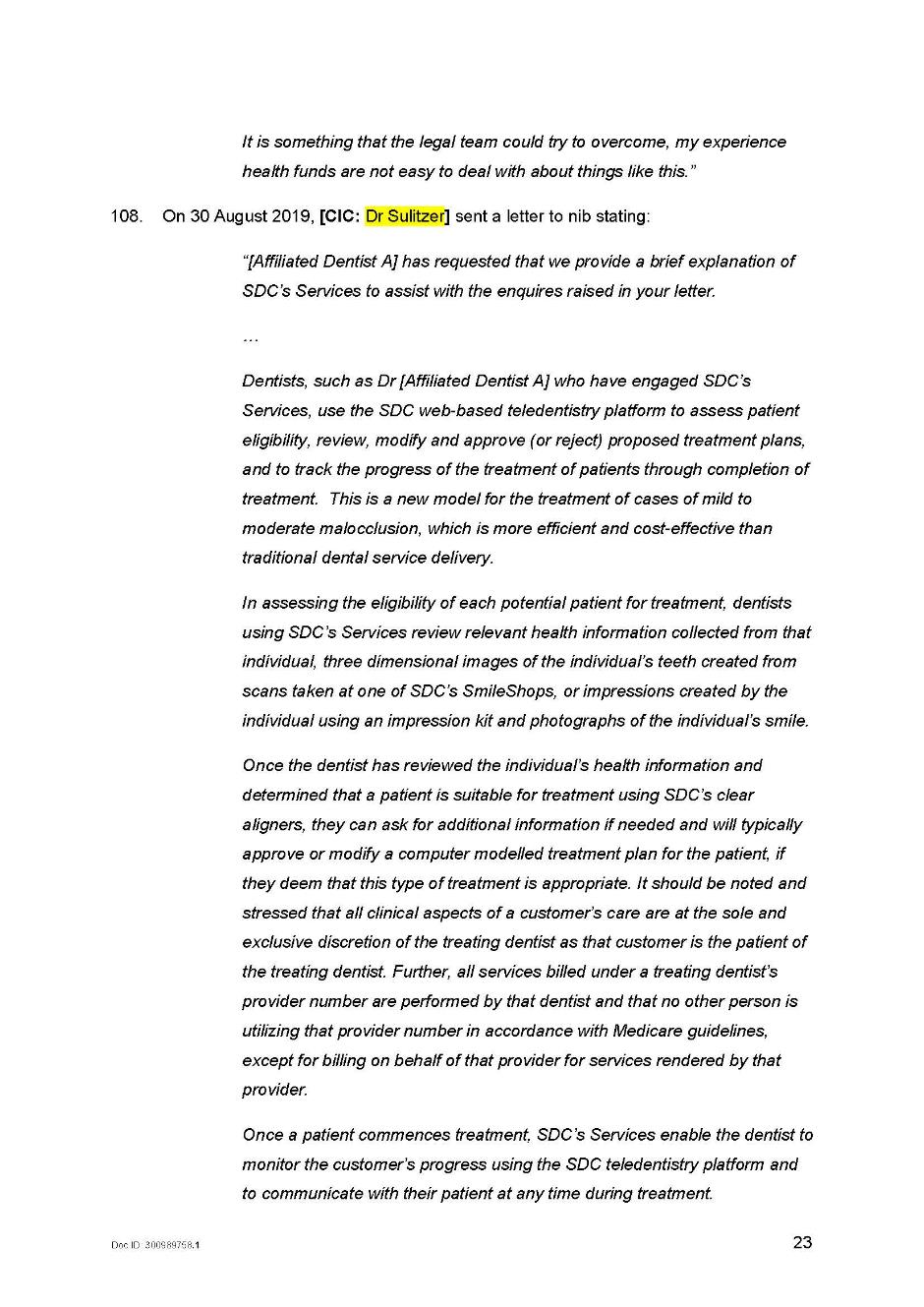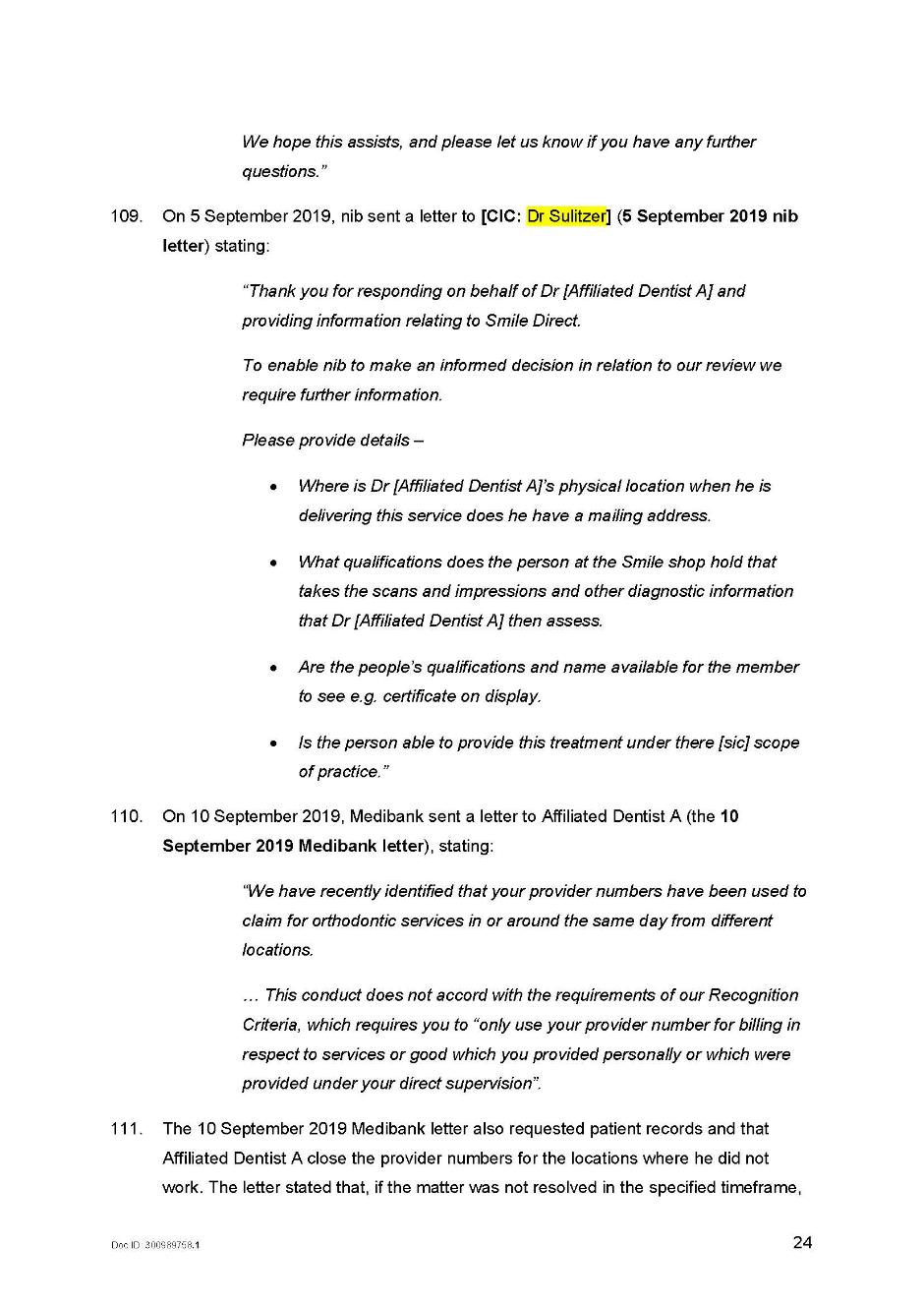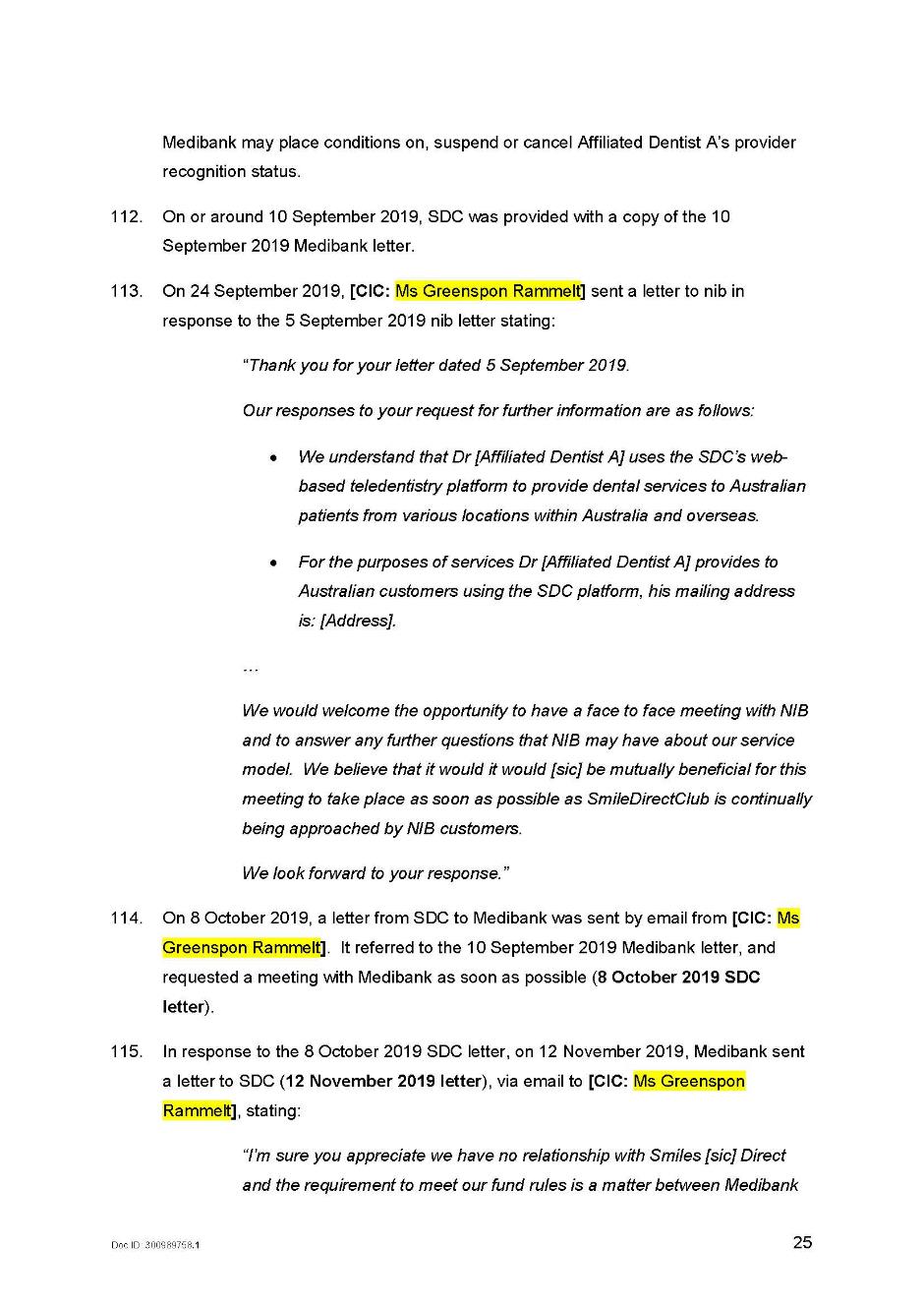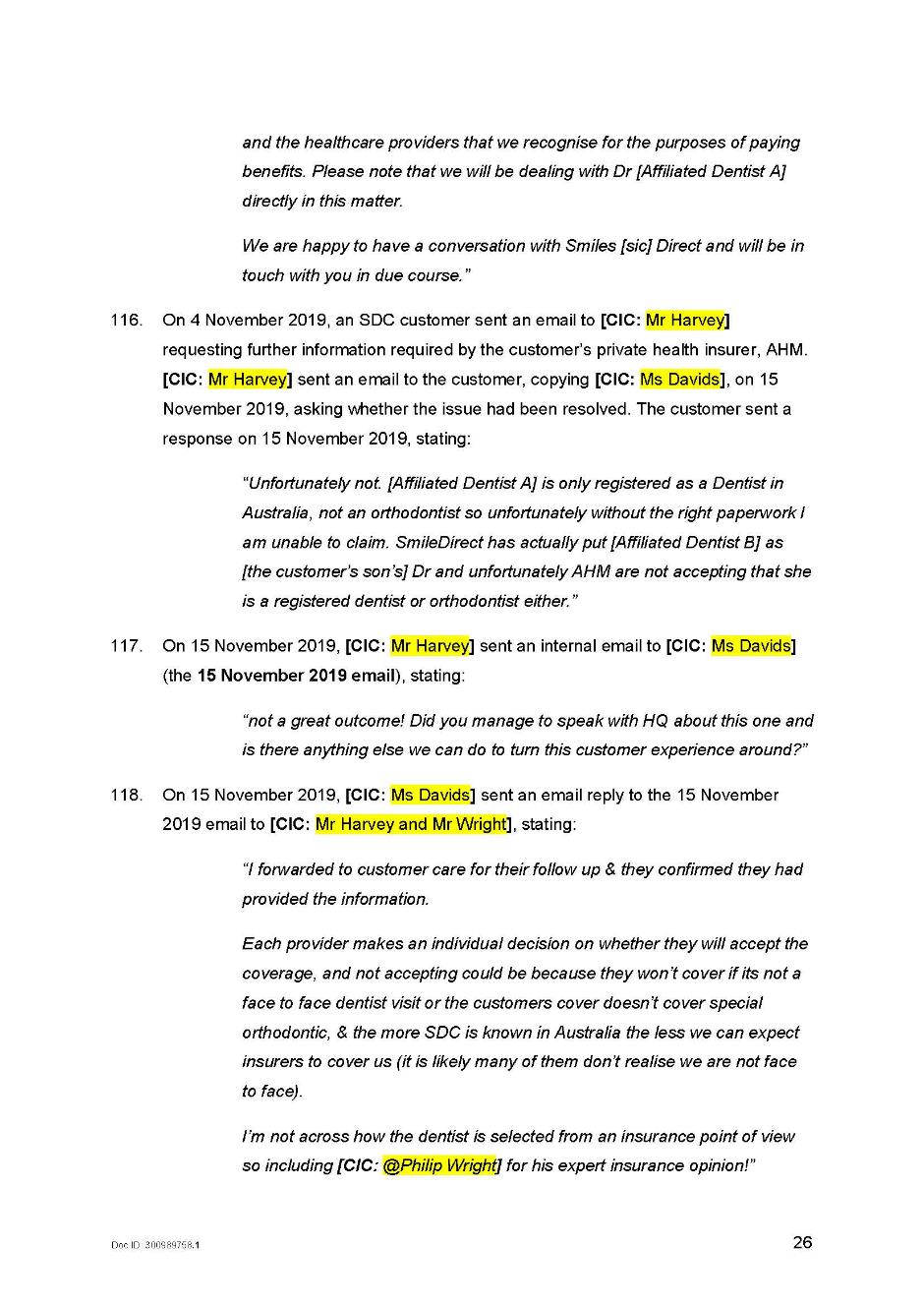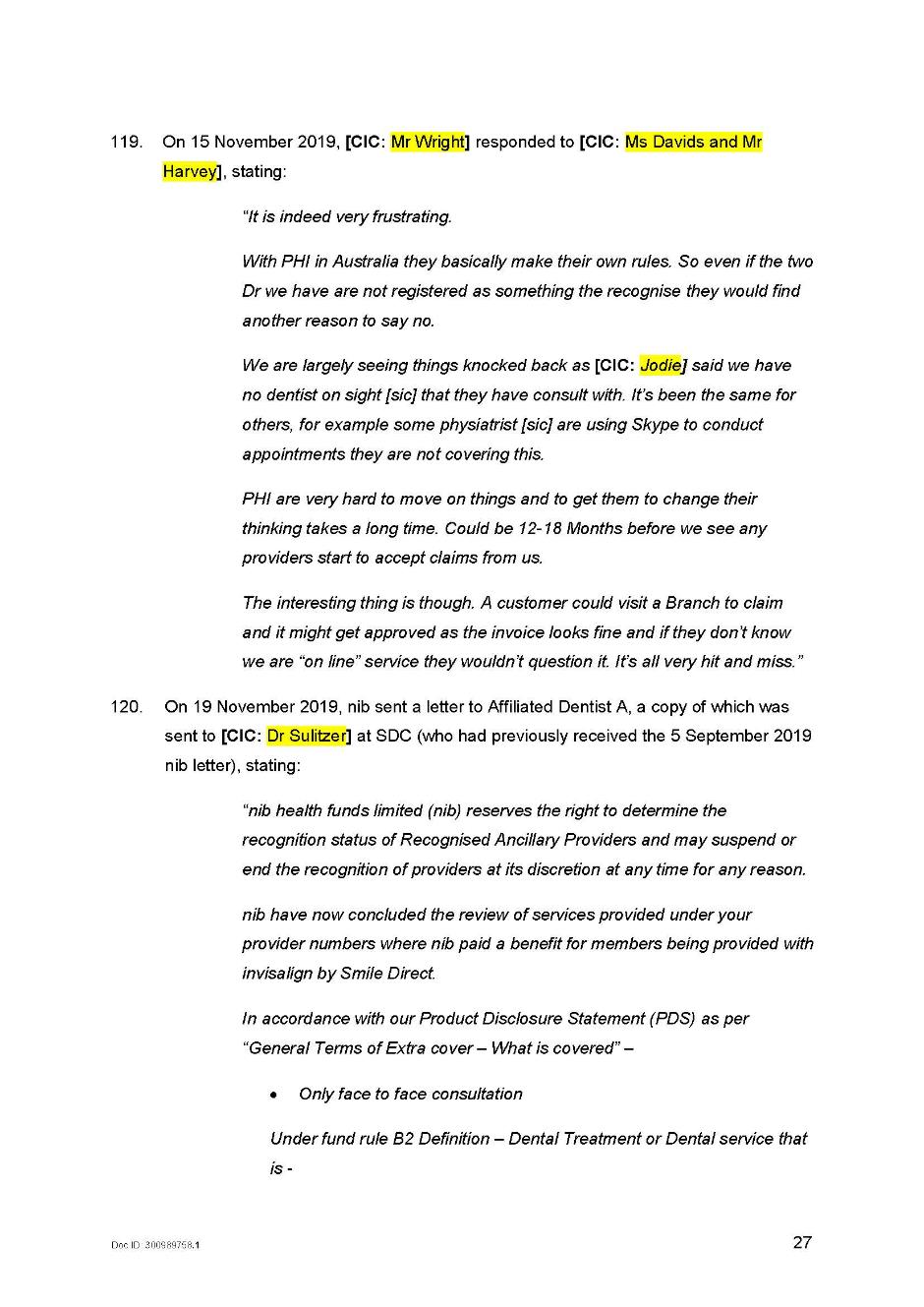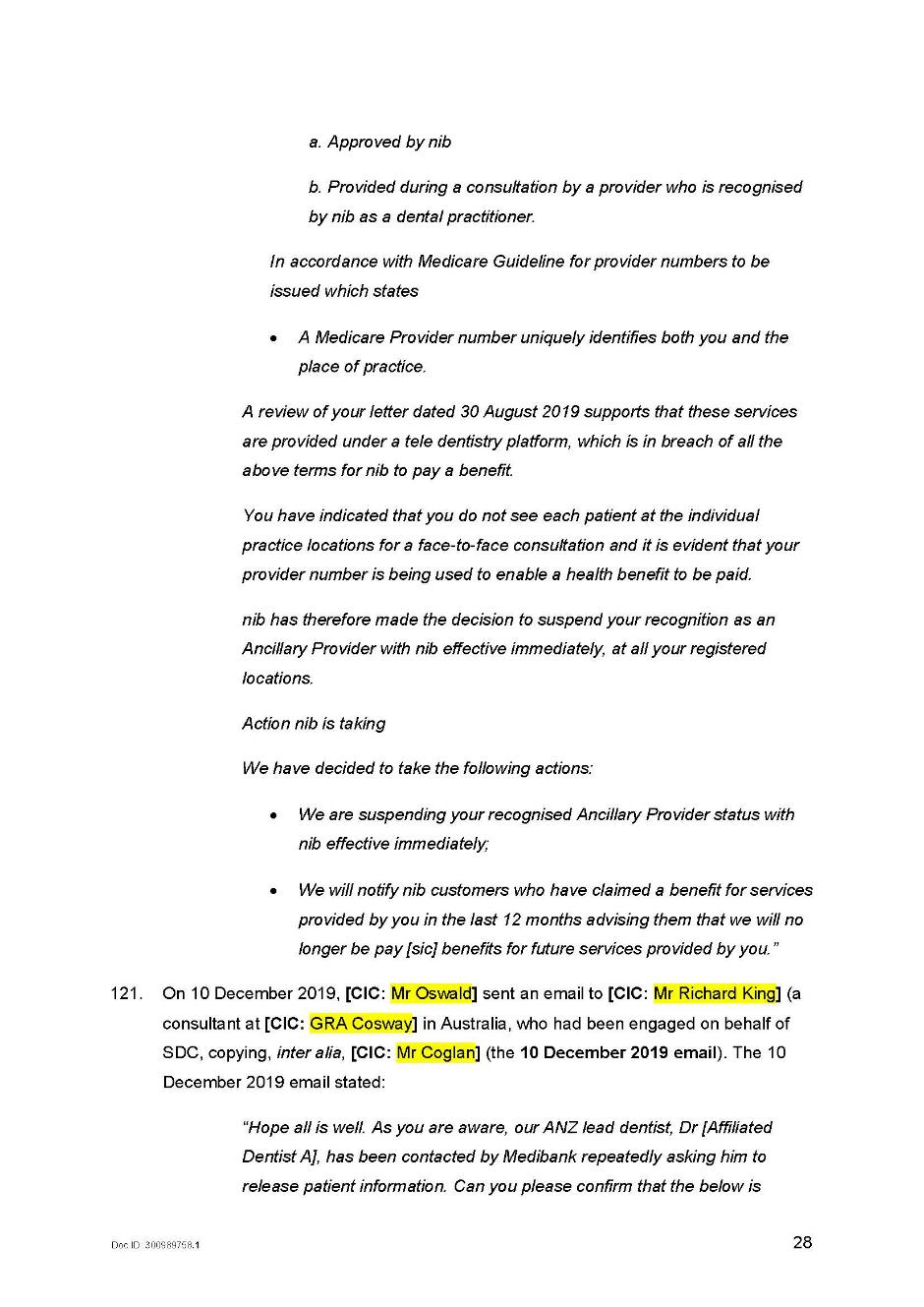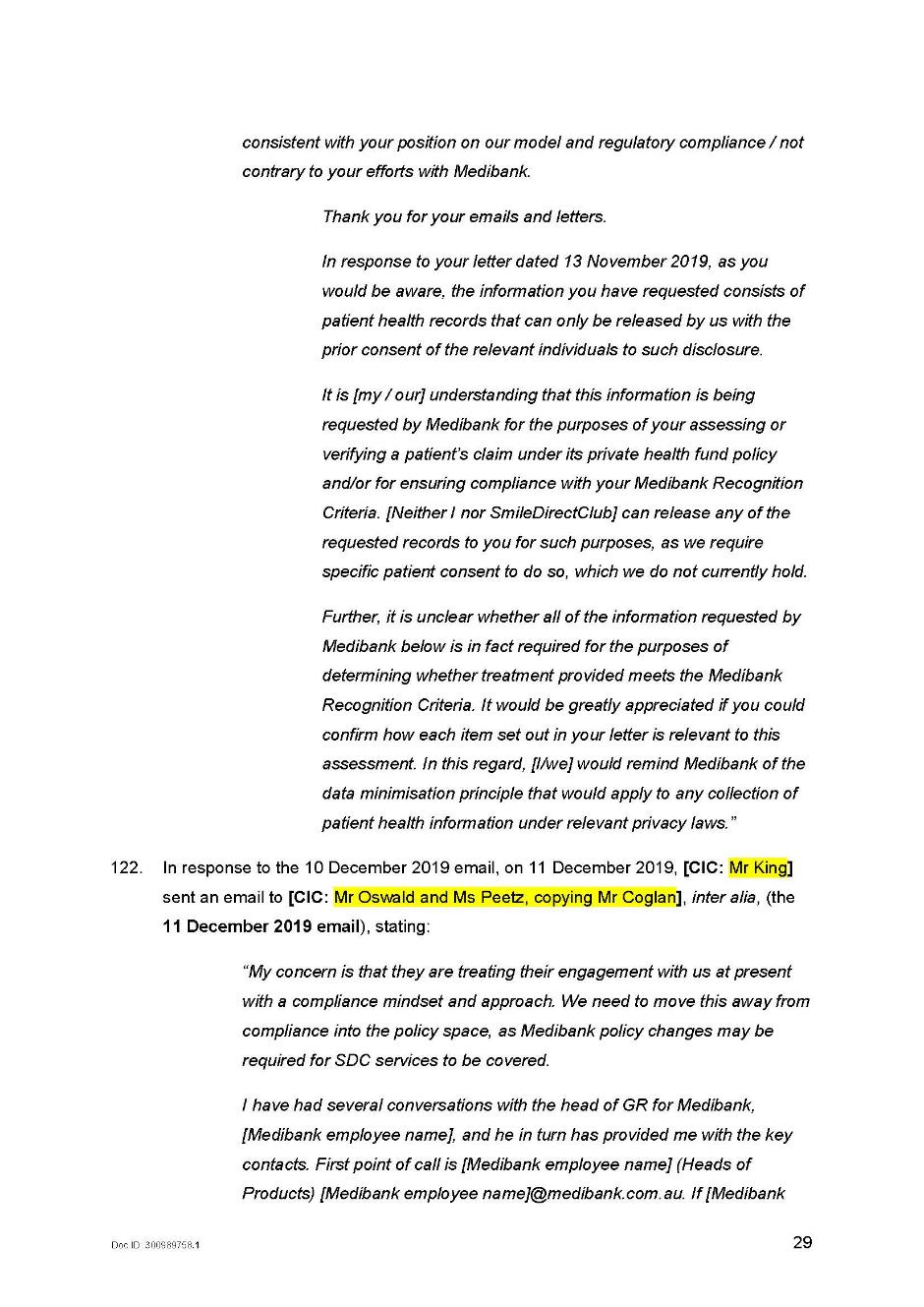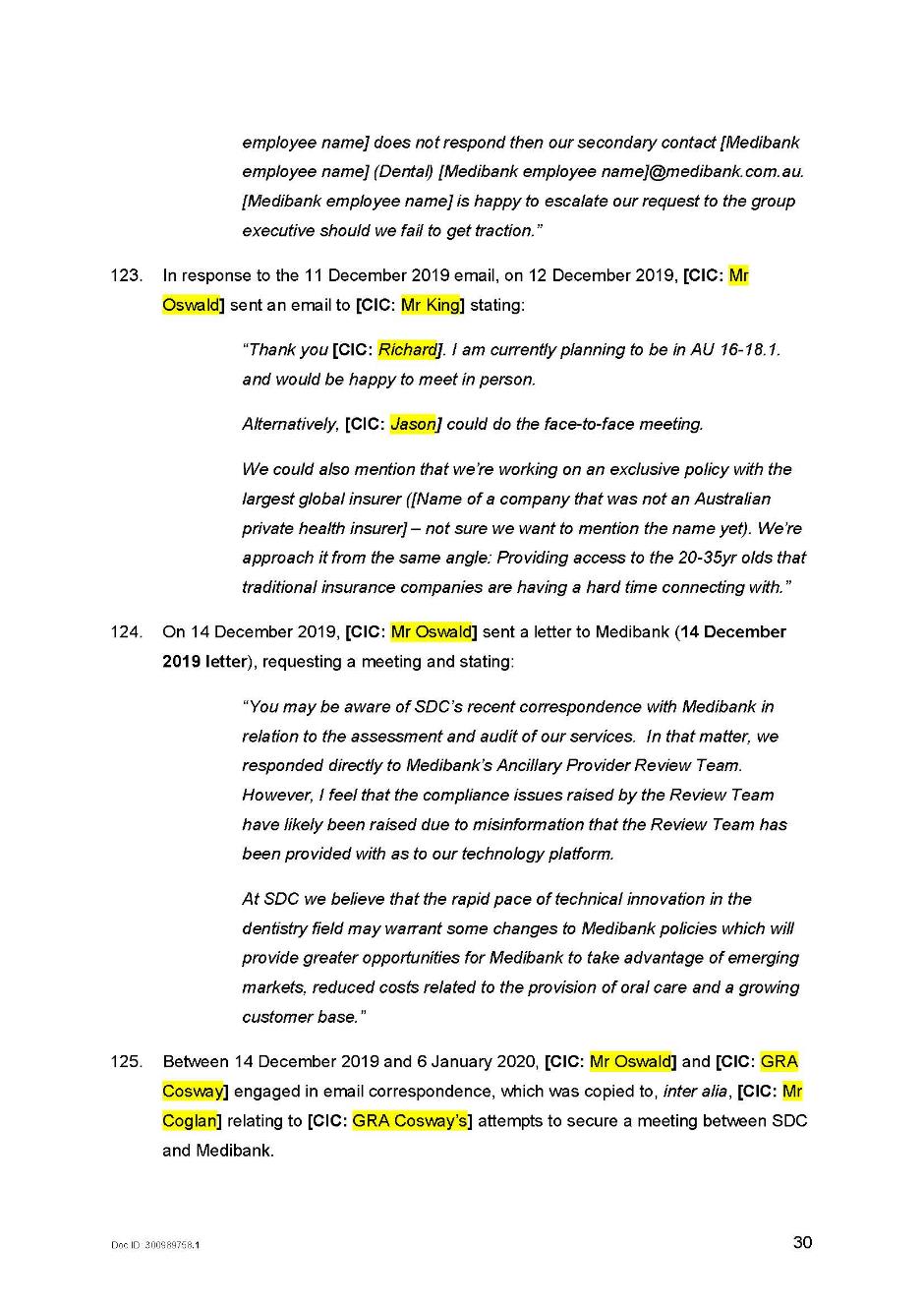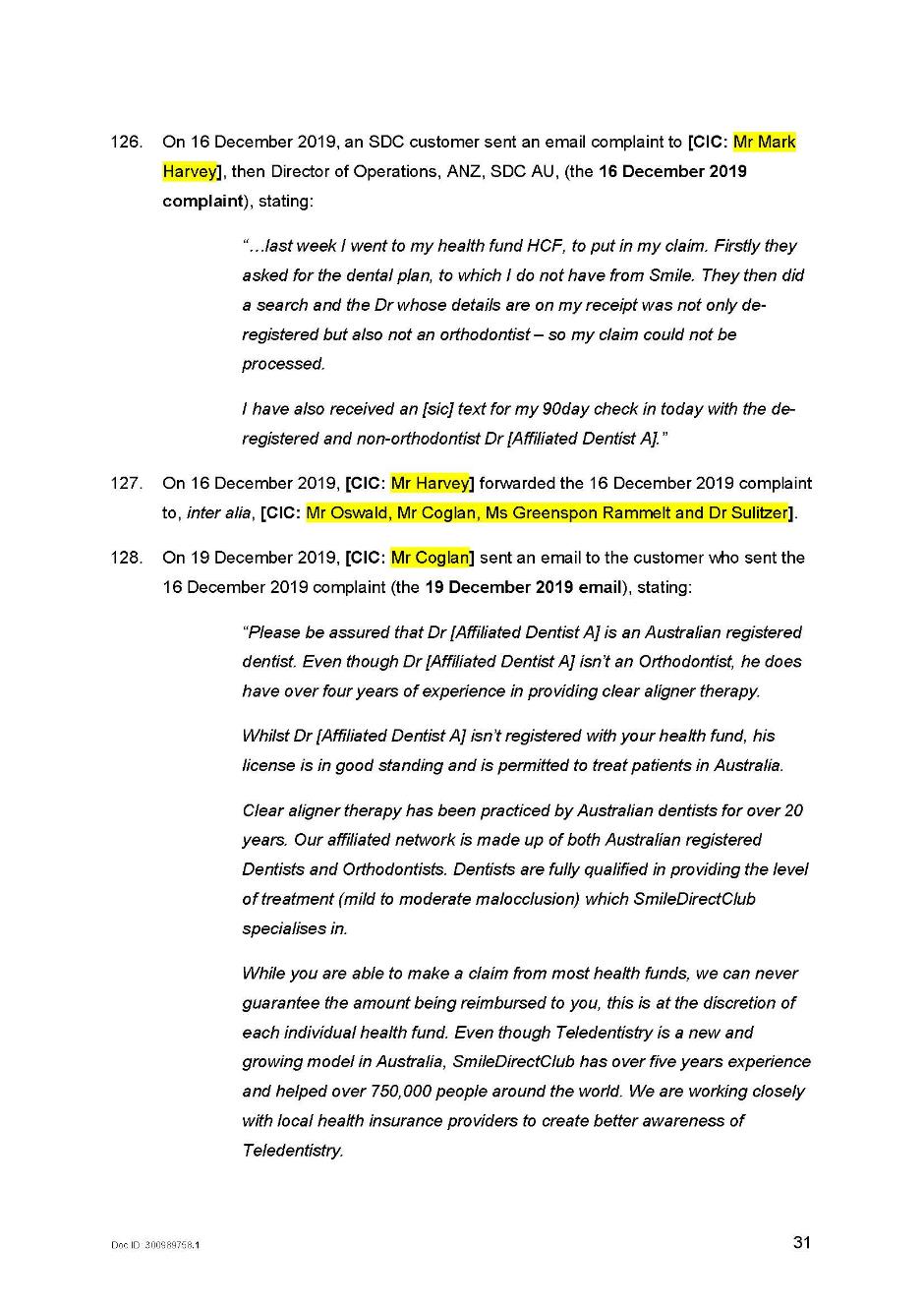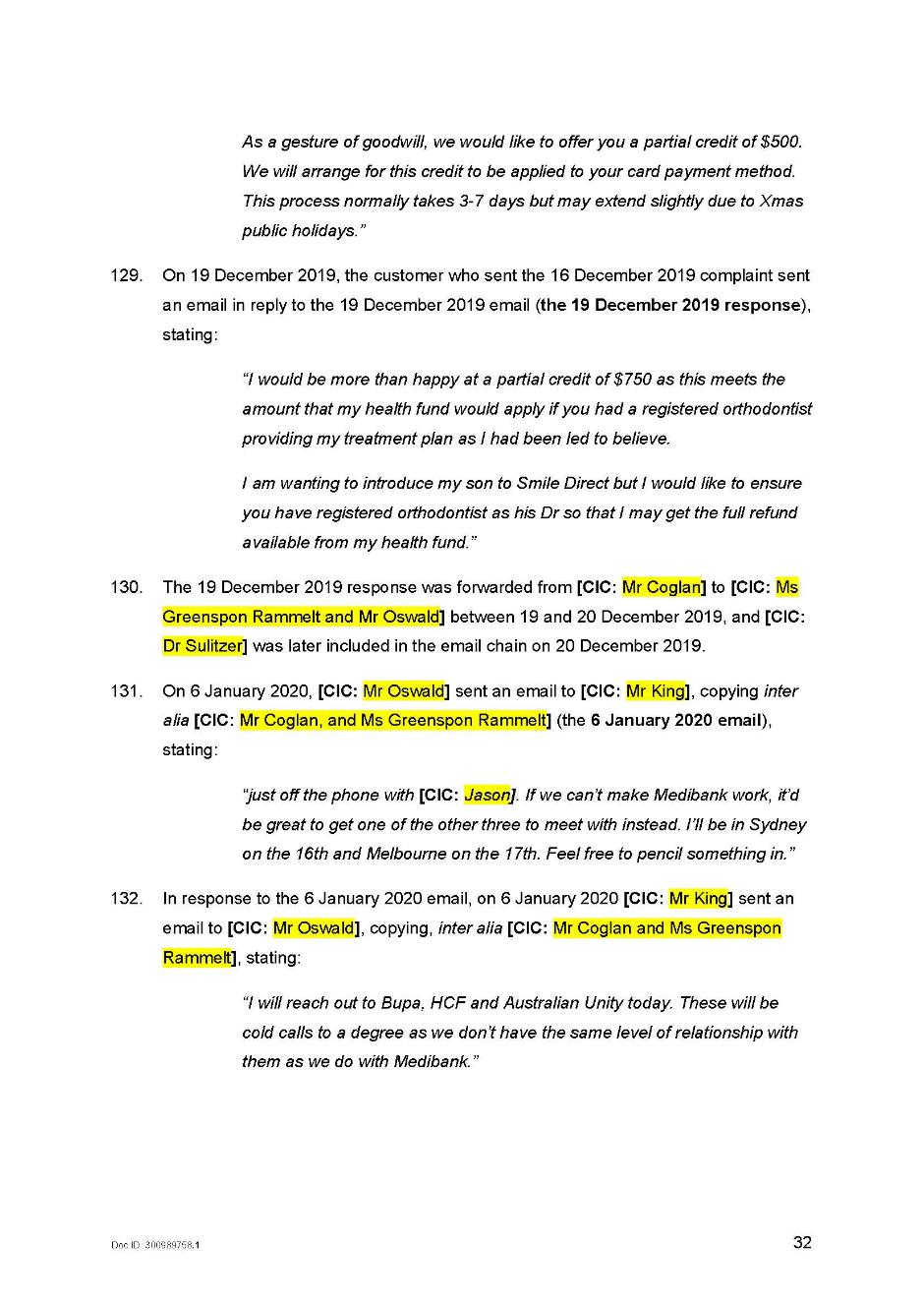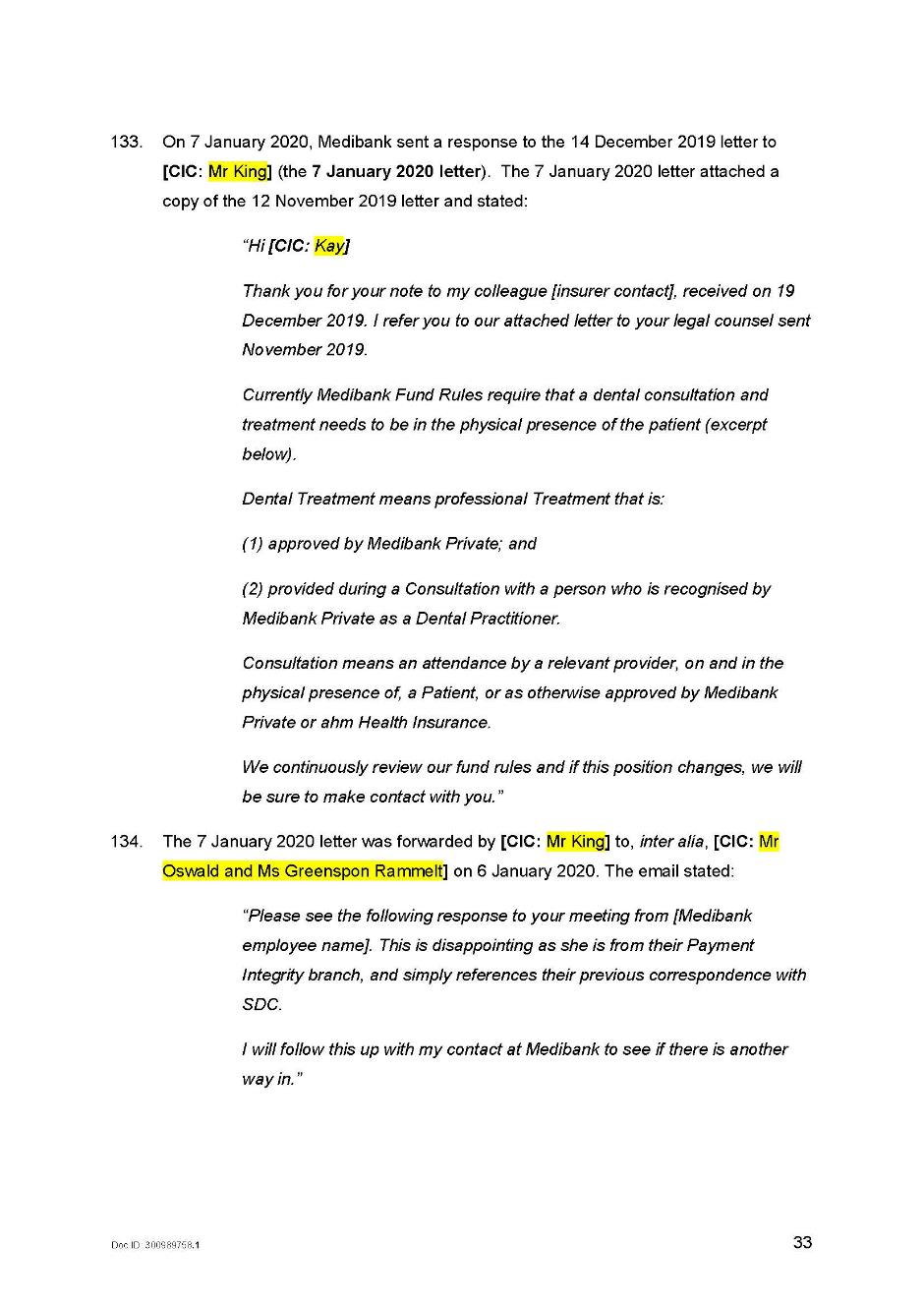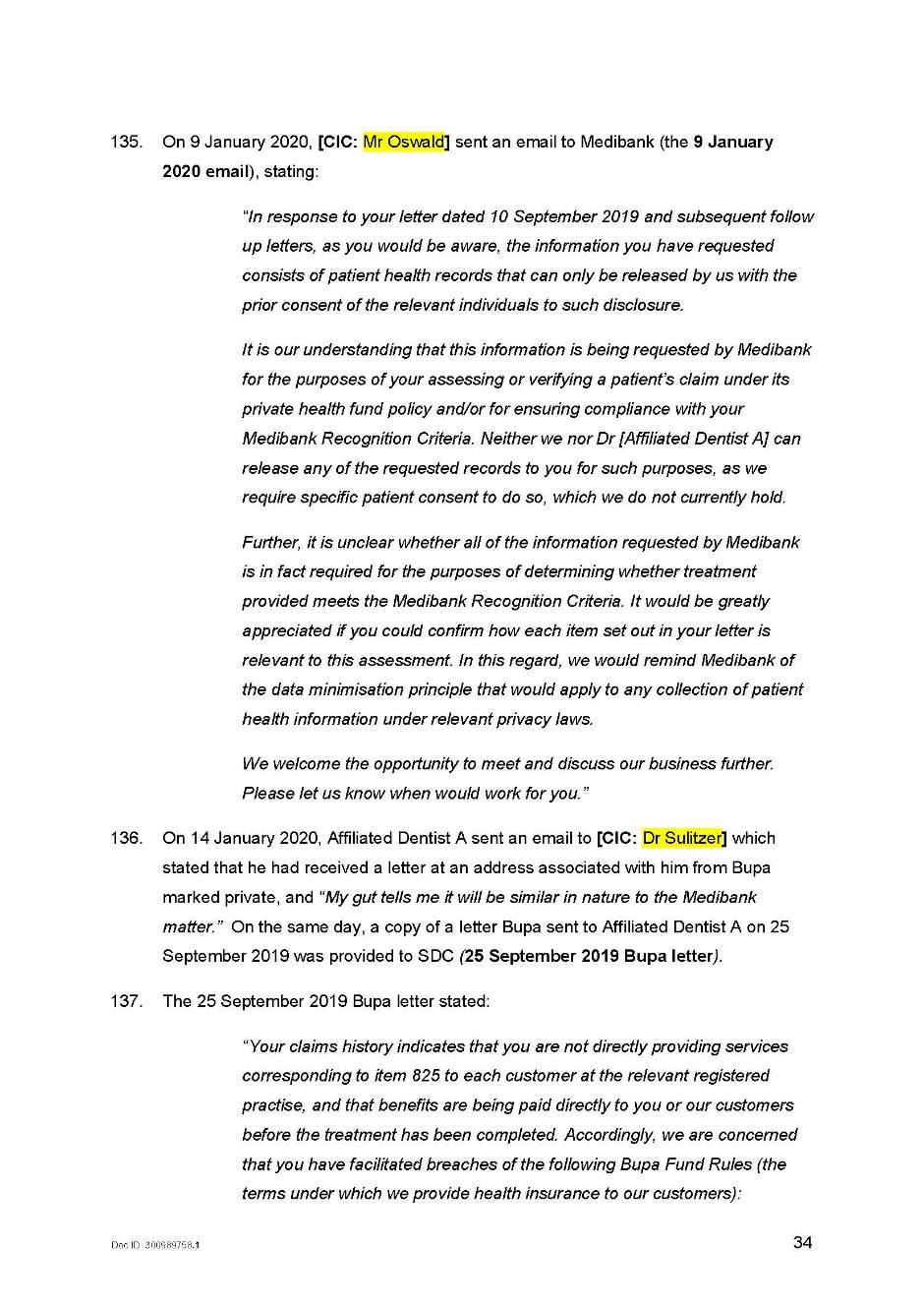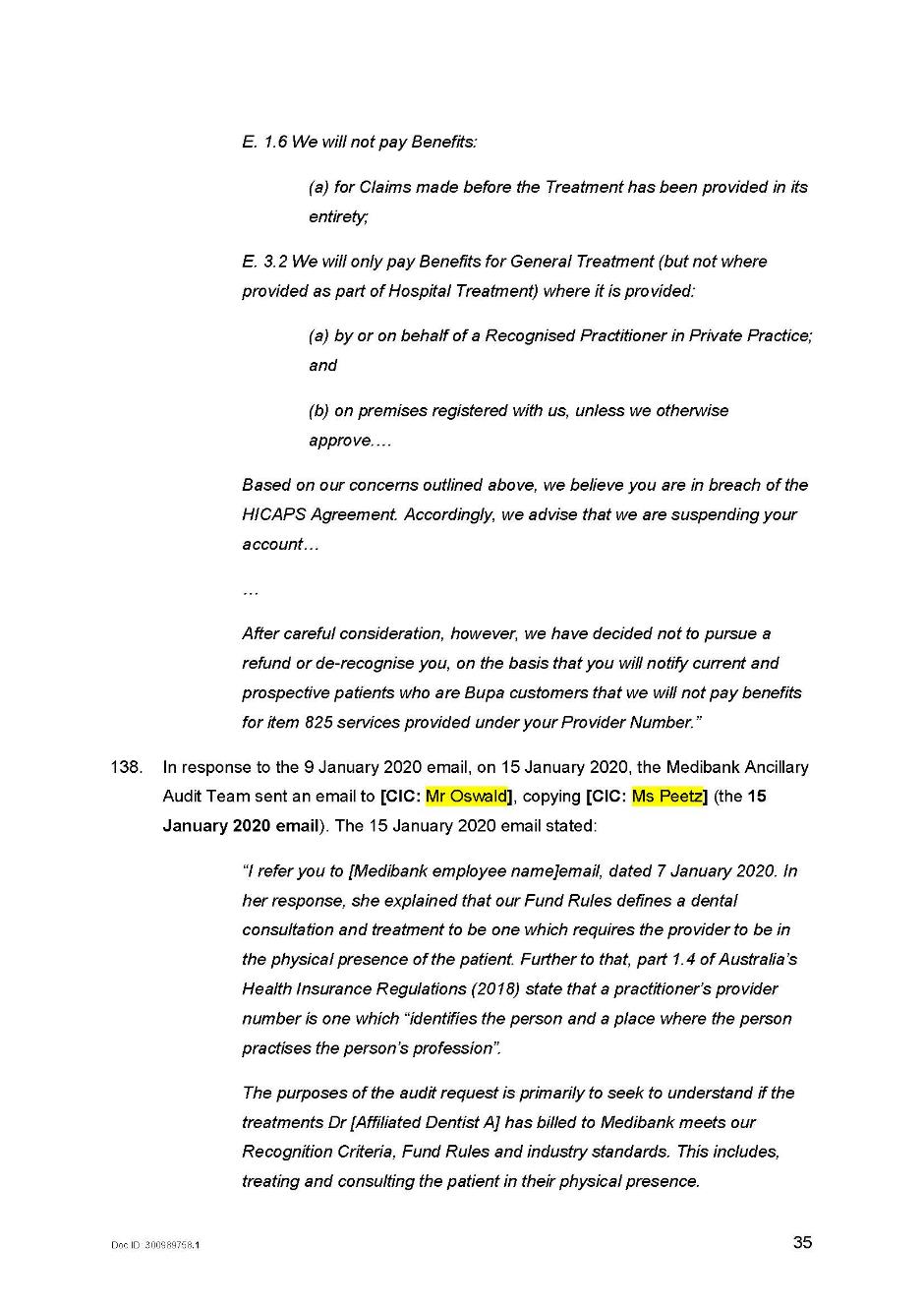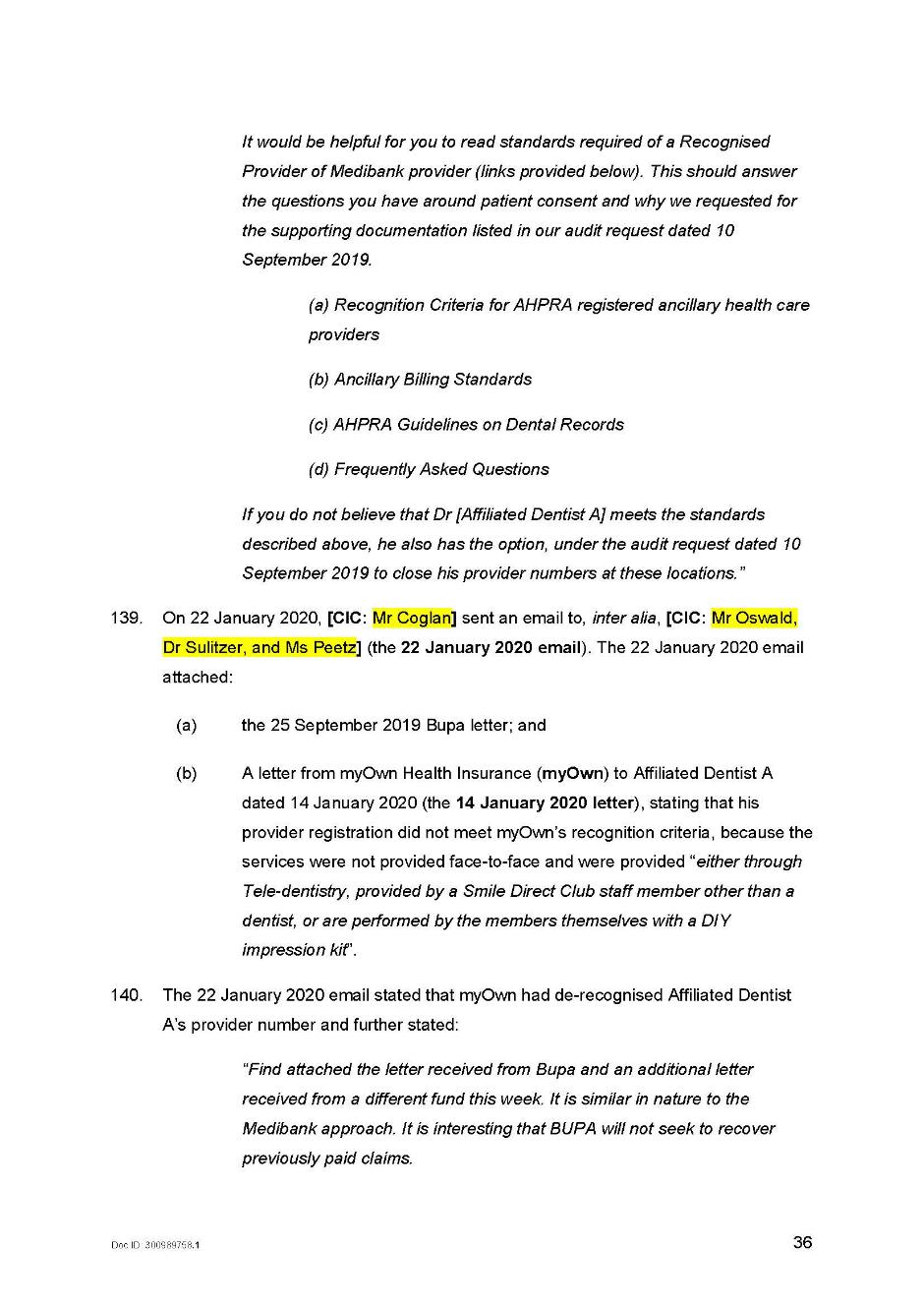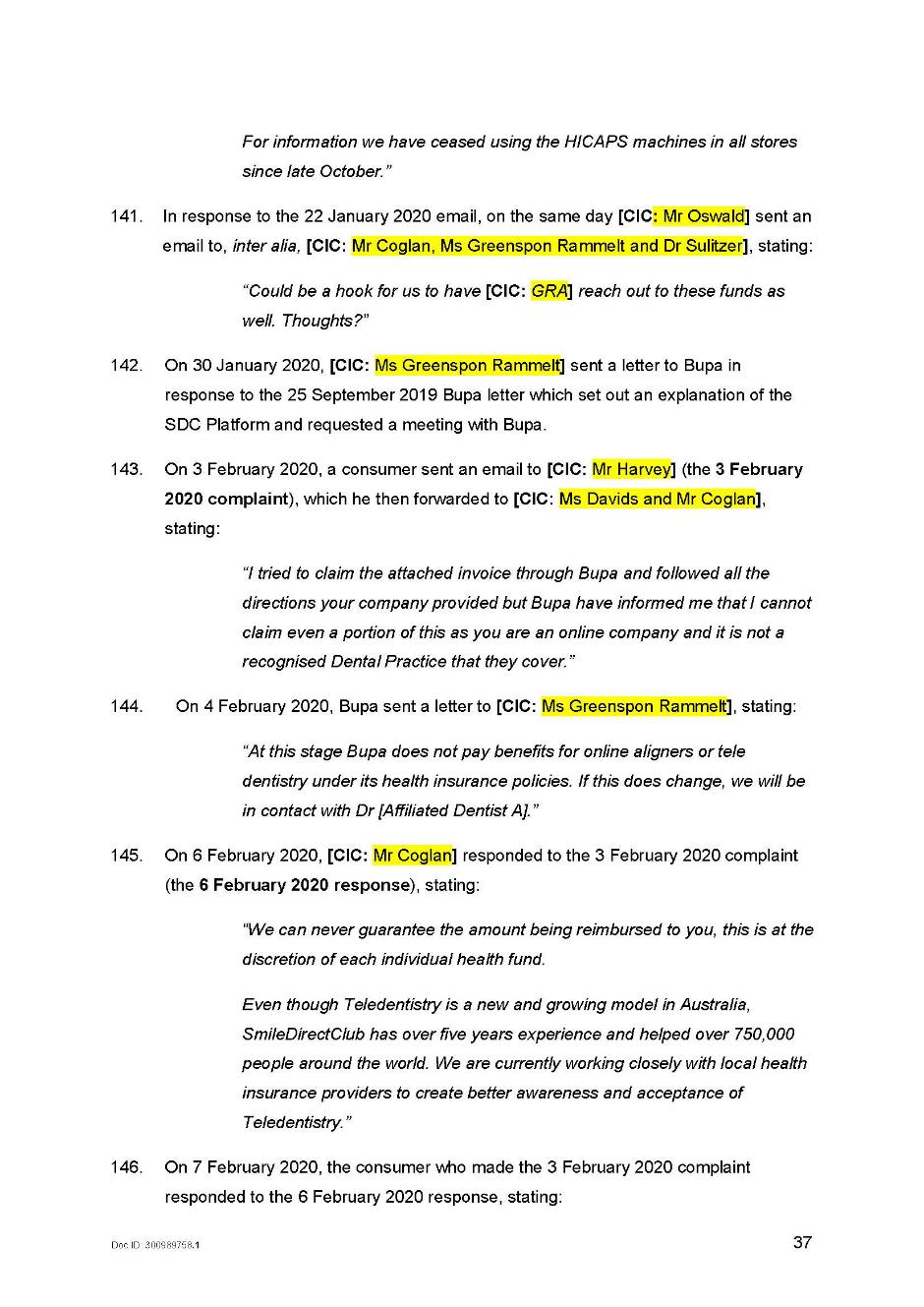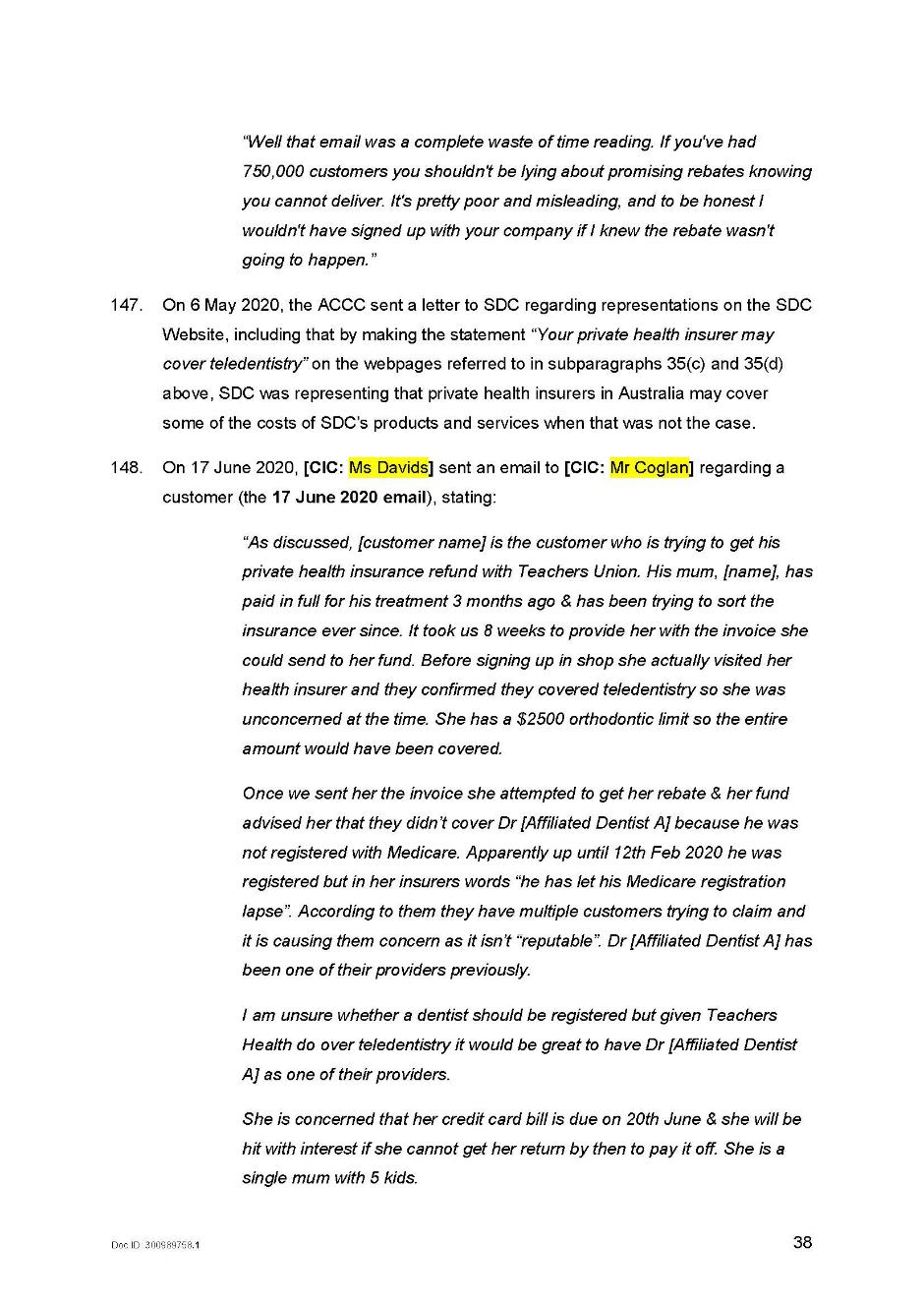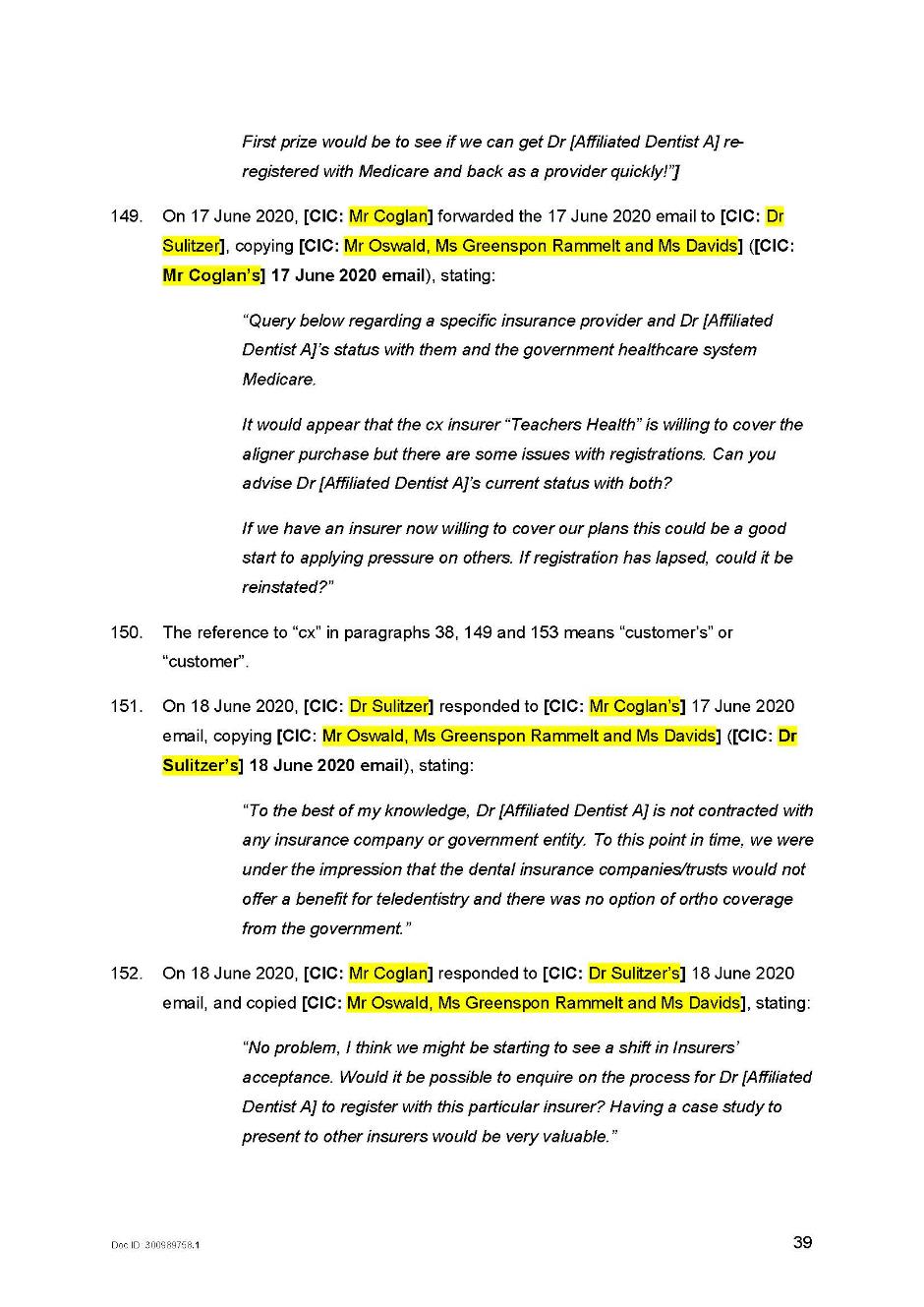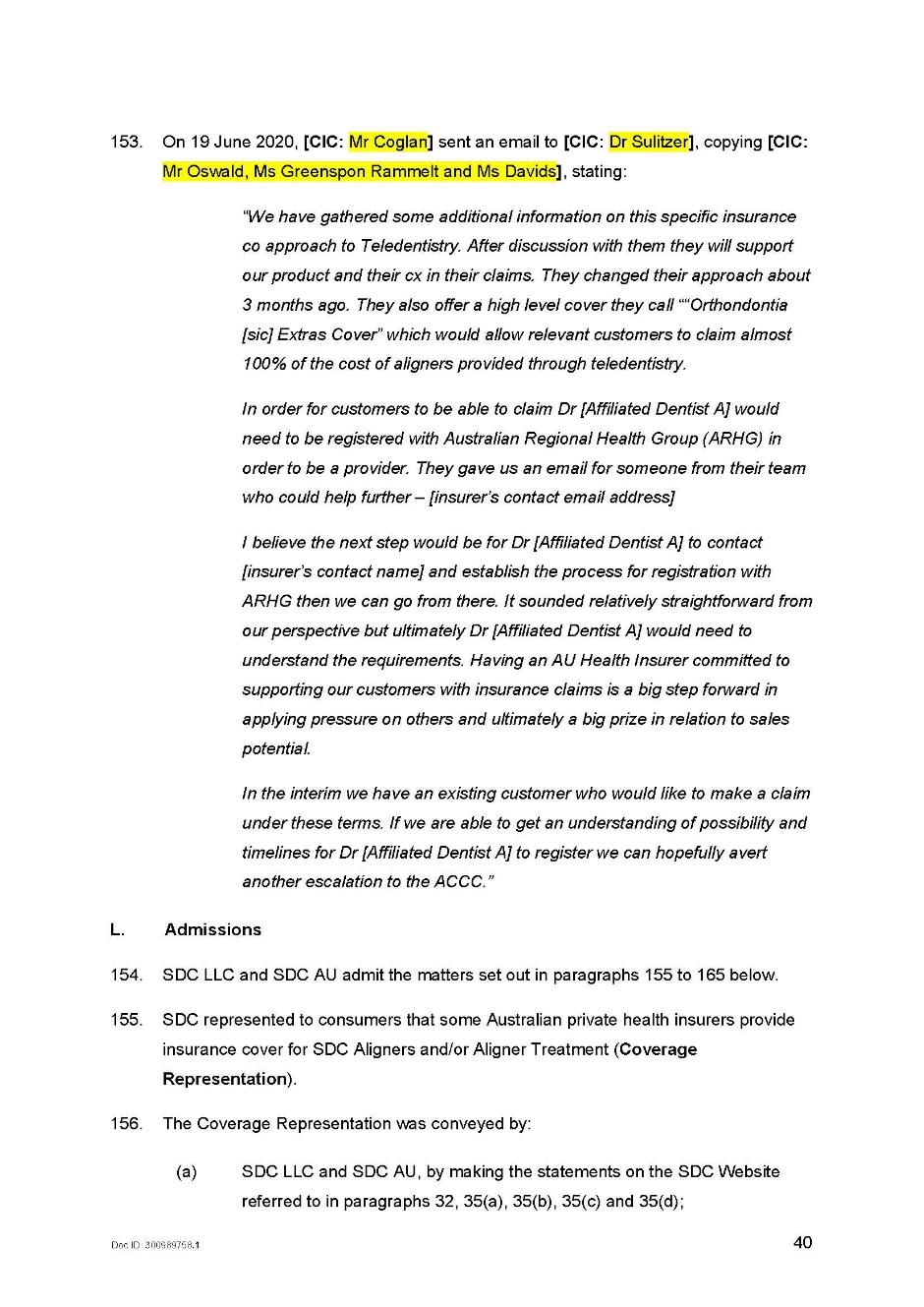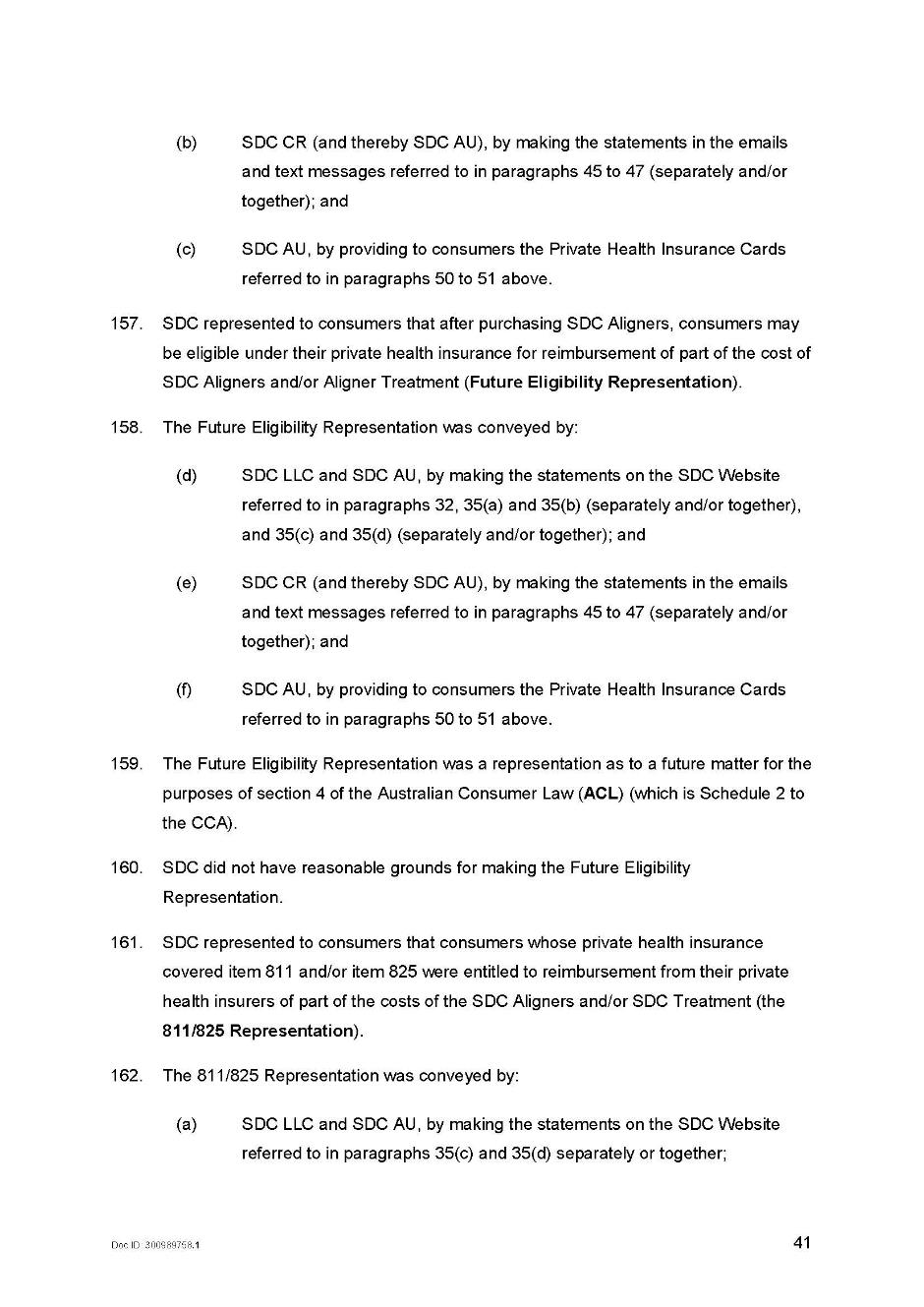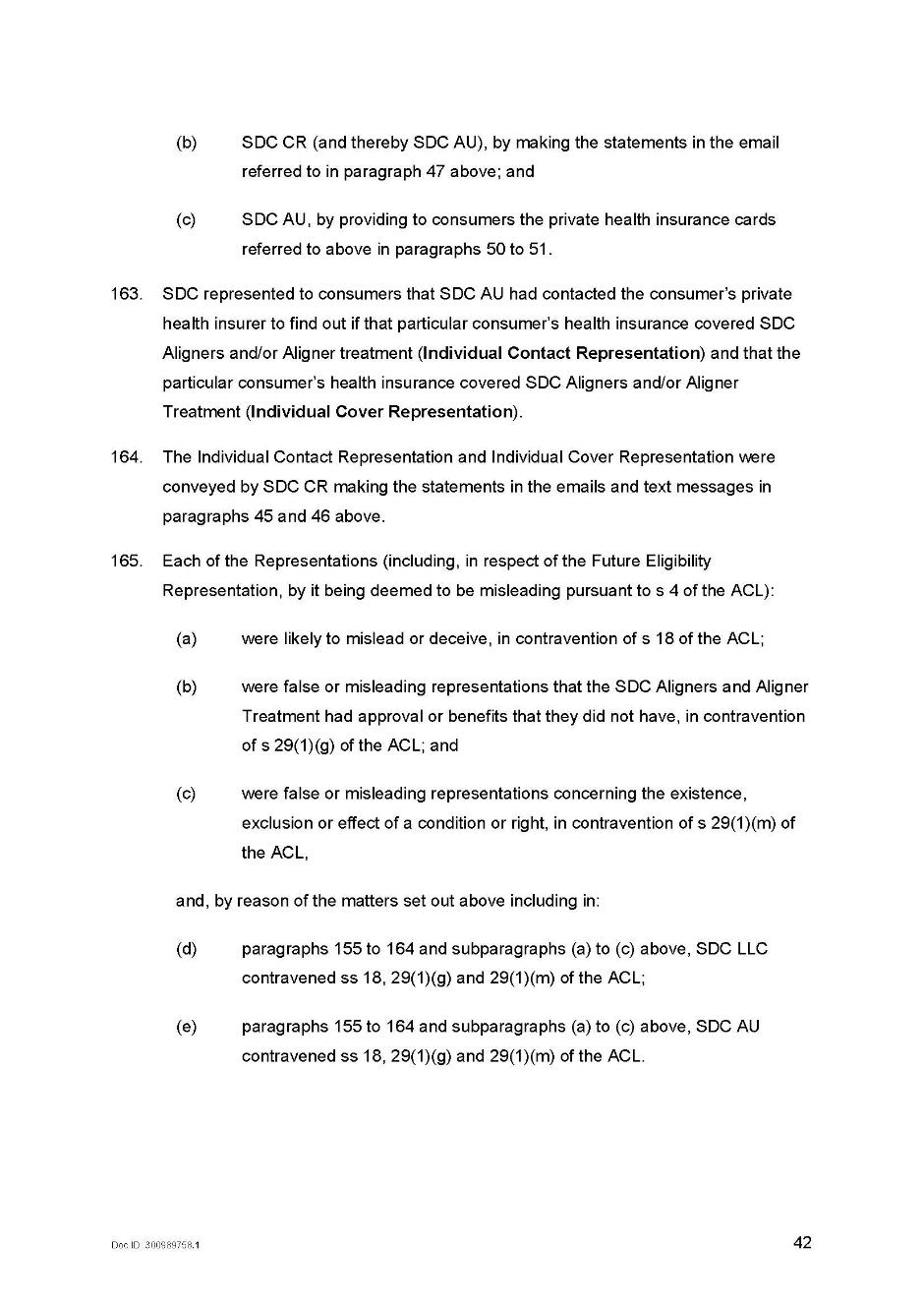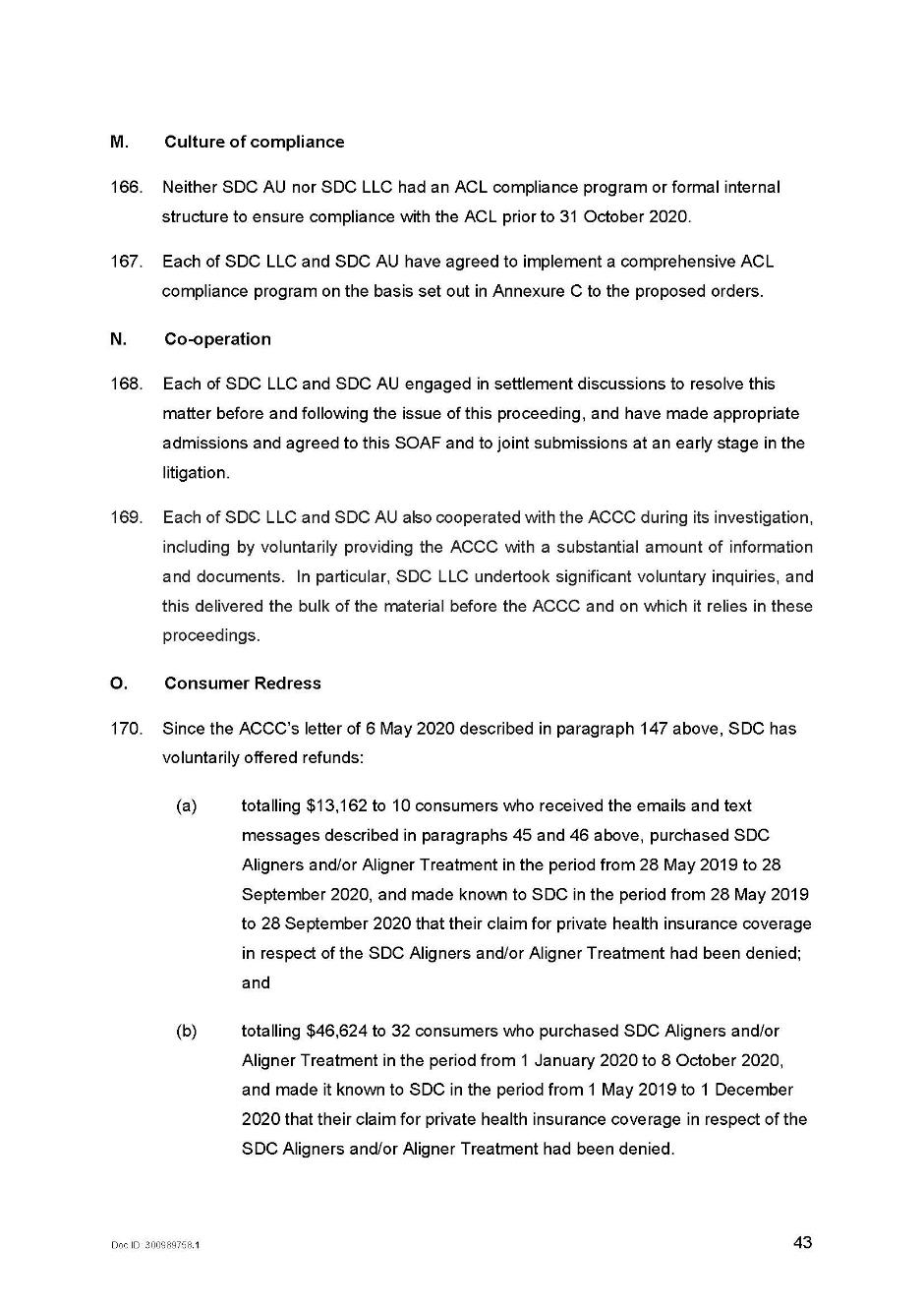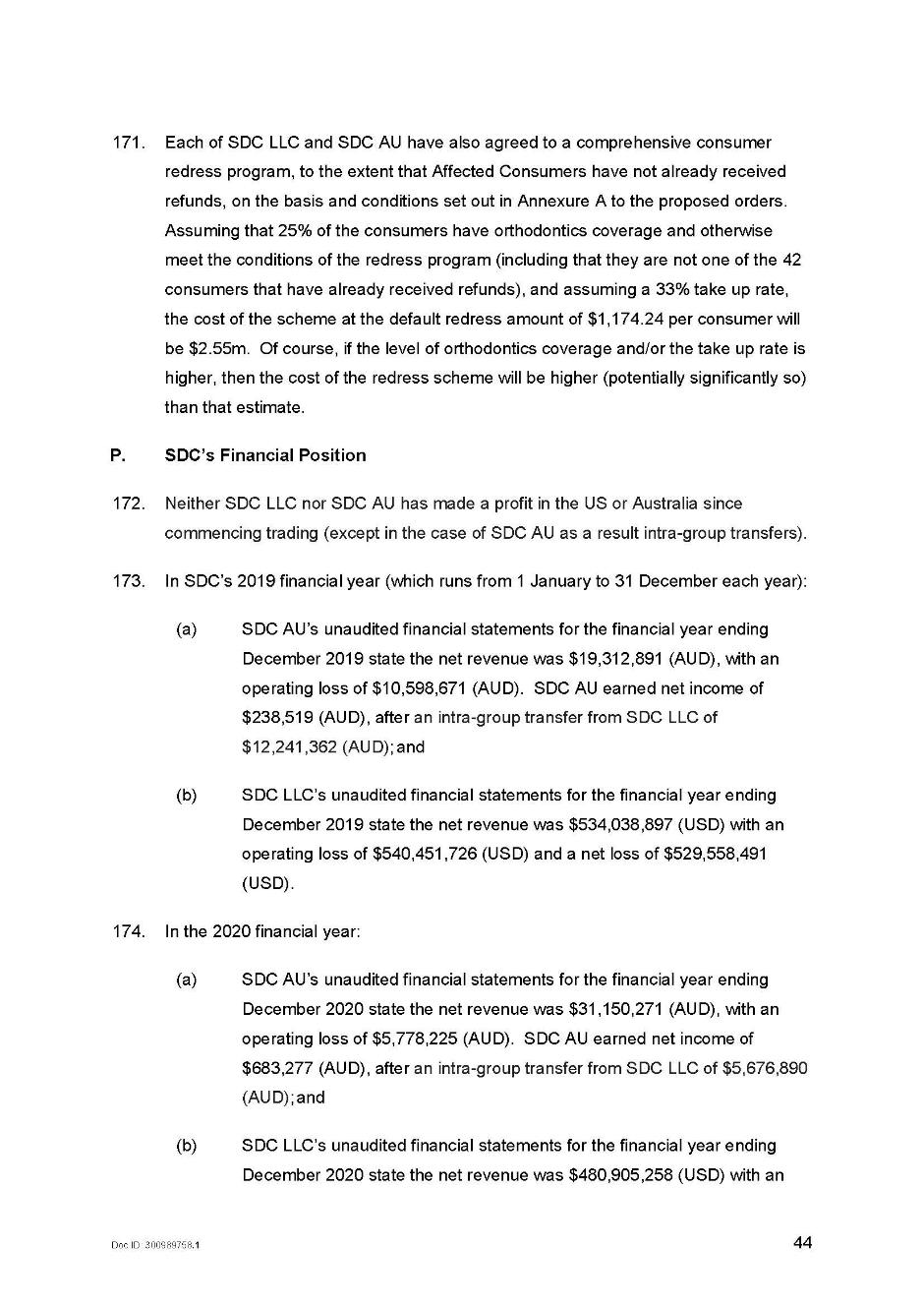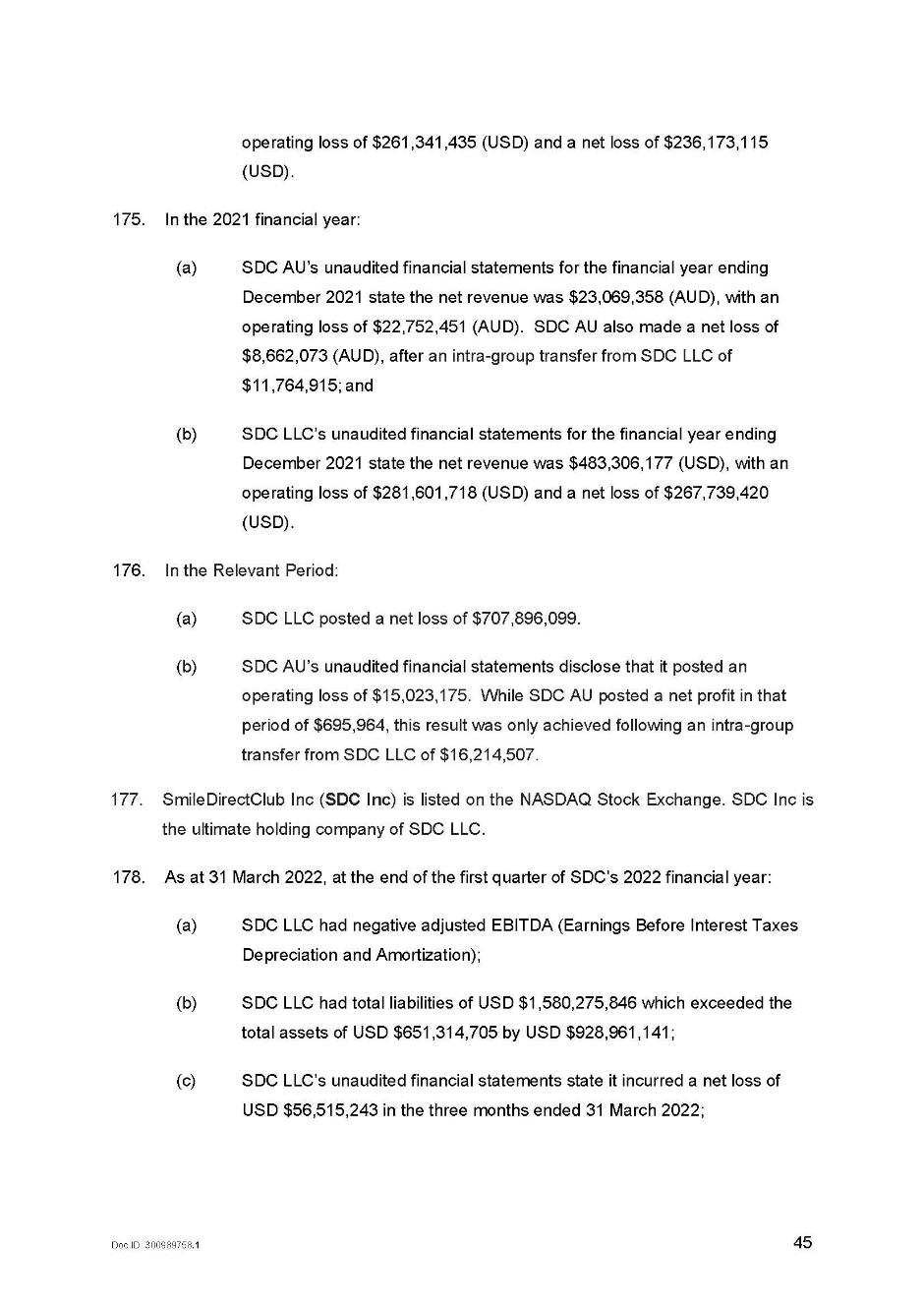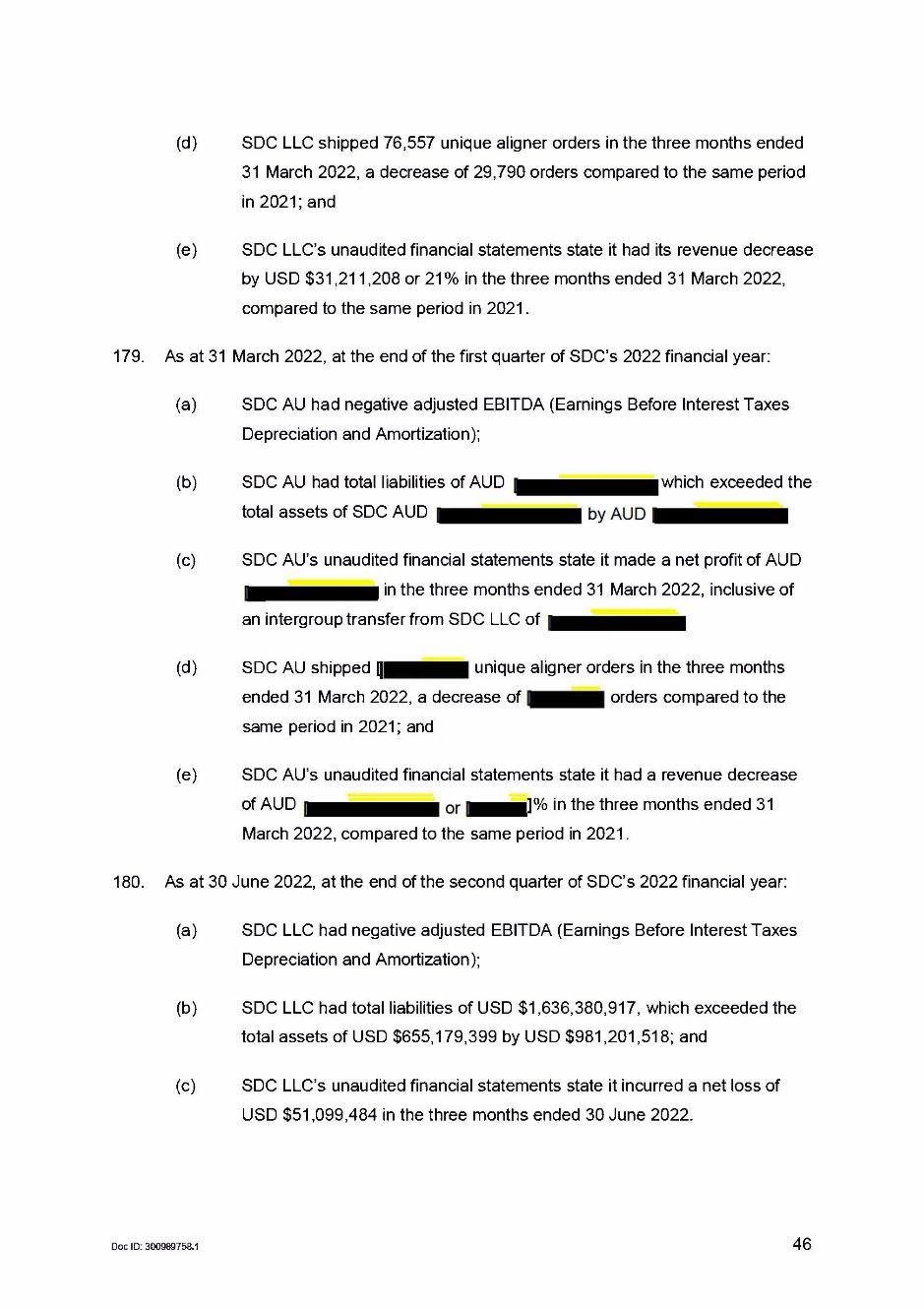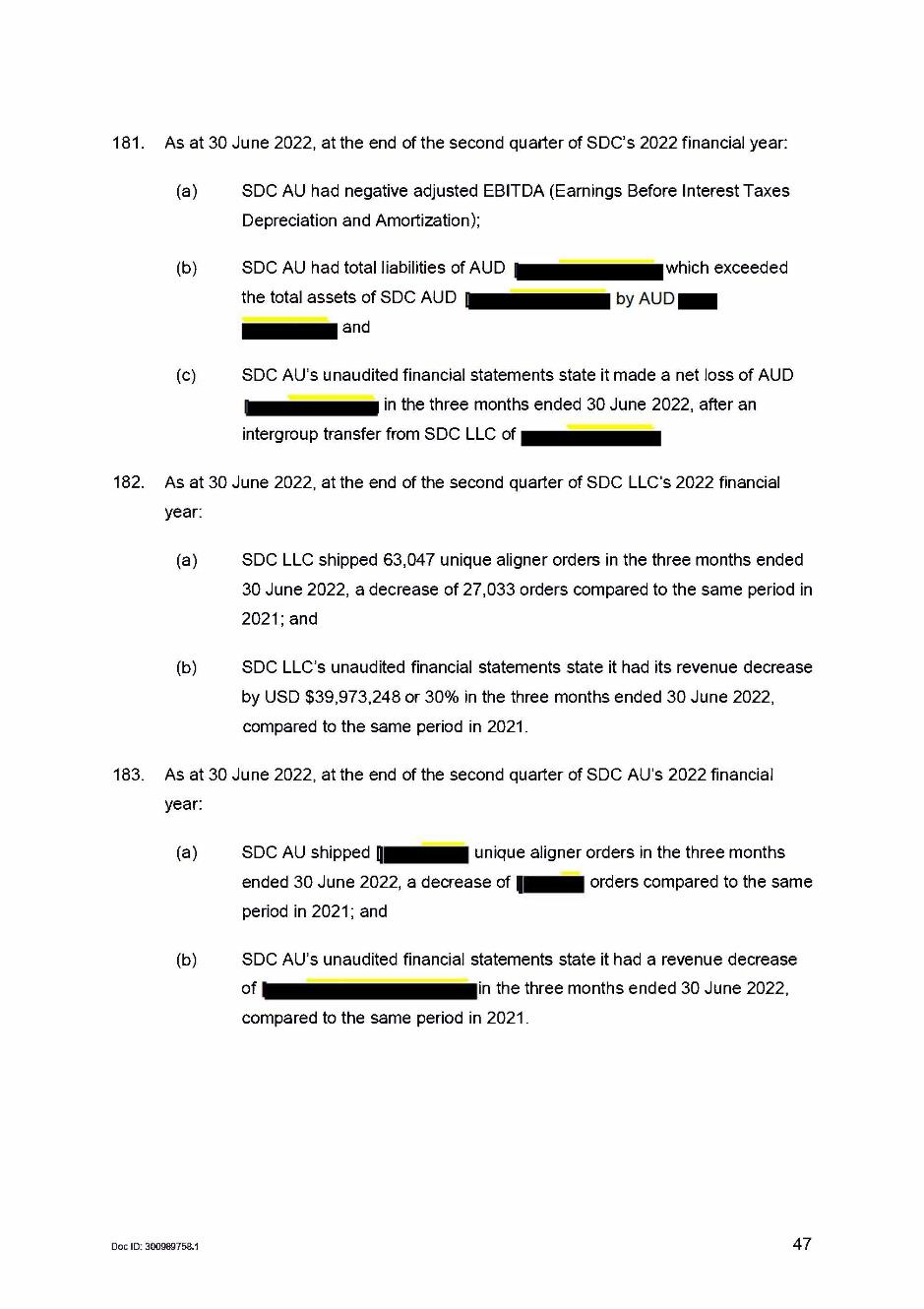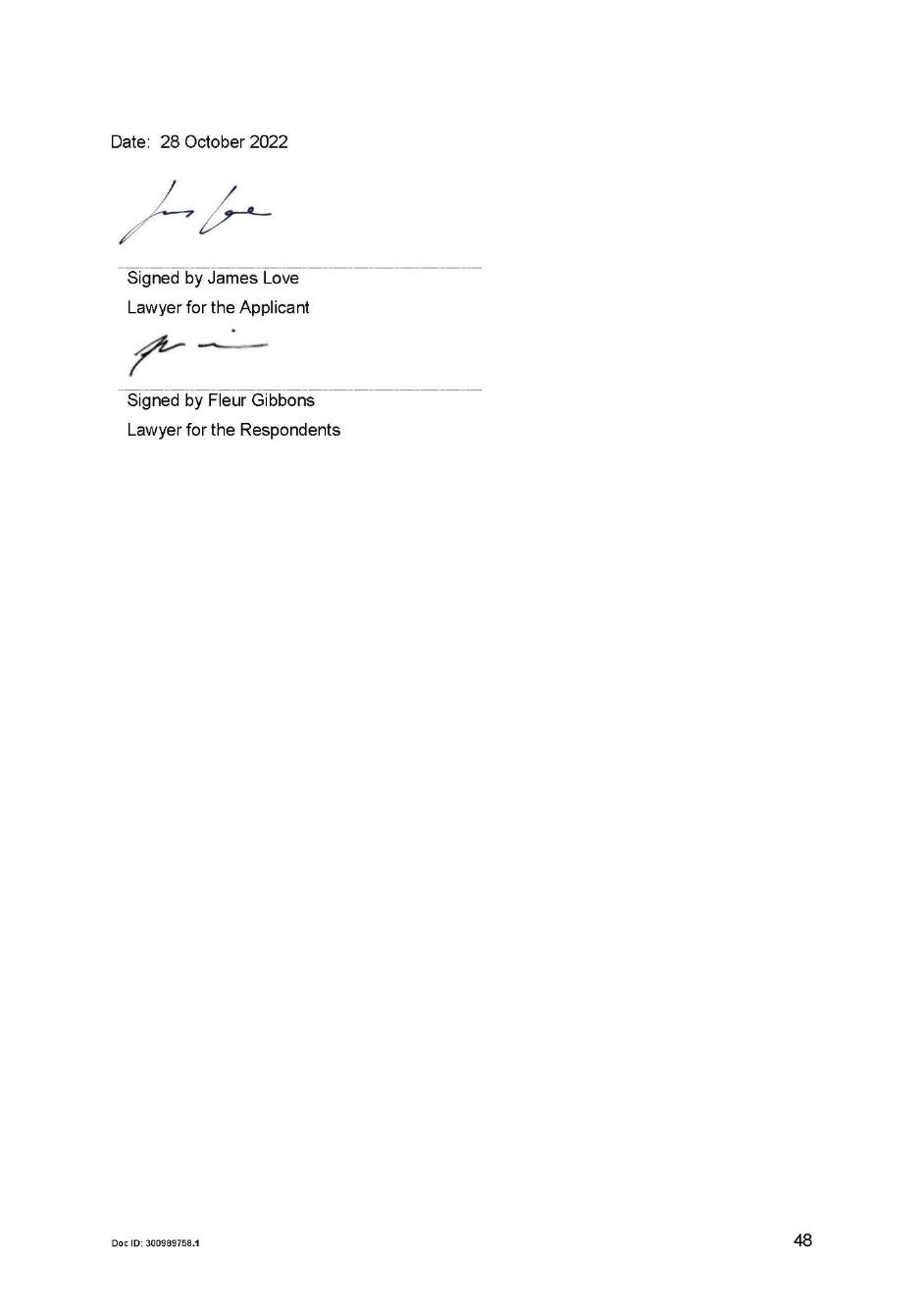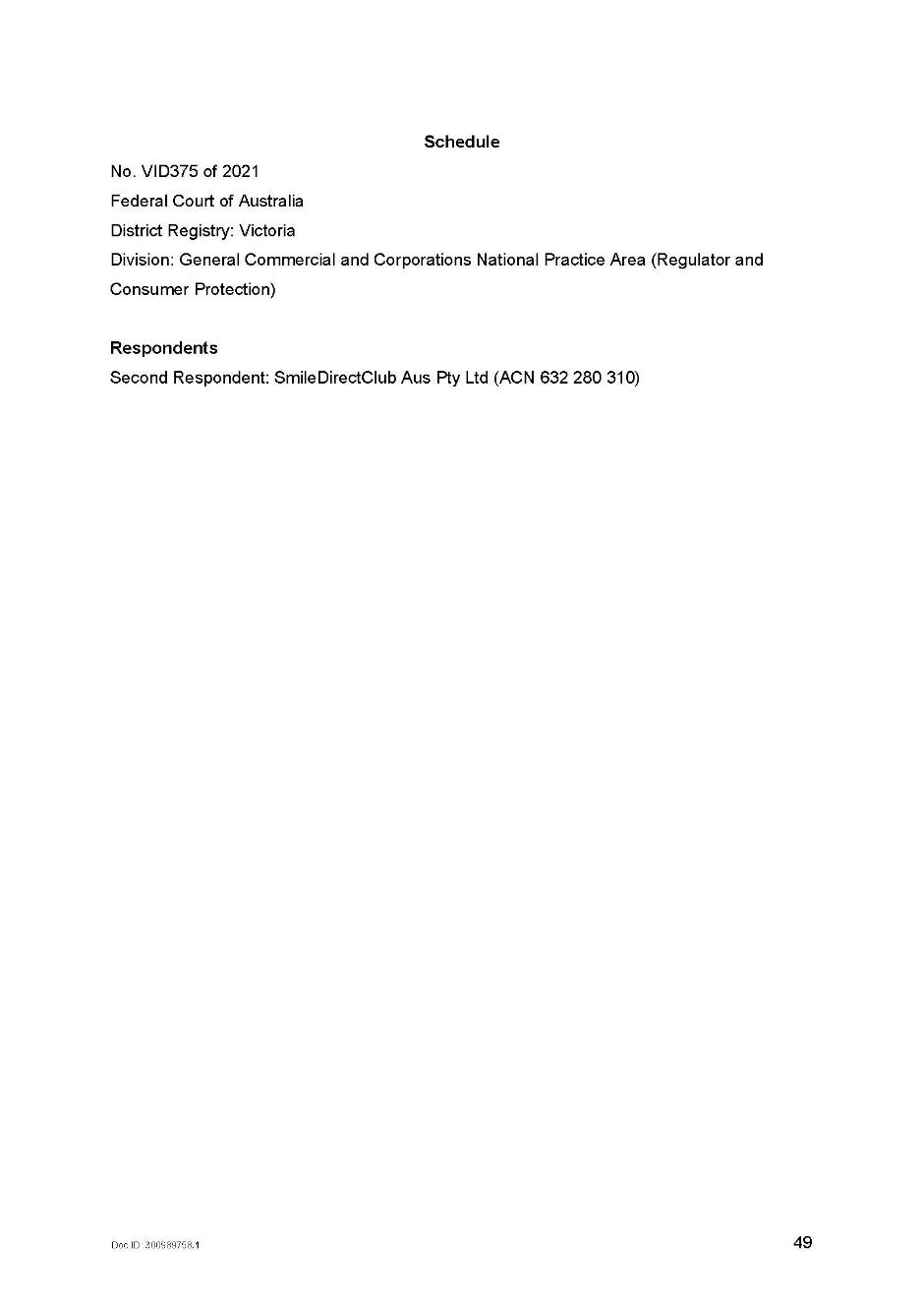FEDERAL COURT OF AUSTRALIA
Australian Competition and Consumer Commission v SmileDirectClub LLC [2022] FCA 1343
Table of Corrections | |
6 December 2022 | In Order 10, “5 years” has been replaced with “3 years” |
In Order 11(b), “5 years” has been replaced with “3 years” | |
6 December 2022 | In subparagraph 14(d) of Annexure C to the Orders, “4 further years” has been replaced with “2 further years” |
6 December 2022 | In subparagraph 19 of Annexure C to the Orders, “7 years” has been replaced with “5 years” |
6 December 2022 | In paragraph 106, “ five years” has been replaced with “three years” |
ORDERS
AUSTRALIAN COMPETITION AND CONSUMER COMMISSION Applicant | ||
AND: | First Respondent SMILEDIRECTCLUB AUS PTY LTD Second Respondent | |
DATE OF ORDER: |
THE COURT DECLARES THAT:
1. Between approximately 24 May 2019 and 8 October 2020, the First Respondent, SmileDirectClub LLC (SDC LLC), and Second Respondent, SmileDirectClub Aus Pty Ltd (SDC AU) (together, SDC), in trade or commerce:
(a) engaged in conduct that was misleading or deceptive, or likely to mislead or deceive, in contravention of section 18 of the Australian Consumer Law, being Schedule 2 of the Competition and Consumer Act 2010 (Cth) (ACL);
(b) made false or misleading representations that goods or services had approval or benefits in contravention of section 29(1)(g) of the ACL; and
(c) made false or misleading representations concerning the existence, exclusion or effect of a condition or right in contravention of section 29(1)(m) of the ACL,
by publishing, or causing to be published, statements on the website at www.smiledirectclub.com.au/en-au (Website) which contained representations:
(a) throughout that period, that some Australian private health insurers provide insurance cover for plastic teeth aligners promoted and supplied by SDC (SDC Aligners) and/or associated treatment (Aligner Treatment) (Coverage Representation);
(b) throughout that period, that after purchasing SDC Aligners, consumers may be eligible under their private health insurance for reimbursement of part of the cost of SDC Aligners and/or Aligner Treatment (Future Eligibility Representation);
(c) during the period from about February 2020 to 8 October 2020, that consumers whose private health insurance covered items 811 and/or 825 are entitled to reimbursement from their private health insurers of part of the cost of SDC Aligners and/or Aligner Treatment (Item 811/825 Representation),
when that was false, misleading or deceptive, and further, in respect of the Future Eligibility Representation, when they did not have reasonable grounds for making that representation.
2. Between approximately 28 May 2019 and 1 October 2019, SDC AU, in trade or commerce:
(a) engaged in conduct that was misleading or deceptive, or likely to mislead or deceive, in contravention of section 18 of the ACL;
(b) made false or misleading representations that goods or services had approval or benefits in contravention of section 29(1)(g) of the ACL; and
(c) made false or misleading representations concerning the existence, exclusion or effect of a condition or right in contravention of section 29(1)(m) of the ACL,
by sending, or having sent on its behalf, emails to 648 consumers who had made enquiries with SDC about private health insurance coverage, and in addition text messages to 124 of those consumers, which contained:
(a) the Coverage Representation;
(b) the Future Eligibility Representation;
(c) a representation that SDC AU had contacted the consumer’s private health insurer to find out if that particular consumer’s health insurance covered SDC Aligners and/or Aligner Treatment (Individual Contact Representation);
(d) a representation that the particular consumer’s health insurance covered SDC Aligners and/or Aligner Treatment (Individual Cover Representation),
when that was false, misleading or deceptive, and further, in respect of the Future Eligibility Representation, when they did not have reasonable grounds for making that representation.
3. In or about 2019, SDC AU, in trade or commerce:
(a) engaged in conduct that was misleading or deceptive, or likely to mislead or deceive, in contravention of section 18 of the ACL;
(b) made false or misleading representations that goods or services had approval or benefits in contravention of section 29(1)(g) of the ACL; and
(c) made false or misleading representations concerning the existence, exclusion or effect of a condition or right in contravention of section 29(1)(m) of the ACL,
by sending, or having sent on its behalf, emails to consumers, other than those referred to in paragraph 2 above, who had made enquiries with SDC about private health insurance coverage which contained:
(a) the Coverage Representation;
(b) the Future Eligibility Representation;
(c) the Item 811/825 Representation,
when that was false, misleading or deceptive, and further, in respect of the Future Eligibility Representation, when they did not have reasonable grounds for making that representation.
4. From 20 June 2019 to 20 December 2019, SDC AU, in trade or commerce:
(a) engaged in conduct that was misleading or deceptive, or likely to mislead or deceive, in contravention of section 18 of the ACL;
(b) made false or misleading representations that goods or services had approval or benefits in contravention of section 29(1)(g) of the ACL; and
(c) made false or misleading representations concerning the existence, exclusion or effect of a condition or right in contravention of section 29(1)(m) of the ACL,
by distributing to consumers in its retail stores in Australia called SmileShops a printed card which contained:
(a) the Coverage Representation;
(b) the Future Eligibility Representation;
(c) the Item 811/825 Representation,
when that was false, misleading or deceptive, and further, in respect of the Future Eligibility Representation, when they did not have reasonable grounds for making that representation.
THE COURT ORDERS THAT:
Pecuniary penalties
5. Pursuant to section 224(1) of the ACL, the Respondents pay to the Commonwealth of Australia pecuniary penalties in respect of the contraventions of sections 29(1)(g) and 29(1)(m) of the ACL referred to in paragraphs 1 to 4 above, as follows:
(a) in respect of SDC LLC, pecuniary penalties in the amount of $1.75 million; and
(b) in respect of SDC AU, pecuniary penalties in the amount of $1.75 million.
6. Each Respondent is to pay its pecuniary penalties referred to in paragraph 5 above in 6 equal instalments of $291,666.67, payable as follows:
(a) an instalment within 7 days of the date of this order;
(b) an instalment within 6 months of the date of this order;
(c) an instalment within 12 months of the date of this order;
(d) an instalment within 18 months of the date of this order;
(e) an instalment within 24 months of the date of this order; and
(f) an instalment within 30 months of the date of this order.
7. In the event that a Respondent is in default of any of the instalment payments referred to in paragraph 6 above by any more than 14 days, the whole of the outstanding amount of the pecuniary penalty specified in paragraph 5 above in respect of that Respondent is immediately due and payable by that Respondent.
Consumer redress
8. Pursuant to section 239 of the ACL, the Respondents provide redress to non-party consumers, in accordance with the methodology set out in Annexure A to this order:
(a) to each customer set out in Column A;
(b) payment of the amount set out in Column B;
(c) subject to the conditions set out in Column C and under the heading “General conditions attaching to consumer redress” in Annexure A.
Publication orders
9. Pursuant to section 246(2)(d) of the ACL, the Respondents must jointly issue to each Australian consumer who purchased SDC Aligners and/or Aligner Treatment during the period 1 May 2019 and 31 October 2020 inclusive, a notice in the form set out in Annexure B to these orders at their own expense within 30 days of this order.
Compliance orders
10. Pursuant to section 246(2)(b) of the ACL, each of the Respondents, at their own expense, establish and implement an Australian Consumer Law Compliance Program in accordance with Annexure C, and maintain that program for a period of at least 3 years from the date of this order.
Other orders
11. The Respondents serve on the Applicant:
(a) an affidavit verifying that it has carried out its obligations under paragraph 9 above, to be served within 37 days of this order;
(b) an affidavit verifying that it has carried out its obligations under paragraph 8 above, and including:
(i) the number of consumers who made claims for redress;
(ii) the number of consumers granted redress and amounts paid; and
(iii) the reasons for rejection of any claims for redress,
to be served within 9 months of this order;
(a) an affidavit verifying that it has carried out its obligations under paragraph 10 above as set out in paragraphs 1 to 8 of Annexure C, to be served within 4 months of this order;
(b) an affidavit verifying that it has carried out its obligations under paragraph 10 of this order, to be served within 3 years and 1 month of this order.
12. The Respondents are jointly and severally liable to pay a contribution to the Applicant’s costs of, and incidental to, this proceeding in the fixed amount of $100,000 within 7 days of the date of this order.
Note: Entry of orders is dealt with in Rule 39.32 of the Federal Court Rules 2011.
ANNEXURE A
COLUMN A (CUSTOMER CATEGORY) | COLUMN B (REDRESS AMOUNT) | COLUMN C (CONDITIONS) |
Category 1 – Recipients of Good News communications All customers who were sent the Good News Email, who have not already received a refund from SDC and who purchased SDC’s aligners and/or associated treatment in the period 1 May 2019 to 31 October 2020. | SDC will pay to the customer: a. If the customer was also sent a Good News Text, a refund of:
whichever is the higher; and b. For all other customers who were sent the Good News Email, and in respect of each such customer, a refund in the amount SDC understands was referred to in the email sent to that customer or, where that amount cannot be ascertained, a refund in the amount of $1,174.24. | The customer must provide to SDC a declaration (in a form to be provided by SDC to the customer) that they: a. either made a claim for an insurance payment in respect of SDC’s aligners and/or associated treatment, or made enquiries about their insurance coverage after the purchase of the aligners and found that such a claim would not be allowed (or, for customers who commenced treatment in the period 1 May 2019 and 31 October 2020 but who are still completing their instalment plan, they intended to make such a claim before or at the completion of their plan); and b. either have not received an insurance payment in respect of SDC’s aligners and/or associated treatment or have received an insurance payment in an amount specified in that declaration (which is less than the amount of the refund from SDC to which they would otherwise be entitled); and c. will not in the future seek an insurance payment or any further insurance payment (as the case may be) in respect of their purchase between 1 May 2019 and 31 October 2020 of SDC’s aligners and/or associated treatment. |
Category 2 – All other SDC customers in the period 1 May 2019 to 31 October 2020 All other customers who received SDC’s aligners and/or associated treatment in the period from 1 May 2019 to 31 October 2020. | SDC will pay to the customer: a. A refund in an amount equivalent to the reimbursement they would have been entitled to from their private health insurer had their orthodontic coverage entitled them to a reimbursement for SDC’s aligners and/or associated treatment; or b. otherwise, a refund in the amount of $1,174.24. | The customer must provide to SDC: a. a copy of a document from their private health insurer that evidences that they had private health insurance at the relevant time which included extras coverage for orthodontic treatment; b. a statutory declaration (in a form to be provided by SDC to the customer) that:
c. if the customer seeks a refund in an amount equivalent to the reimbursement they would have been entitled to from their private health insurer had their orthodontic coverage entitled them to a reimbursement for SDC’s aligners and/or associated treatment, evidence of the amount of the reimbursement they would have been entitled to from their private health insurer had their orthodontic coverage entitled them to a reimbursement for SDC’s aligners and/or associated treatment. |
GENERAL CONDITIONS ATTACHING TO CONSUMER REDRESS
1. SDC’s offer of a refund to the customers in categories 1 and 2 above will be open for 90 days from the date the offer is made.
2. In each case:
a. where the customer has received any insurance payment/s from their private health insurer in respect of SDC’s aligners and/or associated treatment, SDC will refund them the amount to which they are entitled as set out in Column B less the payment/s the customer has received from their insurer;
b. where the customer has received a refund from SDC in respect of non-reimbursement from an insurer which is less than the amount to which they are entitled as set out in Column B, SDC will refund them the amount to which they are entitled less the refund payment the customer previously received from SDC;
c. the amount of the refund payable by SDC will be capped at the total cost incurred by the customer for SDC’s aligners and/or associated treatment less any refunds previously received by that customer (received from SDC for any reason). For the avoidance of doubt, any refund shall not affect any customer’s entitlement to or payment for compensation for personal injury or otherwise;
d. SDC will make the refund payment within 45 days of receipt of a claim with the required supporting information; and
e. customers who commenced treatment in the period 1 May 2019 and 31 October 2020 but who are still completing their instalment plan may nonetheless make a claim. That is, these customers may make a claim for compensation from SDC without having to wait until the end of their instalment plan. Payment of the refund amount will then be made by SDC by deducting the refund amount from the remaining payments due under the customer’s instalment plan (and, if the refund due is greater than the amount still owing, making a refund for the difference).
ANNEXURE B
[The notice to be provided by SDC to those customers identified in Column A of Annexure A as category 1 customers]
[SDC letter head]
By email – [Insert email address]
[date]
Dear [Customer name]
Refund from SmileDirectClub following ACCC action
You are receiving this letter because you may be eligible for a refund from SmileDirectClub following a recent court action brought by the Australian Competition and Consumer Commission (ACCC). The refunds are being offered to certain eligible customers who purchased SmileDirectClub plastic teeth aligners and/or associated treatment between 1 May 2019 and 31 October 2020 (Aligner Treatment).
Depending on your particular circumstances, a refund of up to a maximum amount of $[insert amount] may be available to you. If you are not sure whether you are eligible, we encourage you to submit a claim and we will check your eligibility.
Steps to check your eligibility and claim a refund | |
| Check if you are eligible – see [paragraphs 1-3] of this letter |
| Complete the Declaration attached to this letter if you are eligible (or if you are unsure of your eligibility) |
| Submit your claim (with the completed Declaration) by emailing us at refunds@smiledirectclub.com.au by no later than [date 90 days from the date of this letter in bold] |
| Let us know if your payment details have changed (optional) |
Background
The Federal Court of Australia has ordered SmileDirectClub to implement a customer refund program upon finding, based on joint submissions by the parties, that, from 24 May 2019 to 8 October 2020, SmileDirectClub misled Australian consumers about the potential for private health insurance cover for the Aligner Treatment. You have been sent this letter in accordance with this refund program.
More information on the action taken by the ACCC is available on the ACCC’s website at [media release URL to specific ACCC announcement regarding Federal Court decision in this matter].
Are you eligible for a refund from SmileDirectClub?
We have identified you as a customer who may be eligible for a refund. This is because you:
were sent an email with the subject ‘Good News about your private health fund’ in response to your enquiries with SmileDirectClub about private health insurance coverage, which contained representations about your eligibility for that coverage (Good News Email); and
purchased the Aligner Treatment.
You may have also received an SMS text message from us which said ‘Good news [name], we’ve contacted your private health fund provider and it looks like with your Orthodontia coverage that you are eligible for up to $925 in potential reimbursement savings’ (Good News Text).
To be eligible for a refund you must:
1. Have either:
a. made a claim for private health insurance reimbursement in respect of the Aligner Treatment; or
b. made enquiries about your private health insurance coverage after the purchase of the Aligner Treatment and found that such a claim would not be allowed; or
c. if you are completing your instalment plan, purchased the Aligner Treatment with the intention of making a claim for a private health insurance reimbursement in respect of that treatment; and
2. Have either:
a. not received a private health insurance reimbursement in respect of the Aligner Treatment; or
b. received a private health insurance reimbursement less than the refund you would be entitled to under this refund program; and
3. Confirm that you will not seek any future or further reimbursement/s from either your private health insurer or SmileDirectClub in relation to insurance coverage for the Aligner Treatment.
Claiming your refund
To apply for a refund, you must complete and sign the declaration attached to this letter confirming that you meet the above requirements, and provide that signed declaration to us at refunds@smiledirectclub.com.au by no later than [date 90 days from the date of this letter in bold].
How much is the refund?
If you satisfy the above conditions, we will refund you up to a maximum of $[amount to be specified, which will be as follows:
where the amount referred to in the Good News Email sent to the consumer can be ascertained by SmileDirectClub, the greater of:
o the amount SmileDirectClub understands was referred to in the Good News Email sent to the consumer; or
o if the consumer also received a Good News Text, $925 (being the amount of potential reimbursement savings it referred to); or
where the amount referred to in the Good News Email sent to the consumer cannot be ascertained by SmileDirectClub, a default refund amount of $1,174.24.]
This maximum refund amount may be adjusted as follows:
If you have received any insurance reimbursement from your private health insurer for the Aligner Treatment, your refund will be reduced by the total amount of the reimbursement(s);
If you have previously received a refund from SmileDirectClub because of non-reimbursement from your private health insurer, your refund will be reduced by the amount of that previous refund; and/or
Your refund will be capped at the amount you paid for the Aligner Treatment, less any refunds you have previously received from SmileDirectClub for any reason.
When and how will you receive any refund you are entitled to?
We will pay your refund within 45 days of receipt of your completed and signed declaration.
If you have paid in full for the Aligner Treatment, we will pay the refund to your payment method as previously provided to us.
If you are completing an instalment plan for the Aligner Treatment, you may claim a refund from us now. The refund will be credited against the remaining payments due under your instalment plan. If the refund is more than the payments remaining, we will pay the difference to your payment method previously provided to us.
If, following receipt of your complete claim (with the completed declaration), we determine you are not eligible for a refund, we will reply to you within 45 days to inform you of that determination and the reasons for that determination.
Please let us know if your payment method is no longer current.
Have you got questions?
If you have any queries or concerns regarding your eligibility for a refund, how to demonstrate your eligibility, or the payment of your refund, please contact us at refunds@smiledirectclub.com.au or +61 (02) 6145 2903.
[Insert sign off for SDC US and SDC AU]
SmileDirectClub Customer Refund Program
DECLARATION
My name is……………………………………………………………………………….
My address is…………………………………………………………………………….
My occupation is…………………………………………………………………………..
I make the following declaration:
1. I [*please select the box applicable to you]:
 made a claim for a private health insurance reimbursement in respect of SmileDirectClub plastic teeth aligners and/or associated treatment that I purchased in the period from 1 May 2019 to 31 October 2020; OR
made a claim for a private health insurance reimbursement in respect of SmileDirectClub plastic teeth aligners and/or associated treatment that I purchased in the period from 1 May 2019 to 31 October 2020; OR
 made enquiries about my private health insurance coverage after I purchased SmileDirectClub plastic teeth aligners and/or associated treatment in the period from 1 May 2019 to 31 October 2020 and found that a claim would not be allowed; OR
made enquiries about my private health insurance coverage after I purchased SmileDirectClub plastic teeth aligners and/or associated treatment in the period from 1 May 2019 to 31 October 2020 and found that a claim would not be allowed; OR
 am completing my instalment plan for payment for SmileDirectClub plastic teeth aligners and/or associated treatment that I purchased in the period from 1 May 2019 to 31 October 2020, and at the time of making that purchase I intended to make a claim for a private health insurance reimbursement for those aligners and/or associated treatment.
am completing my instalment plan for payment for SmileDirectClub plastic teeth aligners and/or associated treatment that I purchased in the period from 1 May 2019 to 31 October 2020, and at the time of making that purchase I intended to make a claim for a private health insurance reimbursement for those aligners and/or associated treatment.
2. I have [*please select the box applicable to you]:
 not received any reimbursement from my private health insurer for the SmileDirectClub plastic teeth aligners and/or associated treatment referred to in paragraph 1 above; OR
not received any reimbursement from my private health insurer for the SmileDirectClub plastic teeth aligners and/or associated treatment referred to in paragraph 1 above; OR
 received reimbursement(s) from my private health insurer for the SmileDirectClub plastic teeth aligners and/or associated treatment referred to in paragraph 1 above totalling $..................[insert].
received reimbursement(s) from my private health insurer for the SmileDirectClub plastic teeth aligners and/or associated treatment referred to in paragraph 1 above totalling $..................[insert].
[If you select the second option, please insert the total amount of reimbursement you have received from your insurer for the treatment specified in paragraph 1 above]
3. If I receive a refund from SmileDirectClub under this refund program, I will not seek any future or further reimbursement from either my insurer or SmileDirectClub in respect of insurance cover for the SmileDirectClub plastic teeth aligners and/or associated treatment referred to in paragraph 1 above.
. . . . . . . . . . . . . . . . . . . . . . . . . . . . . . . . [Signature of person making the declaration] | |
Declared at ……………………[place] on ………….[day] of ……………….[month] 2022 | |
| |
[The following notice to be provided by SDC by email 2 weeks before the scheme closes to those customers identified in Column A of Annexure A as category 1 customers who have not applied for a refund as at that date]
Subject: SmileDirectClub refund: Reminder to take action now
Dear [name],
The SmileDirectClub refund scheme is closing on [date].
We previously wrote to you on [date] because you may be eligible for a refund following court action against SmileDirectClub by the Australian Competition and Consumer Commission (ACCC).
Depending on your personal circumstances, a refund of up to a maximum of $[insert per letter] may be available.
You can check your eligibility by reading the information we sent to you via email on [date].
If you have any queries or concerns regarding your eligibility for a refund, how to demonstrate your eligibility, or the payment of your refund, please contact us at refunds@smiledirectclub.com.au or +61 (02) 6145 2903.
If you have already applied for a refund in response to our previous correspondence, please disregard this email. [This last sentence can be removed if the notice is sent only to consumers who haven’t already applied for a refund under the redress program]
[sign off for SDC US and SDC AU]
[The notice to be provided by SDC to those customers identified in Column A of Annexure A as category 2 customers]
[SDC letter head]
By email – [Insert email address]
[date]
Dear [Customer name]
Refund from SmileDirectClub following ACCC action
You are receiving this letter because you may be eligible for a refund from SmileDirectClub following a recent court action brought by the Australian Competition and Consumer Commission (ACCC). The refunds are being offered to certain eligible customers who purchased SmileDirectClub plastic teeth aligners and/or associated treatment between 1 May 2019 and 31 October 2020 (Aligner Treatment).
Depending on your particular circumstances, a refund of up to $1,174.24 (or more in some circumstances) may be available to you. If you are not sure whether you are eligible, we encourage you to submit a claim and we will check your eligibility.
Steps to check your eligibility and claim a refund | |
| Check if you are eligible – see paragraphs 1-4 of this letter |
| Obtain proof from your private health insurer that you had extras coverage for orthodontic treatment at the time of your purchase of the Aligner Treatment |
| Complete the Statutory Declaration attached to this letter |
| Sign your Statutory Declaration in front of an authorised witness |
| Submit your claim (including supporting evidence) by emailing us at refunds@smiledirectclub.com.au by [date 90 days from the date of this letter in bold] |
| Let us know if your payment details have changed (optional) |
Background
The Federal Court of Australia has ordered SmileDirectClub to implement a customer refund program upon finding, based on joint submissions by the parties, that, from 24 May 2019 to 8 October 2020, SmileDirectClub misled Australian consumers about the potential for private health insurance cover for the Aligner Treatment. You have been sent this letter in accordance with this refund program.
More information on the action taken by the ACCC is available on the ACCC’s website at [media release URL to specific ACCC announcement regarding Federal Court decision in this matter].
Are you eligible for a refund from SmileDirectClub?
We have identified you as a customer who may be eligible for a refund. This is because you purchased the Aligner Treatment.
To be eligible for a refund you must:
1. Have had private health insurance which applied at the time of your purchase of the Aligner Treatment and which included extras coverage for orthodontic treatment; and
2. Have either:
a. made a private health insurance claim for a reimbursement in respect of the Aligner Treatment; or
b. made enquiries about your private health insurance coverage after the purchase of the Aligner Treatment and found that such a claim would not be allowed; or
c. if you are completing your instalment plan, purchased the Aligner Treatment with the intention of making a claim for a private health insurance reimbursement for that treatment; and
3. Have either:
a. not received a private health insurance reimbursement in respect of the Aligner Treatment; or
b. received a private health insurance reimbursement less than the refund you would be entitled to under this refund program; and
4. Confirm that you will not seek any future or further reimbursement from either your private health insurer or SmileDirectClub in relation to insurance coverage for the Aligner Treatment.
Claiming your refund
To apply for a refund, you must provide to us at refunds@smiledirectclub.com.au by no later than [date 90 days from the date of this letter in bold]:
a. A copy of a document from your private health insurer that shows you had private health insurance which applied at the time of your purchase of the Aligner Treatment and which included extras coverage for orthodontic treatment.
b. A statutory declaration as attached to this letter which confirms that you meet the requirements at 2 to 4 above. In the attached statutory declaration, you must select the statements that apply to you, and then take the document to an authorised witness and sign it in their presence. A list of authorised witnesses is at the back of the attached declaration. Please note it is an offence to make a false statutory declaration.
How much is the refund?
If you satisfy the above conditions, we will refund you an amount up to the greater of:
$1,174.24; or
an amount equivalent to the reimbursement you would have been entitled to from your private health insurer had your orthodontic coverage actually entitled you to a reimbursement for the Aligner Treatment.
If you wish to receive a refund based on the amount of the reimbursement you would have been entitled to from your private health insurer had your orthodontic coverage actually entitled you to a reimbursement for the Aligner Treatment, you will need to provide evidence of that amount, for example with reference to a private health insurance policy, or schedule, or written confirmation from your insurer. This is in addition to the document from your private health insurer that shows that you had private health insurance which applied at the time of your purchase of the Aligner Treatment and which included extras coverage for orthodontic treatment and a statutory declaration of the kind described above.
The above refund amount may be adjusted as follows:
If you have received any insurance reimbursement from your private health insurer for your purchase of the Aligner Treatment, your refund will be reduced by the total amount of the reimbursement(s);
If you have previously received a refund from us because of non-reimbursement from your private health insurer, your refund will be reduced by the amount of that previous refund; and/or
Your refund will be capped at the total amount you paid for the Aligner Treatment, less any refunds you have previously received from SmileDirectClub for any reason.
When and how will you receive any refund you are entitled to?
We will pay your refund within 45 days of receipt of the following documents:
a. a completed statutory declaration; and
b. the document from your private health insurer that shows you had private health insurance which applied at the time of your purchase of the Aligner Treatment and which included extras coverage for orthodontic treatment; and
c. if (instead of a refund based on the default refund amount of $1,174.24) you seek a refund based on the amount of the reimbursement you would have been entitled to from your private health insurer had your orthodontic coverage actually entitled you to a reimbursement for the Aligner Treatment, evidence of that amount.
If you have paid in full for the Aligner Treatment, we will pay the refund to your payment method as previously provided to us.
If you are completing an instalment plan for the Aligner Treatment, you may claim a refund from us now. The refund will be credited against the remaining payments due under your instalment plan. If the refund is more than the payments remaining, we will pay the difference to your payment method previously provided to us.
If, following receipt of your complete claim (with the supporting evidence), we determine you are not eligible for a refund, we will reply to you within 45 days to inform you of that determination and the reasons for that determination.
Please let us know if your payment method is no longer current.
Have you got questions?
If you have any queries or concerns regarding your eligibility for a refund, how to demonstrate your eligibility, or the payment of your refund, please contact us at refunds@smiledirectclub.com.au or +61 (02) 6145 2903.
[Insert sign off for SDC US and SDC AU]
SmileDirectClub Customer Refund Program
STATUTORY DECLARATION Statutory Declarations Act 1959
I, ……………………………………………………………………………………..
[Insert name]
of …………………………………………………………………………………….,
[insert address]
………………….…………………………………………………………………….,
[insert occupation or alternatively, unemployed or retired]
make the following statutory declaration under the Statutory Declarations Act 1959 (Cth):
1. I [*please select the box applicable to you]:
 made a claim for a private health insurance reimbursement in respect of SmileDirectClub plastic teeth aligners and/or associated treatment that I purchased in the period from 1 May 2019 to 31 October 2020; OR
made a claim for a private health insurance reimbursement in respect of SmileDirectClub plastic teeth aligners and/or associated treatment that I purchased in the period from 1 May 2019 to 31 October 2020; OR
 made enquiries about my private health insurance coverage after I purchased SmileDirectClub plastic teeth aligners and/or associated treatment in the period from 1 May 2019 to 31 October 2020 and found that a claim would not be allowed; OR
made enquiries about my private health insurance coverage after I purchased SmileDirectClub plastic teeth aligners and/or associated treatment in the period from 1 May 2019 to 31 October 2020 and found that a claim would not be allowed; OR
 am completing my instalment plan for SmileDirectClub plastic teeth aligners and/or associated treatment that I purchased in the period from 1 May 2019 to 31 October 2020, and at the time of making that purchase I intended to make a claim for a private health insurance reimbursement in respect of those aligners and/or associated treatment.
am completing my instalment plan for SmileDirectClub plastic teeth aligners and/or associated treatment that I purchased in the period from 1 May 2019 to 31 October 2020, and at the time of making that purchase I intended to make a claim for a private health insurance reimbursement in respect of those aligners and/or associated treatment.
2. I have [*please tick the box applicable to you]:
 not received any reimbursement from my private health insurer in respect of the SmileDirectClub plastic teeth aligners and/or associated treatment referred to in paragraph 1 above; OR
not received any reimbursement from my private health insurer in respect of the SmileDirectClub plastic teeth aligners and/or associated treatment referred to in paragraph 1 above; OR
 received a reimbursement or reimbursements from my private health insurer in respect of the SmileDirectClub plastic teeth aligners and/or associated treatment referred to in paragraph 1 above totalling $..................[insert].
received a reimbursement or reimbursements from my private health insurer in respect of the SmileDirectClub plastic teeth aligners and/or associated treatment referred to in paragraph 1 above totalling $..................[insert].
[If you select the second option, please insert the total amount of reimbursements you have received from your insurer for the treatment referred to in paragraph 1 above.]
3. If I receive a refund from SmileDirectClub under this refund program, I will not seek any future or further reimbursement from either my insurer or SmileDirectClub in respect of insurance cover for the SmileDirectClub plastic teeth aligners and/or associated treatment referred to in paragraph 1 above.
I understand that a person who intentionally makes a false statement in a statutory declaration is guilty of an offence under section 11 of the Statutory Declarations Act 1959, and I believe that the statements in this declaration are true in every particular.
. . . . . . . . . . . . . . . . . . . . . . . . . . . . . . . . [Signature of person making the declaration] | |
Declared at ……………………[place] on ………….[day] of ……………….[month] 2022 Before me, | |
. . . . . . . . . . . . . . . . . . . . . . . . . . . . . . . . [Signature of person before whom the declaration is made] [Insert full name, qualification and address of person before whom the declaration is made (in printed letters)]
| |
Note 1: A person who intentionally makes a false statement in a statutory declaration is guilty of an offence, the punishment for which is imprisonment for a term of 4 years—see section 11 of the Statutory Declarations Act 1959.
Note 2: Chapter 2 of the Criminal Code applies to all offences against the Statutory Declarations Act 1959—see section 5A of the Statutory Declarations Act 1959.
A statutory declaration under the Statutory Declarations Act 1959 may be made before–
(1) a person who is currently licensed or registered under a law to practise in one of the following occupations:
Architect Chiropractor Dentist
Financial adviser Financial Planner Legal practitioner
Medical practitioner Midwife Migration agent registered under Division 3 of Part 3 of the Migration Act 1958
Nurse Occupational therapist Optometrist
Patent attorney Pharmacist Physiotherapist
Psychologist Trade marks attorney Veterinary surgeon
(2) a person who is enrolled on the roll of the Supreme Court of a State or Territory, or the High Court of Australia, as a legal practitioner (however described); or
(3) a person who is in the following list:
Accountant who is:
a) a fellow of the National Tax Accountants’ Association; or
b) a member of any of the following:
i. Chartered Accountants Australia and New Zealand;
ii. the Association of Taxation and Management Accountants;
iii. CPA Australia;
iv. the Institute of Public Accountants
Agent of the Australian Postal Corporation who is in charge of an office supplying postal services to the public
APS employee engaged on an ongoing basis with 5 or more years of continuous service who is not specified in another item in this list
Australian Consular Officer or Australian Diplomatic Officer (within the meaning of the Consular Fees Act 1955)
Bailiff
Bank officer with 5 or more continuous years of service
Building society officer with 5 or more years of continuous service
Chief executive officer of a Commonwealth court
Clerk of a court
Commissioner for Affidavits
Commissioner for Declarations
Credit union officer with 5 or more years of continuous service
Employee of a Commonwealth authority engaged on a permanent basis with 5 or more years of continuous service who is not specified in another item in this list
Employee of the Australian Trade and Investment Commission who is:
a) in a country or place outside Australia; and
b) authorised under paragraph 3 (d) of the Consular Fees Act 1955; and
c) exercising the employee’s function at that place
Employee of the Commonwealth who is:
a) at a place outside Australia; and
b) authorised under paragraph 3 (c) of the Consular Fees Act 1955; and
c) exercising the employee’s function at that place
Engineer who is:
a) a member of Engineers Australia, other than at the grade of student; or
b) a Registered Professional Engineer of Professionals Australia; or
c) registered as an engineer under a law of the Commonwealth, a State or Territory; or
d) registered on the National Engineering Register by Engineers Australia
Finance company officer with 5 or more years of continuous service
Holder of a statutory office not specified in another item in this list
Judge
Justice of the Peace
Magistrate
Marriage celebrant registered under Subdivision C of Division 1 of Part IV of the Marriage Act 1961
Master of a court
Member of the Australian Defence Force who is:
a) an officer
b) a non-commissioned officer within the meaning of the Defence Force Discipline Act 1982 with 5 or more years of continuous service
c) a warrant officer within the meaning of that Act
Member of the Australasian Institute of Mining and Metallurgy
Member of the Governance Institute of Australia Ltd
Member of:
a) the Parliament of the Commonwealth
b) the Parliament of a State
c) a Territory legislature
d) a local government authority
Minister of religion registered under Subdivision A of Division 1 of Part IV of the Marriage Act 1961
Notary public, including a notary public (however described) exercising functions at a place outside
a) the Commonwealth
b) the external Territories of the Commonwealth
Permanent employee of the Australian Postal Corporation with 5 or more years of continuous service who is employed in an office providing postal services to the public
Permanent employee of
a) a State or Territory or a State or Territory authority
b) a local government authority with 5 or more years of continuous service, other than such an employee who is specified in another item of this list
Person before whom a statutory declaration may be made under the law of the State or Territory in which the declaration is made
Police officer
Registrar, or Deputy Registrar, of a court
Senior executive employee of a Commonwealth authority
Senior executive employee of a State or Territory
SES employee of the Commonwealth
Sheriff
Sheriff’s officer
Teacher employed on a permanent full-time or part-time basis at a school or tertiary education institution
[The following notice to be provided by SDC by email 2 weeks before the scheme closes to those customers identified in Column A of Annexure A as category 2 customers who have not applied for a refund as at that date]
Subject: SmileDirectClub refund: Reminder to take action now
Dear [name],
The SmileDirectClub refund scheme is closing on [date].
We previously wrote to you on [date] because you may be eligible for a refund following court action against SmileDirectClub by the Australian Competition and Consumer Commission (ACCC).
Depending on your personal circumstances, a refund of up to $1,174.24 (or more in some circumstances) may be available.
You can check your eligibility by reading the information we sent to you via email on [date].
If you have any queries or concerns regarding your eligibility for a refund, how to demonstrate your eligibility, or the payment of your refund, please contact us at refunds@smiledirectclub.com.au or +61 (02) 6145 2903.
If you have already applied for a refund in response to our previous correspondence, please disregard this email. [This last sentence can be removed if the notice is sent only to consumers who haven’t already applied for a refund under the redress program]
[sign off for SDC US and SDC AU]
ANNEXURE C
CONSUMER COMPLIANCE PROGRAM
SmileDirectClub will establish a Consumer Compliance Program (Compliance Program) that applies, where relevant, to SmileDirectClub Aus Pty Ltd, SmileDirectClub LLC and their related entities (collectively SDC) and complies with each of the following requirements:
APPOINTMENTS
1. Within 30 days of the order coming into effect, SDC will appoint a director or a senior manager with suitable qualifications or experience in corporate compliance as a Compliance Officer with responsibility for ensuring the Compliance Program is effectively designed, implemented and maintained (the Compliance Officer).
2. Within 60 days of the order coming into effect, SDC will appoint a suitably qualified internal or external, compliance professional or legal practitioner with expertise in the Australian Consumer Law (ACL) (contained in Schedule 2 of the Competition and Consumer Act 2010 (CCA)) (the Compliance Advisor).
3. Within 60 days of the order coming into effect, SDC will instruct the Compliance Advisor to conduct a consumer law risk assessment within 3 months of being appointed as the Compliance Advisor (the Risk Assessment).
4. SDC will use its best endeavours to ensure that the Risk Assessment covers the following matters, to be recorded in a written report (Risk Assessment Report):
a. identifies the areas where SDC is at risk of breaching sections 18 and 29 of the ACL;
b. assesses the likelihood of these risks occurring;
c. identifies where there may be gaps in SDC's existing procedures for managing these risks; and
d. provides recommendations for any action to be taken by SDC having regard to the above assessment.
COMPLIANCE OFFICER TRAINING
5. Within 3 months of the order coming into effect, SDC will ensure that the Compliance Officer attends practical training focusing on sections 18 and 29 of the ACL.
6. SDC will ensure that the training is administered by the Compliance Advisor.
COMPLIANCE POLICY
7. Within 3 months of the order coming into effect, SDC will issue an internal policy statement which will include an outline of SDC's commitment to compliance with the ACL (the Compliance Policy).
8. SDC will ensure that the Compliance Policy contains:
a. a statement of commitment to compliance with the ACL;
b. an outline of how SDC will promote compliance with the ACL;
c. a requirement for all staff to report any ACL compliance issues (including ACL compliance concerns) to the Compliance Officer;
d. a guarantee that whistle blowers with ACL compliance concerns will not be prosecuted or disadvantaged in any way and that their reports will be kept confidential and secure; and
e. a statement that SDC will take action internally against any person who is knowingly or recklessly concerned in a contravention of the ACL.
STAFF TRAINING
9. SDC will cause all employees of SDC whose duties could result in them being concerned with conduct that may contravene the ACL to receive regular (at least once a year) training administered by the Compliance Officer (once trained) or the Compliance Advisor, that focuses on sections 18 and 29 of the ACL.
10. SDC must ensure that the training is developed by a suitably qualified compliance professional or legal practitioner with expertise in the ACL.
11. SDC will take reasonable steps to ensure that the Compliance Program includes a requirement that awareness of sections 18 and 29 of the ACL forms part of the induction of all new directors, officers, employees, representatives and agents of SDC, whose duties include communicating with Australian consumers or dealing with their inquiries or complaints.
COMPLAINTS HANDLING
12. Within 6 months of the order coming into effect SDC will instruct the Compliance Advisor to conduct an assessment of whether SDC’s complaints handling system (Complaints Handling System) is capable of identifying, classifying, storing and responding to consumer law complaints and, if not, make recommendations for actions to be taken by SDC.
REPORTS TO DIRECTORS/GOVERNING BODY
13. SDC will ensure that the Compliance Officer reports to SDC's director(s) or governing body every 12 months on the continuing effectiveness of the Compliance Program.
COMPLIANCE REVIEW
14. SDC will, at its own expense, cause an annual review of the Compliance Program (the Review) to be carried out in accordance with each of the following requirements:
a. Scope of Review - the Review should be broad and rigorous enough to provide SDC and the ACCC with:
i. verification that SDC has in place a Compliance Program that complies with the requirements of the order and is suitable for the size and structure of SDC; and
ii. the Compliance Reports detailed at paragraph 15 below.
b. Independent Reviewer - SDC will ensure that each Review is carried out by a suitably qualified, independent compliance professional with expertise in consumer law (the Reviewer). The Reviewer will qualify as independent on the basis that he or she:
i. did not design or implement the Compliance Program;
ii. is not a present or past staff member or director of SDC;
iii. has not acted and does not act for, and does not consult and has not consulted to, SDC in any consumer law related matters, other than performing Reviews under this order; and
iv. has no significant shareholding or other interests in SDC.
c. Evidence - SDC will use its best endeavours to ensure that each Review is conducted on the basis that the Reviewer has access to all relevant sources of information in SDC's possession or control, including without limitation:
v. the ability to make enquiries of any officers, employees, representatives, and agents of SDC;
vi. documents relating to SDC's Compliance Program, including documents relevant to SDC's Complaints Handling System, Compliance Policy, Staff Training and induction program; and
vii. any reports made by the Compliance Officer to SDC director(s) or governing body regarding SDC's Compliance Program.
d. SDC will ensure that a Review is completed within one year from the date of the order coming into effect and that a subsequent Review is completed within each year for 2 further years.
COMPLIANCE REPORTS
15. SDC will use its best endeavours to ensure that within 30 days of the completion of a Review, the Reviewer includes the following findings of the Review in a report to the Compliance Officer (the Compliance Report):
a. whether the Compliance Program of SDC includes all the elements detailed in paragraphs 1 - 13 above, and if not, what elements need to be included or further developed;
b. whether the Compliance Program adequately covers the parties and areas identified in the Risk Assessment, and if not, what needs to be further addressed;
c. whether the Staff Training and induction is effective, and if not, what aspects need to be further developed;
d. whether SDC's Complaints Handling System is effective, and if not, what aspects need to be further developed; and
e. whether there are any material deficiencies in SDC's Compliance Program, or
f. whether there are or have been instances of material non-compliance with the Compliance Program (Material Failure)1 and if so, recommendations for rectifying the Material Failure(s).
SDC'S RESPONSE TO COMPLIANCE REPORTS
16. SDC will ensure that the Compliance Officer, within 14 days of receiving the Compliance Report:
a. provides the Compliance Report to the director(s) or governing body of SDC; and
b. where a Material Failure has been identified by the Reviewer in the Compliance Report, provides a report to SDC's director(s) or governing body identifying how SDC can implement any recommendations made by the Reviewer in the Compliance Report to rectify the Material Failure.
17. SDC will implement promptly and with due diligence any recommendations made by the Reviewer in the Compliance Report to address a Material Failure.
REPORTING MATERIAL FAILURES TO THE ACCC
18. Where a Material Failure has been identified by the Reviewer in the Compliance Report, SDC will:
a. provide a copy of the Compliance Report to the ACCC within 14 days of the Board or relevant governing body receiving the Compliance Report; and
b. inform the ACCC of any steps that have been taken to implement the recommendations made by the Reviewer in the Compliance Report; or
c. otherwise outline the steps SDC proposes to take to implement the recommendations and will then inform the ACCC once those steps have been implemented.
PROVISION OF COMPLIANCE PROGRAM DOCUMENTS TO THE ACCC
19. SDC will maintain a record of and store all documents relating to and constituting the Compliance Program for a period of not less than 5 years from the date of the order coming into effect.
20. If requested by the ACCC during the period of 5 years from the date of the order coming into effect, SDC will, at its own expense, cause to be produced and provided to the ACCC, copies of all documents constituting the Compliance Program, including, but not limited to:
a. the Compliance Policy;
b. the Risk Assessment report;
c. Staff Training materials and induction materials;
d. all Compliance Reports that have been completed at the time of the request; and
e. copies of the reports to the director(s) or governing body referred to in paragraphs 13 and 16.
ACCC RECOMMENDATIONS
21. SDC will implement promptly and with due diligence any recommendations that the ACCC may make that the ACCC deems reasonably necessary to ensure that SDC maintains and continues to implement the Compliance Program in accordance with the requirements of this order.
ANDERSON J:
INTRODUCTION
1 By originating application dated 12 July 2021 the Australian Competition and Consumer Commission (ACCC) commenced these proceedings against SmileDirectClub LLC (SDC LLC) and SmileDirectClub Aus Pty Ltd (SDC AU) (collectively, Respondents or SDC) seeking declarations, pecuniary penalties, consumer redress orders, compliance orders, publication orders and other relief on the grounds identified in a Concise Statement accompanying the originating application.
2 The Respondents have now admitted each of the representations alleged against them was a contravention of ss 18, 29(1)(g) and 29(1)(m) of the Australian Consumer Law (ACL) (which is Schedule 2 of the Competition and Consumer Act 2010 (Cth) (Act)). The parties have agreed on orders including declarations, pecuniary penalties in the amount of $3,500,000 in total (comprised of a $1,750,000 penalty to be paid by each of SDC LLC and SDC AU), a consumer redress order, a publication order, a compliance program order and costs. The parties jointly seek that the Court make declarations and the orders set out in the proposed orders. The parties filed Joint Submissions and a joint Statement of Agreed Facts and Admissions (SOAF) which is Annexure 1 to these Reasons for Judgment.
BACKGROUND FACTS
3 I set out below a summary of relevant facts and admissions provided for in the SOAF.
4 Between 1 May 2019 and 31 October 2020 (Relevant Period), the Respondents carried on business in Australia supplying plastic teeth aligners (SDC Aligners) and providing services in respect of the SDC Aligners in connection with treatment of mild to moderate misalignment in teeth (known as “malocclusion”) administered via a web-based platform (Aligner Treatment).
5 During the Relevant Period, SDC LLC and SDC AU made certain representations on SDC’s website at www.smiledirectclub.com.au/en-au (SDC Website) and via:
(a) emails to consumers;
(b) text messages to consumers; and
(c) printed cards which were made available at retail premises operated by SDC AU.
6 In summary, these representations were that some Australian private health insurers would provide insurance cover for SDC Aligners and/or SDC Aligner Treatment in certain circumstances. These representations were:
(a) after purchasing SDC Aligners, consumers may be eligible under their private health insurance for reimbursement of part of the cost of SDC Aligners and/or Aligner Treatment (the Product);
(b) consumers whose private health insurance covered item 811 and/or item 825, were entitled to a reimbursement from their private health insurers as part of the costs of the Product; and
(c) for consumers who received certain emails or text messages from SDC AU that referred to the coverage outlined in the preceding paragraph, that SDC AU had contacted the consumer’s private health insurer to find out if that particular consumer’s health insurance covered the Product and that the particular consumer’s health insurance covered the Product.
7 The representation that, after purchasing SDC Aligners, consumers may be eligible under their private health insurance for a reimbursement of part of the cost of the Product was a representation as to a future matter, which SDC did not have reasonable grounds for making, and the representation is therefore deemed to be misleading pursuant to s 4 of the ACL.
8 The representations that some Australian private health insurers provide insurance cover for the Product, that consumers whose private health insurance covered item 811 and/or item 825 were entitled to reimbursement from their private health insurers of part of the costs of the Product, and that the particular consumer’s health insurance covered the Product, were false, misleading or deceptive because, during the Relevant Period, the private health insurance held by the vast majority of, if not all, Australian consumers did not cover SDC Aligners or Aligner Treatment and, in any event, the Affiliated Dentists (within the meaning given to that term in the SOAF) who engaged the services of SDC LLC and SDC AU did not have the necessary recognition throughout the Relevant Period from Medicare and private health insurers in Australia. The representations by SDC AU that it had contacted the consumer’s private health insurer to find out if that particular consumer’s health insurance covered the Product and that the particular consumer’s health insurance covered the Product, were false, misleading or deceptive because, while SDC AU did contact particular consumers’ private health insurance insurers to check that their health insurance covered orthodontia, SDC AU did not check that the policy covered the Product before representing that the consumers’ health insurance covered the Product.
9 SDC LLC and SDC AU have admitted that each of the representations was in contravention of ss 18, 29(1)(g) and 29(1)(m) of the ACL, and the parties have agreed on orders including declarations, pecuniary penalties in the amount of $3,500,000 in total comprised of a $1,750,000 penalty to be paid by each of SDC LLC and SDC AU, a consumer redress order, a publication order, a compliance program order, and costs.
10 The parties jointly ask the Court in the form set out in the minute of proposed orders (Proposed Orders) to:
(a) make declarations pursuant to s 21 of the Federal Court of Australia Act 1976 (Cth) (Federal Court Act);
(b) order payment of pecuniary penalties totalling $3,500,000 pursuant to s 224 of the ACL, comprised of $1,750,000 in respect of each of SDC LLC and SDC AU;
(c) make a consumer redress order pursuant to s 246(2)(d) of the ACL;
(d) make a publication order pursuant to s 246 of the ACL;
(e) make a non-punitive order providing for the implementation of a compliance program by SDC LLC and SDC AU pursuant to s 246 of the ACL; and
(f) order SDC AU and SDC LLC to be jointly and severally liable for the payment of the ACCC’s costs in the amount of $100,000.
11 The parties jointly submit that the facts and admissions contained in the SOAF provide an appropriate basis for the Court to conclude that SDC LLC and SDC AU contravened ss 18, 29(1)(g) and 29(1)(m) of the ACL as alleged by the ACCC and admitted by each of them.
12 I am satisfied, having considered the facts and admissions contained in the SOAF, that an appropriate evidentiary basis exists for the Court to conclude that SDC LLC and SDC AU contravened ss 18, 29(1)(g) and 29(1)(m) of the ACL as alleged by the ACCC and admitted by each of them. I am also satisfied that the requirements for agreements as to facts pursuant to s 191 of the Evidence Act 1995 (Cth) have been satisfied and that the Court may treat the consent of SDC LLC and SDC AU as an admission of all facts necessary or appropriate to the granting of the relief sought against them: Thomson Australian Holdings Pty Ltd v TPC (1981) 148 CLR 150 at 164 (Gibbs CJ, Stephen, Mason and Wilson JJ).
RELEVANT PRINCIPLES
Civil Penalties
13 Pursuant to s 224(1)(a)(ii) of the ACL, if the Court is satisfied that a person has contravened a provision of Part 3-1 of the ACL (which includes s 29), the Court may order the person to pay such pecuniary penalty in respect of each act or omission by the person to which it applies, as the Court determines to be appropriate. The ACL does not empower the Court to impose a pecuniary penalty for a contravention of s 18 of the ACL.
14 The proper approach to civil penalty remedies which are sought on an agreed basis is articulated in Commonwealth v Director, Fair Work Building Industry Inspectorate (2015) 258 CLR 482 (Fair Work). The High Court there reaffirmed the practice of acting upon agreed penalty submissions, as explained in NW Frozen Foods Pty Ltd v ACCC (1996) 71 FCR 285 (NW Frozen Foods) and Minister for Industry, Tourism and Resources v Mobil Oil Australia Pty Ltd (2004) ATPR ¶41,993 (Mobil Oil).
15 The plurality (French CJ, Kiefel, Bell, Nettle and Gordon JJ) in Fair Work emphasised, at [46], the “important public policy involved in promoting predictability of outcome in civil penalty proceedings”, which “assists in avoiding lengthy and complex litigation and thus tends to free the courts to deal with other matters and to free investigating officers to turn to other areas of investigation that await their attention.”. Their Honours went on to state, at [58]:
… Subject to the court being sufficiently persuaded of the accuracy of the parties' agreement as to facts and consequences, and that the penalty which the parties propose is an appropriate remedy in the circumstances thus revealed, it is consistent with principle and [...] highly desirable in practice for the court to accept the parties' proposal and therefore impose the proposed penalty. …
16 A further reason for courts acting upon such submissions is that they are advanced by a specialist regulator able to offer “informed submissions as to the effects of contravention on the industry and the level of penalty necessary to achieve compliance”, albeit that such submissions will be considered on the merits in the ordinary way: see Fair Work at [60]-[61].
17 In Fair Work, Keane J at [108]-[109] elaborated on the considerations referred to by the plurality at [46], as follows:
[…] In determining whether to commence, continue or compromise proceedings in pursuit of that task, the Commissioner may be expected to weigh broad considerations of cost and benefit in order to maximise the impact of the performance of the Commissioner's functions given the relative scarcity of resources available for that purpose.
In proceedings under s 49 of the BCII Act for the recovery of a civil penalty by the Commissioner, the willingness of the Commissioner to accept a particular sum by way of civil penalty in discharge of the Commissioner's claim against the defendant can be expected to reflect a considered estimation that, given the hazards and expense of litigation, satisfaction of the Commissioner's claim against the defendant on such terms is apt to advance the public interest in the enforcement of the regulatory regime more effectively and efficiently than the continued prosecution of the claim. Those considerations may include the cost of proceeding to a judgment against a defendant who is willing to acknowledge its contravention upon terms, and the risk of failure involved in pursuing the case to a successful conclusion if a compromise cannot be reached. Modest successes may be regarded by the Commissioner as of greater value to the public interest in general deterrence of wrongdoing than the exhaustion of its resources upon an egregious but isolated example of wrongdoing. The Commissioner's stance can be expected to reflect a pragmatic assessment by the authority charged by the legislature with the effective investigation and enforcement of the regulatory regime that the public interest is best served by bringing the proceedings to a conclusion on agreed terms as to penalty. That course may be informed by a perceived need to conserve resources for the pursuit of other wrongdoing and wrongdoers, and to avoid the risks and uncertainties usually associated with litigation.
18 More recently, the Full Court restated the role of the Court in assessing an agreed penalty in any particular case, and referred with approval to the considerations by Keane J in Fair Work at [109], in Volkswagen Aktiengesellschaft v ACCC (2021) 284 FCR 24 (Volkswagen) (per Wigney, Beach and O’Bryan JJ) at [125]-[129], as follows:
First, the Court must be persuaded that the penalty proposed by the parties is appropriate: Fair Work at [57]. The agreement of the parties cannot bind the Court in any circumstances to impose a penalty which it does not consider to be appropriate.
Second, if the Court is persuaded of the accuracy of the parties' agreement as to facts and consequences, and that the agreed penalty jointly proposed is an appropriate remedy in all the circumstances, it would be highly desirable in practice for the Court to accept the parties' proposal and therefore impose the proposed penalty: Fair Work at [58]. The desirability of the Court accepting a proposed agreed penalty which it is persuaded is an appropriate penalty derives primarily from a public policy consideration; the promotion of predictability of outcome in civil penalty proceedings: Fair Work at [46]. Predictability of outcome encourages corporations to acknowledge contraventions, which, in turn, assists in avoiding lengthy and complex litigation. It should be emphasised, however, that this public policy consideration is but one of the relevant considerations to which the Court must have regard and, more significantly, it cannot override the statutory directive for the Court to impose a penalty that is determined to be appropriate.
Third, in considering whether the agreed and jointly proposed penalty is an appropriate penalty, it is necessary to bear in mind that there is no single appropriate penalty. Rather, there is a permissible range of penalties within which no particular figure can necessarily be said to be more appropriate than another. The permissible range is determined by all the relevant facts and consequences of the contravention and the contravener's circumstances. An agreed and jointly proposed penalty may be considered to be "an" appropriate penalty if it falls within that permissible range: NW Frozen Foods at 290-291; Mobil Oil at 48, 625-48, 626; [47], [51]. It is unlikely to be considered an appropriate penalty if it falls outside that range.
It should be emphasised in this context, however, that even though the process in determining whether an agreed and jointly proposed penalty is an appropriate penalty involves or includes determining whether that penalty falls within the permissible range of penalties, having regard to all the relevant facts and circumstances, it does not follow that the Court's task can be said to amount to no more than determining whether the proposed penalty falls within the permissible range, as the Commission's submission tended to suggest. Nor can it be said that the Court is bound to start with the proposed penalty and to then limit itself to considering whether that penalty is within the permissible range: Mobil Oil at 48,627; [54].
Fourth, in considering whether the proposed agreed penalty is an appropriate penalty, the Court should generally recognise that the agreed penalty is most likely the result of compromise and pragmatism on the part of the regulator, and to reflect, amongst other things, the regulator's considered estimation of the penalty necessary to achieve deterrence and the risks and expense of the litigation had it not been settled: Fair Work at [109]. The fact that the agreed penalty is likely to be the product of compromise and pragmatism also informs the Court's task when faced with a proposed agreed penalty. The regulator's submissions, or joint submissions, must be assessed on their merits [...]
The central purpose – ensuring deterrence
19 In Fair Work, the High Court emphasised that the primary purpose of civil penalties is to secure deterrence. In contrast to criminal sentences, civil penalties are not concerned with retribution and rehabilitation but are “primarily if not wholly protective in promoting the public interest in compliance”: Fair Work at [55], and see also [59] and [110].
20 The High Court also affirmed and applied a long line of authority including the statements of French J, as his Honour then was, in Trade Practices Commission v CSR Ltd (1991) ATPR ¶41-076, 52, 152, where his Honour there referred to the “primacy of the deterrent purpose in the imposition of penalty” and described deterrence, both specific and general, as the “principal, and I think probably the only, object of the penalties”. Accordingly, the various penalty factors were to be considered in setting a penalty of “appropriate deterrent value”.
21 The High Court has recently reiterated the primacy of deterrence in fixing an appropriate penalty in Australian Building and Construction Commissioner v Pattinson [2022] HCA 13; (2022) 96 ALJR 426 (Pattinson) at [15] (Kiefel CJ, Gageler, Keane, Gordon, Steward and Gleeson JJ).
22 The primacy of deterrence has been emphasised in various ways in relation to breaches of the ACL.
23 For example, the Full Court of the Federal Court explained the need to ensure that the penalty in such cases “is not such as to be regarded by that offender or others as an acceptable cost of doing business” and will deter them “from the cynical calculation involved in weighing up the risk of penalty against the profits to be made from contravention”: Singtel Optus Pty Ltd v ACCC (2012) 287 ALR 249 (Singtel Optus), at 265, [62]-[63] per Keane CJ, Finn and Gilmour JJ. The High Court, applying the observations in Singtel Optus, has referred to the “primary role” of deterrence in assessing the appropriate penalty for contraventions where commercial profit is the driver of the contravening conduct: ACCC v TPG Internet Pty Ltd (2013) 250 CLR 640 (TPG Internet), [64]-[66].
24 The Full Court of the Federal Court has emphasised that the “critical importance of effective deterrence must inform the assessment of the appropriate penalty”: ACCC v Reckitt Benckiser (Australia) Pty Ltd (2016) 340 ALR 25 (Reckitt), at 63, [153] per Jagot, Yates and Bromwich JJ. The Court explained that “the greater the risk of consumers being misled and the greater the prospect of gain to the contravener, the greater the sanction required, so as to make the risk/benefit equation less palatable to a potential wrongdoer and the deterrence sufficiently effective in achieving voluntary compliance”: [151] and, more generally, [57], [148]-[153], [164], [176].
Imposing penalties for multiple contraventions
25 The Respondents’ conduct for which penalties are sought gives rise to multiple distinct contraventions due to the existence of different representations which are each captured by multiple provisions of the ACL. Those contraventions are nonetheless closely factually interrelated. Accordingly, the proper assessment of appropriate penalties requires attention be given to three issues.
The same conduct cannot be penalised twice
26 First, s 224(4)(b) of the ACL provides that, where conduct constitutes a contravention of two or more provisions, the person is not liable for more than one penalty “in respect of the same conduct”. Such provisions apply to conduct which is truly “the same”, not merely similar, closely related or repeated, and can therefore be differentiated from the “course of conduct” principle (discussed below): ACCC v Yazaki Corporation (2018) 262 FCR 243 (Yazaki), [217]-[224] per Allsop CJ, Middleton and Robertson JJ; ACCC v Jetstar Airways Pty Ltd (No 2) [2017] FCA 205 (Jetstar), [13], [17] per Foster J.
Course of conduct analysis
27 Second, separate contraventions arising from separate acts should ordinarily attract separate penalties. However, a different principle may apply where separate acts, giving rise to separate contraventions, are nonetheless so inextricably interrelated that they may be grouped as a ‘course of conduct’ for penalty purposes: Yazaki, [234]. This provides one way of avoiding double-punishment for those parts of the legally distinct contraventions which involve overlap in wrongdoing.
28 The question of whether certain contraventions should be treated as being truly a single course of conduct is a factual enquiry to be made having regard to all of the circumstances of the case. It is a ‘tool of analysis’ which can, but need not, be used in any given case: Construction, Forestry, Mining and Energy Union v Cahill (2010) 269 ALR 1 at 12-13, [39]-[42] per Middleton and Gordon JJ; Yazaki, [234]-[235]; ACCC v Cement Australia Pty Ltd (2017) 258 FCR 312, [421]-[424] per Middleton, Beach and Moshinsky JJ; Singtel Optus, [53]. This principle has been applied consistently in imposing penalties for breaches of the consumer law, particularly when the number of legally distinct breaches is large: ACCC v Coles Supermarkets Australia Pty Ltd (2015) 327 ALR 540 (Coles Supermarkets) [82]-[85], [103]; Reckitt [139], [145], [157]; TPG Internet [60]-[61]; Singtel Optus [51]-[55]. As will be explained in more detail below, the parties agree that it is appropriate to apply the course of conduct principle in this case to group the contraventions arising from SDC’s conduct.
Totality principle
29 Third, where multiple separate penalties are to be imposed upon a particular wrongdoer, the totality principle necessitates the Court conducting a ‘final check’ of the penalties to be imposed on a wrongdoer, considered as a whole to ensure that they are ‘just and appropriate’: ACCC v Safeway Stores Pty Ltd (1997) 75 FCR 238; (1997) 145 ALR 36 at 52-53 per Goldberg J; Trade Practices Commission v TNT Australia Pty Ltd (1995) ATPR ¶41-375 at 40, 169 per Burchett J; ACCC v EnergyAustralia Pty Ltd [2014] ATPR ¶42-469 at [101] and [102] per Middleton J.
Determining the appropriate penalty
30 A number of principles guide the determination of an appropriate penalty amount.
The statutory maximum
31 From 1 September 2018, the maximum penalty for a corporation for each contravention increased from $1,100,000 to the greater of:
(a) $10,000,000; or
(b) if the court can determine the value of the benefit obtained from the contravention - three times the value of the benefit; or
(c) if the court cannot determine the value of the benefit - 10% of the turnover of the corporation during the 12-month period ending at the end of the month in which the act or omission occurred or started to occur: ACL, s 224.
32 Because the benefit obtained from the contravention cannot be determined for either SDC LLC or SDC AU, the maximum penalty for each of SDC LLC and SDC AU will be the greater of $10,000,000 or 10% of the annual turnover of that entity in the twelve months before the contravention.
33 In Pattinson, the majority explained that an appropriate penalty is one that strikes a reasonable balance between oppressive severity and the need for deterrence in respect of the particular case, and that considerations of deterrence and the protection of the public interest justify the imposition of the maximum penalty where it is apparent that no lesser penalty will be an effective deterrent against future contraventions of a like kind. The majority also explained that both the circumstances of the contravener and the circumstances of the contravention may be relevant to the assessment of whether the maximum level of deterrence is called for, and that the circumstances of the contravener may be more significant in terms of the extent of the necessity for deterrence than the circumstances of the contravention: Pattinson at [57] and [60].
34 As Allsop CJ recognised in Coles Supermarkets at [18], where there is a very large number of individual contraventions, it may not be helpful to seek to make a finding as to the precise number or to calculate a maximum aggregate penalty by reference to that number. Rather, the better approach is to determine the penalty assisted by understanding the extent to which there were certain numbers of courses of conduct leading to the contraventions. Because of the nature of the conduct and the large number of contraventions in this case (which is not able to be quantified), the maximum penalty is of little utility.
35 The various factors which the Court generally takes into account in determining a penalty of appropriate deterrent value were summarised by Edelman J in ACCC v Woolworths Limited [2016] FCA 44 (Woolworths); ATPR ¶42–521 as follows (at [122]-[126]):
[122] Section 224(2) of the Australian Consumer Law provides that in determining the appropriate pecuniary penalty, the court must have regard to all relevant matters including:
(a) the nature and extent of the act or omission and of any loss or damage suffered as a result of the act or omission; and
(b) the circumstances in which the act or omission took place; and
(c) whether the person has previously been found by a court in proceedings under Chapter 4 or this Part to have engaged in any similar conduct.
[123] These mandatory considerations are only three of the matters to which the Court must have regard. Although other factors are commonly described as “discretionary factors” there is no real discretion involved. Once another factor is relevant, the Court is required to have regard to it.
[124] Some of the commonly relevant matters other than those in (a) to (c) to which the Court must have regard if relevant were described by Perram J in ACCC v Singtel Optus Pty Ltd (No 4) [2011] FCA 761; (2011) 282 ALR 246, 250-251 [11] (a list which was referred to without objection on appeal: Singtel Optus Pty Ltd v ACCC [2012] FCAFC 20; (2012) 287 ALR 249, 258 [37] (the Court)):
(1) the size of the contravening company;
(2) the deliberateness of the contravention and the period over which it extended;
(3) whether the contravention arose out of the conduct of senior management of the contravener or at some lower level;
(4) whether the contravener has a corporate culture conducive to compliance with the Act (or the new Australian Competition and Consumer Law) as evidenced by educational programmes and disciplinary or other corrective measures in response to an acknowledged contravention;
(5) whether the contravener has shown a disposition to co-operate with the authorities responsible for the enforcement of the Act in relation to the contravention;
(6) whether the contravener has engaged in similar conduct in the past;
(7) the financial position of the contravener; and
(8) whether the contravening conduct was systematic, deliberate or covert.
[125] Underlying many of these factors is what numerous authorities describe as the principal object of deterrence in the award of civil penalties. Deterrence can be “specific” to the particular person who committed the contravention and also “general” to persons in the same or similar circumstances to the person being subjected to the pecuniary penalty.
[126] A consideration of deterrence, general and specific, also means that the following factors will also commonly be relevant:
(9) the extent of contrition;
(10) whether the contravening company made a profit from the contraventions;
(11) the extent of the profit made by the contravening company; and
(12) whether the contravening company engaged in the conduct with an intention to profit from it.
36 The critical requirement is that all relevant matters are addressed, in substance and transparently.
37 The reasoning process in deriving a penalty figure having regard to the various relevant factors is conventionally described as one of ‘instinctive synthesis’, as explained by the High Court in Markarian v The Queen (2005) 228 CLR 357 (Markarian). In Markarian the High Court held that the process requires a weighing together of all relevant factors, rather than a sequential, mathematical process (such as starting from some pre-determined figure and making incremental additions or subtractions for each separate factor). It emphasised further the importance of ensuring the reasoning process is transparent.
38 This approach has been applied consistently in the civil penalty context: see, for example, Coles Supermarkets at [6].
APPLICATION OF THE PRINCIPLES TO THE PRESENT CASE
39 The parties jointly submit that the proposed penalties totalling $3,500,000, comprised of a $1,750,000 penalty for each of SDC LLC and SDC AU is appropriate and should be imposed by the Court. The parties jointly submit a penalty of this amount is appropriate in all the circumstances and is sufficient to achieve specific and general deterrence. The parties jointly submit that this level of penalty will send a clear message of deterrence to SDC LLC and SDC AU and the business community more generally about the importance of ensuring truth and accuracy in marketing campaigns.
Course of conduct
40 The parties jointly submit that in the present case, the contraventions arising from the conduct can be grouped by reference to the different types of media through which SDC LLC and SDC AU engaged in the impugned conduct as follows:
(a) the SDC Website;
(b) the emails and texts to particular consumers; and
(c) Private Health Insurance Cards provided to consumers in SmileShops.
41 The parties jointly submit that the representations on the SDC Website which were made by SDC LLC and SDC AU were made to consumers at large, whilst the emails and texts were directed to particular consumers who had submitted an Insurance Inquiry Form. The representations arising from the Private Health Insurance Cards were made to some consumers who visited particular SmileShops.
42 The parties jointly submit that it is not possible to determine the precise number of times the relevant representations were made on the SDC Website and in the Private Health Insurance Cards. Nevertheless, the number of contraventions in each case was likely substantial. The representations which appeared on parts of the SDC Website were made to the public at large, and 4,700 Private Health Insurance Cards were provided to SmileShops for distribution to consumers (although the number then distributed to consumers is unknown). The representations were made each time they were viewed on the SDC Website or on the Private Health Insurance Cards.
43 Distinguishing courses of conduct by reference to the medium of the representation was the approach adopted in ACCC v Oscar Wylee Pty Ltd [2020] FCA 1340 (Oscar Wylee) per Katzmann J. This approach reflects that each medium is the result of a separate decision-making process and displays unique (though related) content.
44 This approach does not seek to downplay the wrongdoing. The maximum penalty for one contravention does not cap the penalty figure for a course of conduct. Further, notwithstanding a grouping into courses of conduct, it remains critical to ensure that the penalties ultimately imposed are of an appropriate deterrent value having regard to the actual, substantive wrongdoing: Reckitt, [139]-[145], [157]; Cement Australia, [425]-[428].
45 The parties jointly agree that the contraventions in this case can be considered in three relevant courses of conduct: the representations made on the SDC Website, which were made by SDC LLC and SDC AU; the representations made by texts and emails to consumers who had enquired about their private health insurance coverage, which were made by SDC AU alone; and the representations made on the SmileShop health insurance cards, which were made by SDC AU alone.
46 I accept the joint submissions on the course of conduct.
Penalty Factors
Nature and extent of act or omission
47 The parties jointly submit that the prominence of the representations within each medium and the reach of the representations across different media can be summarised as follows:
(a) The website representations (which included the Coverage Representation, the Future Eligibility Representation and the 811/825 Representation) continued for at least 16 months, that is, during the Relevant Period, and were made to all consumers who viewed the relevant statements on the SDC Website. The representations continued for five months after the ACCC raised concerns with SDC about the website on 6 May 2020. SDC determined to amend the statements on the SDC Website in relation to private health insurance on around 23 July 2020. While the statement on the “Pricing” page was removed shortly after that decision, due to an administrative oversight, SDC omitted to remove the statement on the “FAQ” page at the same time. That statement remained on the SDC Website until SDC became aware of the omission, and was removed on 8 October 2020.
(b) The Good News Emails and Good News Texts (which contained the Coverage Representation, the Future Eligibility Representation, the Individual Contact Representation and the Individual Cover Representation), were sent during a period of 4 months (from May 2019 to 1 October 2019). The Future Grinner Emails (which contained the Coverage Representation, the Future Eligibility Representation and the 811/825 Representation) were sent for a period of 11 months (from 15 November 2019 to 8 October 2020). The emails and texts were sent to a group of at least 1,069 consumers who had actively indicated interest in whether the Product was claimable under private health insurance. Of the 648 consumers who received the Good News Emails (124 of whom also received the Good News Text), 188 ultimately proceeded to purchase SDC Aligners and Aligner Treatment. The emails and texts were misleading because they indicated that SDC AU had made inquiries with consumers’ private health insurers in relation to this issue, when SDC AU had checked whether the consumer had orthodontics coverage but not whether that coverage applied when the treatment was delivered other than in face-to-face consultations. The emails and texts were particularly apt to mislead any consumers who were interested in the Product, but did not want to commit to the purchase unless they could claim reimbursement from their private health insurers.
(c) The conduct in relation to the Private Health Insurance Cards (which included the Coverage Representation, the Future Eligibility Representation and the 811/825 Representation) took place for 6 months from June 2019 to December 2019). The cards suggested that consumers may be eligible for reimbursement if they purchased the Product, and that an enquiry as to whether the consumer had coverage for item numbers 811 and 825 (which included the item numbers for a top and bottom set of clear aligners) would allow the consumer to confirm their eligibility.
48 I accept the parties’ joint submissions on the nature and extent of the representations within each medium and the reach of the representations across different media. I find on the admitted facts that the contravening conduct was serious.
49 The parties jointly submit that the Future Eligibility Representation was false, misleading or deceptive in that it was a representation as to a future matter for the purposes of s 4 of the ACL and SDC LLC and SDC AU did not have reasonable grounds for making the Future Eligibility Representation. I accept that submission.
50 The parties jointly submit that the Coverage Representation, the 811/825 Representation and the Individual Cover Representation were false, misleading or deceptive because:
(a) during the Relevant Period, the private health insurance of the vast majority of Australian consumers did not cover SDC Aligners or Aligner Treatment; and
(b) consumers may not have been eligible for insurance coverage for the Product by private health insurance because at least some of the Affiliated Dentists did not meet all of the relevant criteria to be recognised by private health insurers as someone whose services were eligible for the payment of health insurance benefits in respect of the provision of SDC Aligners and Aligner Treatment at all times in the Relevant Period.
I accept the joint submissions in respect of the Coverage Representation.
51 The parties jointly submit that the Individual Contact Representation and the Individual Cover Representation were also false, misleading or deceptive because SDC AU did not check that particular consumers’ health insurance covered the Product. I accept this submission.
52 The parties jointly submit that the representations were made to a large number of consumers via a number of different forms of media over a 16 month period. The representations claimed that the Product had particular approval or benefits (being the approval of private health insurers and the benefits of being subject to reimbursement by private health insurers), which they did not have. I accept this submission.
Loss and damage suffered
53 The parties jointly agree there was consumer harm from the contravening conduct. The conduct caused a loss of freedom of choice by consumers to make a decision as to whether to acquire the Product, absent the contravening conduct: Coles Supermarkets at [57]. In addition, some consumers have failed to realise an expected benefit of insurance reimbursement. The parties jointly agree that it is not possible to estimate the number of such consumers.
54 Some consumers with private health insurance, which included orthodontics coverage, may have factored the prospect of receiving reimbursement into their calculations about affordability and decision to purchase, and purchased the Product based on this understanding, which resulted from one or more of the representations, only to become aware after the fact that their private health insurer would not provide reimbursement. Such consumers may have been financially worse off than SDC’s representations had led them to expect. This can be considered in the context of the complaints from consumers who had sought reimbursement under their private health insurance coverage for orthodontics and had it refused.
55 The parties jointly agree that it is not possible to quantify or estimate consumer loss and damage as a result of the contravening conduct. In order to suffer loss and damage by the representations, consumers would have to:
(a) have purchased SDC Aligners and Aligner Treatment;
(b) have viewed the representations and relied on them in deciding to purchase the SDC Aligners and Aligner Treatment;
(c) had private health insurance which included “extras” cover for orthodontia (where the consumer’s waiting periods were satisfied and the treatment was within any lifetime or annual limits applicable to the particular consumer); and
(d) made a claim that was rejected by their insurer or inquired with their insurer about the making of such a claim and been informed that, if made, the claim would be rejected.
56 As to paragraph 55(a) above, the parties jointly agree that at least 26,300 consumers ordered SDC Aligners and commenced the Aligner Treatment in the Relevant Period, paying between $2,499 and $3,155 each (with the amount depending, in part, on whether they paid upfront or in instalments), prior to any discounts made available from time to time by SDC to some of those consumers. It may be inferred that some of these consumers with private health insurance may not have ordered SDC Aligners and commenced Aligner Treatment if they had known that they were not entitled to reimbursement from their private health insurer. It is unknown how many of those consumers were affected by the representations made on the SDC Website in deciding to purchase SDC Aligners and Aligner Treatment. Further:
(a) 188 consumers who received the Good News Emails and/or Good News Texts ultimately proceeded to purchase SDC Aligners and Aligner Treatment, and some of them may have suffered a loss as a consequence of the representations;
(b) 220 consumers who received the Future Grinner Email proceeded to purchase SDC Aligners and Aligner Treatment. Those emails stated to consumers that SDC was unable to confirm whether they had applicable private health insurance coverage, but provided erroneous instructions to those consumers as to how the consumers could confirm their coverage.
(c) The number of Private Health Insurance Cards distributed to consumers is unknown, as is the number of consumers to whom they were distributed that had private health insurance with cover for orthodontia, proceeded to purchase the SDC Aligners and Aligner Treatment and relied on the Private Health Insurance Card in deciding to proceed with that purchase.
57 As to paragraph 55(b) above, the parties jointly agree that it is unknown how many of the consumers who purchased SDC Aligners and Aligner Treatment in the Relevant Period and had “extras” cover for orthodontia treatment viewed those representations made on the SDC Website or relied on those representations in deciding to purchase SDC Aligners and Aligner Treatment. In particular, it is unknown how many of the consumers who purchased SDC Aligners and Aligner Treatment in the Relevant Period and had private health insurance cover for orthodontia treatment made independent enquiries with their insurer about whether the SDC Aligners and Aligner Treatment would be covered under their policy in advance of deciding to purchase the SDC Aligners and Aligner Treatment.
58 As to paragraph 55(c) above, the parties jointly agree that the number of consumers that had private health insurance which included “extras” cover for orthodontia, and the amount of the reimbursement to which each of them would have been entitled had they received reimbursement for the Product under their orthodontia cover (which depended on a range of factors, including the limits on the customer’s policy, such as waiting periods, lifetime limits and annual limits), are not known.
59 As to paragraph 55(d) above, the parties jointly agree that some of the consumers had their claims paid by their insurer. While there was no reason for consumers to inform SDC about the outcome of their private health insurance claim if that claim was successful, SDC was nonetheless made aware of a number of claims being accepted from at least August 2019 (with the number decreasing over the Relevant Period).
60 The parties jointly agree that SDC has already provided refunds to some affected consumers. Since the start of the ACCC’s investigation, SDC has offered refunds to the following consumers:
(a) all consumers who received the Good News Emails and the Good News Texts described in paragraph 47(b) above, purchased SDC Aligners and Aligner Treatment in the period from 28 May 2019 to 28 September 2020, and informed SDC in the period from 28 May 2019 to 28 September 2020 that their claim for private health insurance coverage in respect of the Product had been denied; and
(b) all consumers who purchased SDC Aligners and Aligner Treatment in the period from 1 January 2020 to 8 October 2020 and in respect of whom SDC became aware, prior to 1 December 2020, that their claim for private health insurance coverage in respect of the Product had been denied.
61 In addition, to the extent that affected consumers have not already received funds, SDC has agreed to a comprehensive consumer redress program in the jointly proposed orders.
62 I accept the parties’ joint submissions in respect to the extent of the loss and damage suffered by consumers.
Circumstances in which the conduct occurred
63 The parties jointly submit that the culpability of the Respondents in respect of the representations changed over time. SDC commenced selling SDC Aligners and operating the SDC Platform in Australia on or around 29 May 2019. It was one of the first companies in Australia to support Aligner Treatment via a teledentistry platform, and without any in person, face-to-face consultation between the consumer and the Affiliated Dentist. SDC considers this is a mitigating fact but the ACCC does not agree. Prior to commencing operations in Australia, SDC had, over the course of a number of months, conducted research into the Australian private health insurance market and made inquiries of Australian private health insurers. However, none of that research included inquiries with Australian private health insurers to confirm, nor did that research otherwise confirm, that Australian private health insurers would cover clear aligner treatment provided exclusively via a teledentistry platform without face-to-face consultations. From May 2019, the representations were made without SDC LLC or SDC AU undertaking the appropriate investigations into whether any of the costs of the SDC Aligners and Aligner Treatment would be reimbursed by private health insurers.
64 The parties jointly submit that SDC LLC and SDC AU were made aware, as time continued, that the number and proportion of claims for coverage of SDC Aligners and Aligner Treatment under private health insurance policies with “extras” coverage for orthodontia that were being rejected was increasing and that some insurers specifically stated that they would not cover SDC Aligners and Aligner Treatment, but nevertheless continued to make the representations. By at least 15 January 2020, SDC understood that Australian private health insurers generally refused claims for SDC Aligners and Aligner Treatment because this Aligner Treatment was conducted via teledentistry and not face-to-face. It can be inferred that claims previously allowed were paid inadvertently, given that the fund rules and insurance policies of the vast majority of private health insurers excluded SDC Aligners and Aligner Treatment from coverage, making SDC’s misleading conduct deliberate at least from 15 January 2020. The following chronology makes this clear:
(a) By 30 August 2019, SDC was aware that the private health insurer, HCF, would not recognise SDC, or one of its four Affiliated Dentists, Dr “Affiliated Dentist A”, because HCF deemed it to be an online service. SDC AU’s District Manager wrote: “This is their fund rules, all PHI providers have their own rules and decide what they want to pay etc. This means at the moment any HCF customers will not be able to get quotes or claim for their treatment. It is something that the legal team could try to overcome, in my experience, health funds are not easy to deal with about things like this.”
(b) By at least 8 October 2019, SDC was aware that private health insurer Medibank had identified that it was an issue that SDC’s, Dr “Affiliated Dentist A” had made claims from different locations for the same day.
(c) By 4 November 2019, SDC was aware that AHM, a Medibank brand, was not accepting claims for the Product from Dr “Affiliated Dentist A”, because he was not a registered orthodontist. By 15 November 2019, SDC AU’s Senior Director of Retail Operations – ANZ identified “Each provider makes an individual decision on whether they will accept the coverage, and not accepting could be because they won’t cover if it’s not a face to face dentist visit or the customers cover doesn’t cover special orthodontic, & the more SDC is known in Australia the less we can expect insurers to cover us (it is likely many of them don’t realise we are not face to face).”
(d) By 15 November 2020, SDC AU’s Director of Operations, ANZ replied: “We are largely seeing things knocked back […] we have no dentist on sight that they have consult with. […] PHI are very hard to move on things and to get them to change their thinking takes a long time. Could be 12-18 Months before we see any providers start to accept claims from us. The interesting thing is though. A customer could visit a Branch to claim and it might get approved as the invoice looks fine and if they don’t know we are “on line” service they wouldn’t question it. It’s all very hit and miss.”
(e) In around November 2019, SDC engaged GRA Cosway to assist SDC to encourage some of the major private health insurers in Australia to provide coverage for SDC Aligners and Aligner Treatment.
(f) On 11 December 2019, GRA Cosway wrote to, inter alia, SDC LLC’s President International, saying of Medibank: “My concern is that they are treating their engagement with us at present with a compliance mindset and approach. We need to move this away from compliance into the policy space, as Medibank policy changes may be required for SDC services to be covered.”
(g) By 6 January 2020, after GRA Cosway had tried to secure a meeting between SDC and Medibank, SDC LLC’s President International wrote: “If we can’t make Medibank work, it’d be great to get one of the other three to meet with instead.” GRA Cosway responded: “I will reach out to Bupa, HCF and Australian Unity today. These will be cold calls to a degree as we don’t have the same level of relationship with them as we do with Medibank.”
(h) On 7 January 2020, Medibank wrote to GRA Cosway. The email said: “Currently Medibank Fund Rules require that a dental consultation and treatment needs to be in the physical presence of the patient (excerpt below). […] We continuously review our fund rules and if this position changes, we will be sure to make contact with you.”
(i) On 15 January 2020, Medibank sent an email to SDC LLC’s President International (the 15 January 2020 email). The 15 January 2020 email stated: “I refer you to [name withheld]’s email, dated 7 January 2020. In her response, she explained that our Fund Rules defines a dental consultation and treatment to be one which requires the provider to be in the physical presence of the patient. Further to that, part 1.4 of Australia’s Health Insurance Regulations (2018) state that a practitioner’s provider number is one which “identifies the person and a place where the person practises the person’s profession”. The purposes of the audit request is primarily to seek to understand if the treatments Dr [“Affiliated Dentist A”] has billed to Medibank meets our Recognition Criteria, Fund Rules and industry standards. This includes, treating and consulting the patient in their physical presence.
(j) By at the latest 15 January 2020, SDC knew that the position of the private health insurers representing the overwhelming majority of the market in Australia was that the Product was not claimable under private health insurance.
(k) On 22 January 2020, Mr Coglan sent an email to, inter alia, Mr Oswald, Dr Sulitzer, and Ms Peetz (the 22 January 2020 email). The 22 January 2020 email attached:
(i) a letter from Bupa to Dr “Affiliated Dentist A” dated 25 September 2019 (but only received by SDC on 14 January 2020), stating that he was in breach of Bupa’s Our Ancillary Provider Terms and HICAPS Provider Agreement Terms and Conditions and that Bupa were suspending his HICAPS account; and
(ii) a letter from myOwn Health Insurance to Dr “Affiliated Dentist A” dated 14 January 2020 (the 14 January 2020 letter), stating that his provider registration did not meet myOwn’s recognition criteria, because the services were not provided face-to-face and were provided “either through Tele-dentistry, provided by a Smile Direct Club staff member other than a dentist, or are performed by the members themselves with a DIY impression kit”,
and stated “Find attached the letter received from Bupa and an additional letter received from a different fund this week. It is similar in nature to the Medibank approach.”
(l) On 18 June 2020, the Chief Clinical Officer of SDC LLC wrote: “To the best of my knowledge, Dr [“Affiliated Dentist A”] is not contracted with any insurance company or government entity. To this point in time, we were under the impression that the dental insurance companies/trusts would not offer a benefit for teledentistry and there was no option of ortho coverage from the government.”
65 The parties jointly submit that SDC made attempts to address the contravening conduct during the Relevant Period, as follows:
(a) On 13 September 2019, SDC AU recommended that SmileShop staff make the following statement to consumers when distributing a Private Health Insurance Card: “Please check with your provider on how much you can claim and if you are covered”.
(b) On 24 February 2020, SDC LLC amended statements on the ”FAQ” page about private health insurance, and in March 2020 SDC LLC amended statements on the “Pricing” page about private health insurance, to refer to the provision of Aligner Treatment by teledentistry. However, SDC provided item codes which encouraged consumers to make the wrong enquiry of private health insurers.
(c) At the commencement of the ACCC’s investigation in May 2020, SDC AU had already ceased distributing the Private Health Insurance Cards. It had also ceased sending the Good News Emails and Good News Texts described in paragraph 47(b) above.
(d) By July 2020, SDC had decided to make changes to the language used on the SDC Website relating to private health insurance. The statements on the “Pricing” page on the SDC Website were removed on 28 July 2020.
(e) Due to an administrative oversight, SDC staff omitted to remove the statements made on the “FAQ” page on the SDC Website at that time. The statements on the “FAQ” page were not removed until 8 October 2020. At the same time, SDC ceased sending the Future Grinner Email.
66 The parties jointly submit that SDC’s operations were affected by the COVID-19 pandemic as follows:
(a) Of SDC’s 115 Australian staff employed in March 2020, 106 were stood down on an indefinite basis on 5 April 2020.
(b) The 9 staff still working in the business were in the following roles:
(i) Head office operations (4 people, each working reduced hours equivalent to 50% full time equivalent (FTE));
(ii) Administration and accounts (1 person, working at 100% FTE); and
(iii) Logistics and supply chain operations (4 people, 1 at 100% FTE, 3 working reduced hours equivalent to 50% FTE).
(c) The remaining staff were required to take on additional duties and were focused on supporting the business as it pivoted to addressing the effects of the COVID-19 pandemic.
(d) Not all SDC AU staff returned from being stood down in April 2020, with some staff resigning and others being made redundant.
(e) The staff who did return to SDC AU were brought back progressively over the course of the second half of 2020. For example, SDC AU’s Senior Manager, Marketing and Senior Director of Retail Operations returned on 8 June 2020.
(f) SDC LLC experienced equivalent effects on its business due to the COVID-19 pandemic, with 4,215 staff furloughed from 6 April 2020, including 94 in Marketing and 9 in Leadership. The team members who remained with the business were required to take on additional duties and were focused on supporting the United States and broader global business as it pivoted to addressing the effects of the COVID-19 pandemic.
67 I accept the parties’ joint submissions in respect to the circumstances in which the contravening conduct occurred.
The size and financial position of the Respondents
68 The parties jointly submit that the size and financial position of each of SDC LLC and SDC AU is of relevance in identifying an appropriate penalty given the necessity of ensuring specific deterrence, and that the penalty imposed is sufficient to exact the appropriate “sting” to be a disincentive for recidivism.
69 The parties jointly agree that SDC has not made a profit in Australia or the US since commencing trading. In the Relevant Period, SDC LLC earned net revenue of $757,630,564 but made an operating loss of $685,714,473 and a net loss of $707,896,099. In the Relevant Period, SDC AU earned a net revenue of $46,128,911 and made an operating loss of $15,023,175. SDC AU posted a net profit in the Relevant Period of $695,964 after an intra-group transfer from SDC LLC of $16,214,507.
70 I accept the parties’ joint submissions in respect of the size and financial position of the Respondents.
Whether the contravener has shown a disposition to cooperate
71 The parties jointly submit that each of SDC LLC and SDC AU engaged in settlement discussions to resolve this matter before and following the issue of this proceeding, and have made appropriate admissions and agreed on the joint SOAF and the joint submissions at an early stage in the litigation.
72 The parties jointly submit that each of SDC LLC and SDC AU also cooperated with the ACCC during its investigation, including by voluntarily providing the ACCC with information and documents. In particular, SDC LLC undertook significant voluntary inquiries, and this delivered the bulk of the material before the ACCC and on which it relies in these proceedings.
73 I accept the parties’ joint submissions in respect of the Respondent’s cooperation.
Whether the contravener has engaged in similar conduct in the past
74 The parties jointly agree that neither SDC LLC nor SDC AU has previously been found by a court to have contravened the ACL.
75 To put this in context, however, the conduct occurred soon after the Respondents commenced trading in Australia, so this factor is of less relevance or weight than may have otherwise been the case.
Whether senior management was involved in the contravention
76 The parties jointly agree that Mr Jason Coglan (SDC AU’s Director), Mr Kay Oswald (SDC LLC’s President International), Ms Susan Greenspon Rammelt (SDC LLC’s Director and Corporate Secretary, and General Counsel of SDC LLC until January 2020, then Chief Legal Officer and Executive Vice President Business Affairs of SDC LLC) and Ms Mehgan Peetz (the former Deputy General Counsel and Assistant Corporate Secretary of SDC LLC), were parties to the correspondence (discussed above).
77 The parties jointly agree that these individuals were all senior managers, and each was either aware of the false or misleading nature of the representations by at the latest 15 January 2020.
Whether the contravener has a culture of compliance
78 The parties jointly submit that the absence of compliance programs or internal structures to ensure compliance with the ACL, and the failure to make adequate inquiries to confirm that the representations were true or had a reasonable basis, are factors which should be given weight when assessing the penalty to be imposed on the Respondents.
79 Further, SDC has agreed to implement a comprehensive consumer compliance program in the jointly proposed orders.
Penalty analysis
80 The parties jointly submit that the authorities recognise that the exercise ultimately becomes one of instinctively synthesising the many factors brought to account in the process of arriving at an appropriate penalty. The authorities also recognise that there is no one appropriate figure but rather a range of possible suitable outcomes.
81 The parties jointly submit that the matters referred to above deal both with aggravating factors which tend towards a higher penalty as well as matters which tend to mitigate what would otherwise be an appropriate penalty.
82 The parties jointly submit that those matters demonstrate the seriousness of the contraventions and the need to ensure a penalty has the necessary deterrent effect. The conduct was serious, extended in duration, and took place without any reasonable basis for, and subsequently with knowledge of the falsity of, the representations which were made.
83 The parties jointly agree that each of SDC LLC and SDC AU has cooperated with the ACCC in its investigation, made appropriate concessions at an early stage in the proceedings, provided refunds to some affected consumers and committed to a comprehensive redress program for the balance of the affected consumers. These are all mitigating factors. Further, SDC has not made a profit in Australia or the US since commencing trading, and is not profitable at this time.
84 The parties jointly submit that given the large number of potential contraventions, the theoretical maximum penalty would be so great, and so far exceed the amount necessary for deterrence, that it does not serve as a useful numerical yardstick in this matter: Coles Supermarkets at [18].
85 The parties jointly submit that they have analysed the courses of conduct based on the nature of the media in which the representations were made. This is an approach which occurs not infrequently in cases, and was the approach adopted in Oscar Wylee. The categorisation of the conduct in that manner, together with an articulation of what is an appropriate penalty in respect of each course of conduct, together with observations as to why that penalty has been agreed is intended to provide a measure of transparency in demonstrating “how the agreed penalty may properly be said to be the product of the application of the relevant principles to the facts and circumstances of the case”: Volkswagen at [172].
86 The parties jointly submit that in this case, the contraventions have been grouped into three courses of conduct as articulated so that any relevant overlap in the conduct is fully and appropriately addressed by that mechanism.
87 The parties jointly submit that, in all of the circumstances, the following penalties for each of SDC LLC and SDC AU are appropriate for each course of conduct.
88 First course of conduct: In relation to the first course of conduct regarding the SDC Website, the relevant representations were made on thousands of occasions by both SDC LLC and SDC AU over a significant period of time to consumers at large, including for some period of time where SDC LLC and SDC AU knew that there was no basis to make them.
89 The ACCC and SDC LLC have agreed that an appropriate penalty in relation to this course of conduct for SDC LLC is $1,750,000. The ACCC and SDC AU have agreed that an appropriate penalty in relation to this course of conduct for SDC AU is $700,000. The difference between SDC LLC’s penalty and SDC AU’s penalty reflects the relative size of each company, and their respective roles in relation to the SDC Website. The agreed penalties reflect the fact that SDC LLC and SDC AU initially did not take reasonable care in making the representations, and at later stages were aware that they were misleading but did not take remedial action quickly enough.
90 Second course of conduct: In relation to the second course of conduct which involved SDC AU sending emails and texts containing the representations, the ACCC and SDC AU have agreed that an appropriate penalty in relation to this course of conduct is $800,000. This penalty has been calculated having regard to the fact that, although the representations were made far fewer times than the representations on the SDC Website (a little more than a thousand times) and could only have impacted a maximum of 408 consumers (being those who ultimately proceeded to purchase SDC Aligners and Aligner Treatment), they were made to a group of consumers who had indicated that they wished to ascertain whether the Product was covered by their private health insurance, and who were more likely to rely on the information which was provided in making a decision as to whether to buy the Product. The penalty amount proposed reflects that the parties agree that this course of conduct is serious. However, the penalty amount also reflects that the conduct continued for a shorter period of time, affected significantly fewer consumers and, for the Good News Emails and Good News Texts, ceased much earlier (in October 2019) than the representations made on the SDC Website. While the Future Grinner Emails were sent for a longer period (from 15 November 2019 to 8 October 2020), those emails expressly stated to consumers that SDC was unable to confirm whether they had applicable private health insurance coverage (although they provided health insurance codes which encouraged consumers to make the wrong enquiries of private health insurers as to whether SDC Aligners and Aligner treatment would be reimbursed). The penalty amount also reflects that both SDC AU and SDC LLC have already provided refunds to some affected consumers.
91 Third course of conduct: In relation to the third course of conduct, which involved the Private Health Insurance Cards which SDC AU made available through some SmileShops, the ACCC and SDC AU have agreed that an appropriate penalty is $250,000. This penalty has been calculated having regard to the fact that the course of conduct involved fewer representations made on fewer occasions and over a more confined period.
92 I am satisfied on the basis of the agreed facts and admissions in the SOAF that the penalty amounts agreed are appropriate to achieve deterrence, because they are significant enough to reflect the serious nature of the conduct and its extended duration, and the role of senior management in the contraventions, but are reduced to reflect the facts that neither SDC LLC nor SDC AU has previously contravened the ACL, both entities have cooperated in making concessions, both entities have committed to implementing a comprehensive consumer compliance program and both entities have already provided refunds to some affected consumers and committed to a comprehensive redress scheme for the remainder. The penalties are also reduced to ensure that SDC LLC and SDC AU are in a position to meet their obligations under the consumer redress penalty scheme, given SDC’s financial position.
93 Having regard to SDC’s financial circumstances, the parties propose by consent that the pecuniary penalties be paid by instalments over 30 months. I agree that order is appropriate.
Declarations of contraventions
94 The Court has a wide discretionary power to make declarations under s 21 of the Federal Court Act. The preconditions for declaratory relief have been explained by the High Court in: Forster v Jododex Australia Pty Ltd (1972) 127 CLR 421, 437-438 and Ainsworth v Criminal Justice Commission (1992) 175 CLR 564, 581-582. As to their application in the context of declarations of civil contraventions, see: ASIC v Axis International Management Pty Ltd (2009) 178 FCR 485 (Axis International) at [26]-[43]. I find that the preconditions for declaratory relief are established in this case, this is because:
(a) There is a real and not a hypothetical question: There is a direct and important question as to whether SDC LLC and SDC AU contravened the provisions of the ACL in conveying the representations.
(b) The applicant has a real interest in raising it: The ACCC has an obvious interest, as the statutory regulator discharging its functions in the public interest, in bringing the proceedings.
(c) There is a proper contradictor and real consequences: SDC LLC and SDC AU, as the entities declared to have contravened the law, have an interest in opposing the relief. This remains so notwithstanding their admissions and agreement: ACCC v MSY Technology Pty Ltd (2012) 201 FCR 378, [30]-[33].
95 The utility of declarations which set out the particular liability found, and the basis for penalties ordered, is recognised by the High Court and Full Court of the Federal Court, and in the great majority of civil penalty cases at trial: see Axis International, [26]-[43] and, more generally, Rural Press Limited v ACCC (2003) 216 CLR 53 at [95] and Australian Softwood Forests Pty Ltd v Attorney-General (NSW) (1981) 148 CLR 121 at 125.
96 In this case, I am satisfied that the declarations are desirable and appropriate because they will record the Court’s disapproval of the conduct, vindicate the concerns of consumers, assist the ACCC in carrying out the duties conferred on it by the Act, and make clear to other would-be contraveners that such conduct is unlawful.
Consumer Redress Scheme
97 Under s 239 of the ACL, if a person has engaged in conduct in contravention of Ch 2, Part 3-1 of the ACL, and the contravening conduct has caused, or is likely to cause, a class of persons to suffer loss or damage, the Court has power to make orders (other than an award of damages) that the Court thinks appropriate against the person who engaged in the contravening conduct.
98 In determining whether to make orders under s 239, the Court may have regard to the conduct of the person, and of the non-party consumers in relation to the contravening conduct, since the contravention occurred: s 240(1). No finding is necessary about what persons are non-party consumers, or their loss or damage: s 240(3). A non-party consumer who accepts the redress is bound by that order and gives up the right to make any other claim in relation to that loss or damage: s 241. Section 243 sets out a lengthy but non-exhaustive list of the kinds of orders the Court may make.
99 The Court has made consumer redress orders in a number of cases under s 239 and its predecessor provision, including in the recent case of ACCC v Geowash Pty Ltd (Subject to a Deed of Company Arrangement) (No 4) (2020) 376 ALR 701 (Geowash). In Geowash, Colvin J undertook an analysis of the relevant principles, including by reference to the key authorities at [164]-[193].
100 These authorities illustrate the remedial nature of s 239 and the discretion of the Court to shape orders made pursuant to that provision to do justice on the facts.
101 In Geowash, Colvin J reiterated the effect of s 240(3), and noted that there is “no requirement that the Court be satisfied that there is a precise correspondence between the redress that might be received by a particular member of the class and actual loss suffered by that member”: Geowash at [185].
102 In this case, the parties jointly propose that SDC LLC and SDC AU be liable to pay non-party consumer redress by way of partial refund to consumers who purchased SDC Aligners and Aligner Treatment in the Relevant Period (with a specific regime for those who received the Good News Emails) on the basis and conditions set out in Annexure A to the Proposed Orders.
103 I am satisfied, in the circumstances of this case, that the proposed redress orders are “appropriate in the sense of being suitable or fitting the purpose of affecting redress”: Geowash at [183]. In my opinion, the orders have been fashioned to “suit the circumstances” of this case: ACCC v Clinica Internationale Pty Ltd (No 2) [2016] FCA 62 (Clinica) at [293].
Publication Order
104 The parties jointly seek orders by consent that SDC LLC and SDC AU publish the corrective notices in the form of Annexure B to the Proposed Orders, in a communication to be sent to all consumers who purchased SDC Aligners and Aligner Treatment in the period 1 May 2019 to 31 October 2020, inclusive. Section 246(2)(d) of the ACL empowers the Court to order corrective advertising.
105 I am satisfied, in the circumstances of this case, that the proposed notices will serve to alert consumers to the contravening conduct, and will serve to correct any misapprehension on the part of consumers as to private health insurance benefits in relation to the Product. It will also raise public awareness of conduct that breaches the ACL.
Compliance Program
106 The Proposed Orders seek an order requiring SDC LLC and SDC AU to, at their own expense, establish and implement a program which has the purpose of ensuring compliance with the ACL, and that program be maintained for a period of three years.
107 I am satisfied, in the circumstances of this case, having regard to the size of SDC LLC and SDC AU, the serious nature of the conduct and declarations sought in these proceedings, it is appropriate to require them to establish a compliance program to deter repeat contravening conduct.
108 Improving compliance secures a fundamental purpose of the statutory regime: see e.g. NW Frozen Foods, 294.
109 Section 246(2)(b) of the ACL empowers the Court to make such orders and the preconditions enlivening that power are met in the present case. First, it is sought by the ACCC in relation to persons who have contravened provisions of Chapters 2 and 3 of the ACL: s 246(1). Secondly, it has the purpose of ensuring that SDC LLC and SDC AU do not engage in the same conduct, or similar or related conduct: s 246(2).
110 The Court has recognised a number of considerations as being applicable to the discretion to grant such an order: see generally ACCC v Sontax Australia (1988) Pty Ltd [2011] ATPR ¶42-379 at [36]. By reference to the considerations summarised in that decision by Gordon J, I am satisfied that the proposed order is desirable in the present case because:
(a) it has a clear nexus to the contravening conduct. The order requires SDC LLC and SDC AU to establish a compliance program, which will assist them (and their officers and employees) in understanding compliance with ss 18 and 29 of the ACL, the subject of the wrongdoing in the present case;
(b) it will enhance company-wide awareness of responsibilities and obligations in relation to the contravening conduct or similar or related conduct by requiring SDC LLC and SDC AU to regularly review and identify areas for improving their compliance measures, with the view to minimising the risk of similar conduct occurring in the future;
(c) it is in the public interest that SDC LLC and SDC AU be required to conduct annual reviews of the compliance program, having regard to the wrongdoing in the present case.
Costs
111 The parties propose that an order as to costs be made in the sum of $100,000 payable within seven days. That order is appropriate and I will make that costs order.
DISPOSITION
112 I will make orders in accordance with the Proposed Orders submitted jointly by the parties.
I certify that the preceding one hundred and twelve (112) numbered paragraphs are a true copy of the Reasons for Judgment of the Honourable Justice Anderson. |
Associate:








